














THE AFTERGUARD
When I first started working for Pacific Yachting about 10 years ago, it was common for the August issue to feature the coverline: “The Romance of Wood.” That issue was always filled with stories of classic wooden boats and the men and women who restore them. We’ve continued that tradition over the years (although we’ve ditched the “romance of wood” moniker—too cheesy, according to some) and we do so again with this issue.
If you haven’t had the chance to walk through a classic wooden boat, I highly recommend it. The Victoria Classic Boat Festival over Labour Day weekend is the perfect opportunity to see these boats up close and in their element. As a bonus, their owners are usually more than happy to welcome you aboard to chat about their vessels. In Vancouver, you can see wooden boats all year round at the Heritage Harbour dock in front of the Vancouver Maritime Museum or in the museum itself, where there are weekly opportunities to explore RCMPV St. Roch, famed for being the first vessel to traverse the Northwest Passage from west to east. On Vancouver Island you can step aboard the working tall ship, Providence, which divides its time between Mill Bay and Port Sidney marinas.
The Maritime Museum’s plan to turn Dorothy into a living museum (page 38) will provide even more opportunities for folks young and old to learn about Canada’s maritime heritage.
I’ve had the pleasure of writing about several wooden boats over the years, including Dorothy. A few years back I
visited Tony Grove in his workshop on Gabriola Island. At that point, Dorothy was still in the early phases of restoration, but even through the uncaulked seams and helter-skelter planking I could see the beauty in the original lines and detailed craftsmanship.
More recently, I was fortunate to sit aboard Rhinegold, a power cruiser built in 1910 and lovingly maintained at Royal Vancouver Yacht Club’s Coal Harbour docks. Rhinegold was saved from from a journey to the Atlantic when a local benefactor stepped in and bought her. Rhinegold originally graced the cover of the June 1984 edition of PY.
One of my earliest assignments was to write a story about the restoration of the wooden cutter, Cresset, built in 1929. Trevor Webster, owner of the boat, along with friends, had meticulously restored the classic sailboat to near perfect condition. I met with Trevor aboard Cresset in Silva Bay and we enjoyed a cup of tea below, with water boiled on the original (if I remember correctly) wood stove and we perused old photos and wooden boat paraphernalia. Sitting below was like being in a time machine which took us back to the glorious heyday when wooden boats plied the West Coast. It’s hard to describe, but a wooden boat feels like an extension of the sea itself in a way that modern boats often don’t. Unfortunately, that story never saw the light of day, but the visit was worth it nevertheless and I think it helped me better understand the romance of wood. We hope this issue inspires you to discover the beauty and craftsmanship of our local wooden boats.
–Sam BurkhartEDITOR Sam Burkhart editor@pacificyachting.com

ART DIRECTOR Arran Yates
COPY EDITOR Dale Miller
AD COORDINATOR Rob Benac
DIRECTOR OF SALES
Tyrone Stelzenmuller 604-620-0031 tyrones@pacificyachting.com
ACCOUNT MANAGER (VAN. ISLE) Kathy Moore 250-748-6416 kathy@pacificyachting.com
ACCOUNT MANAGER Meena Mann 604-559-9052 meena@pacificyachting.com
PUBLISHER / PRESIDENT Mark Yelic MARKETING MANAGER Desiree Miller GROUP CONTROLLER Anthea Williams
ACCOUNTING Elizabeth Williams
CONSUMER MARKETING Craig Sweetman CIRCULATION & CUSTOMER SERVICE Roxanne Davies, Lauren McCabe, Marissa Miller DIGITAL
50%







Every year we have enjoyed anchoring in False Creek for a couple of nights while in Vancouver. With the vitality and surrounding architecture, it was an incredible experience—until this year. We had anchoring permit but I am sure we were the only ones. More than 50 percent of boats showed no occupation. Multiple boats were rafted up with propane, gas tanks and debris on their

decks—an obvious hazard. Five hundred yards away we have the Canadian Coast Guard vessels sitting idle. We never saw a Vancouver Police boat although billions of dollars of real estate and people surround this gem. That night we secured our dinghy on board and locked down everything and left with the morning tide. We will never again travel to False Creek. What a shame!
—Craig MeredithDerrick Ward’s letter and picture in the July issue brought back many fond memories of sailing around the Salish Sea in my Paceship Acadian Yawl, Welkin, with my wife Judy in the 1980s. The boat was sold in the early ’90s to buy a larger boat, a DownEaster 38, to go offshore. Welkin ended up in Mexico on a mooring looking rather forlorn.
—Paul HuntVANCOUVER
VANCOUVER
LOTS OF BOATS, INFLATABLES, AND TRAILERS IN STOCK
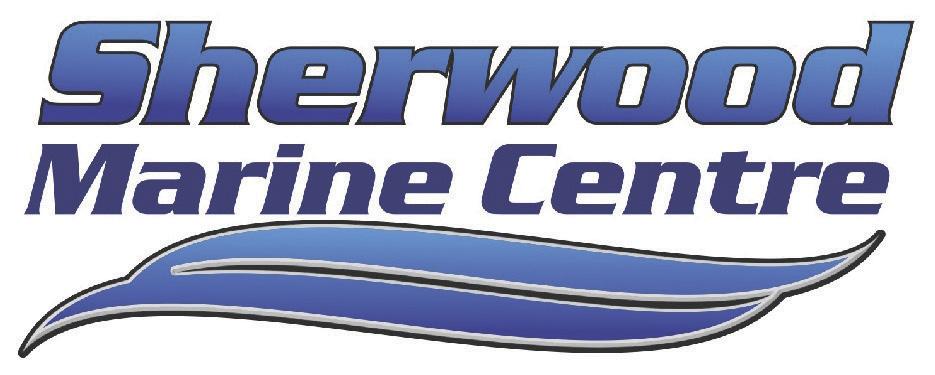




OVER













































This
If there’s one Labour Day weekend event that draws thousands of visitors to Victoria, it’s the Classic Boat Festival. The 2023 Festival will be held once again from September 1 to 3 in Victoria Harbour, right in front of one of Canada’s classic hotels, the Empress.

The idea for a heritage boat festival began in 1977. A group of maritimers had planned to build a replica of John Meares’ Northwest America to commemorate the 200th anniversary of Cook’s arrival in Nootka Sound, but the concept failed for lack of funding. So, the group instead organized the first Classic Boat Festival for the Labour Day weekend in 1978, in which 32 boats participated. The event included

a judge and an honorary commodore, beginning a tradition that carries on today. Except for two Covid pandemic years, the festival has been held ever since.
The honorary commodore this year is Captain Richard “Slim” Gardner who has been a classic boat enthusiast for decades. A resident of both Port Orchard, WA, and Gilford Island, BC, he’s participated in every major classic yachting event up and down the West Coast. The first classic yacht he bought was the 65-foot Consolidated (1937). More than 30 years ago, he bought his dream vessel, the 80-foot HoffarBeeching fantail Deerleap, which he restored himself in glorious detail. Gardner has brought Deerleap to every Victoria
Classic Boat Festival since 1999; she has won awards for Best in Show, Best Powerboat, Best Engine Room and the coveted Hospitality Award.
The festival officially starts at noon on September 1 with the arrival of the Maritime Museum of BC’s salute vessel Midnight Sun Deerleap will be on hand, of course. During the Classic Boat Festival, you can also meet the recipient of the 2023 Abernethy & Gaudin Young Boaters Scholarship, which encourages young boaters—under 30—to participate in the festival by covering the cost of their registration, moorage, a reception and a banquet. This year’s winner is Eden Murray who’s bringing China Cloud to the Festival. China Cloud is a 45-foot, three-masted junk-rig sailing vessel built by Allen and Sharie Farrell. They constructed her themselves on a Lasqueti Island beach with a hand saw and an ax. Eden and Hans Murray are restoring China Cloud and so she is sailing again 41 years after being launched. You might be able to have an on-board visit with Deerleap and China Cloud if you ask nicely.
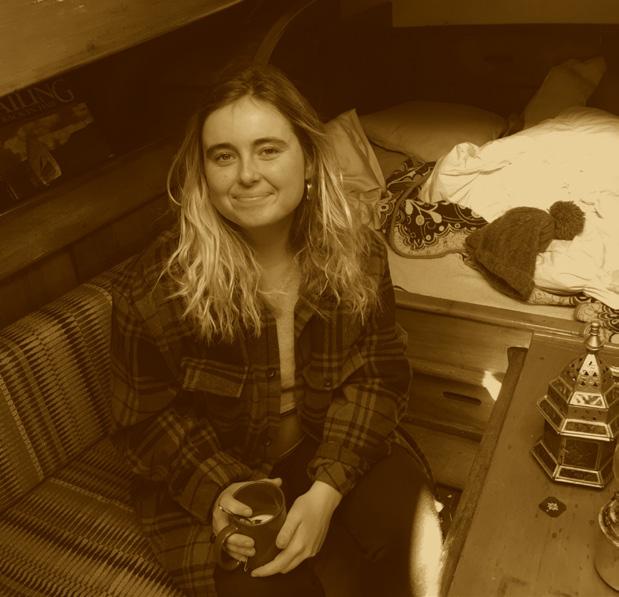




Entrance to the Festival is by donation.
—Marianne Scott
After 13 years in the marine business, Ian and Shari Macpherson and Lorraine Bell have sold and transferred ownership of the well-established Stones Boatyard and Marine Store and Nanaimo Yacht Charters and Sailing School. The new owners are a group of local businessmen, passionate boaters and long-time friends who are excited to build the establishment.
Equal partners in the endeavour include some well-known names on the island. Brothers Tony and Mike Harris of the Harris Group of Companies, which includes an auto group of eight dealerships that have been an integral part of Nanaimo for decades, as well as Tom Harris cellular which is the largest authorized Telus dealer in BC with over 50 locations. Ken Schley of Kelland Ventures was the founder and former owner of the successful Vancouver Island grocery chain Quality Foods and Andrew Babuin worked with Finning as an account manager
for more than 15 years. With new energy and vision for the future, this team plans on honouring and building upon the quality services that are already in place.
“Ian and Shari built a really solid business and we will continue to give customers that standard of care as we grow and evolve what we can offer to the boating community,” says Babuin, who will be the new general manager.

Babuin, a passionate boater, says it’s his dream to be working in the industry. “I’ve been around boats my whole life. It’s a passion and I love being around them all day. It feels so natural to be here.”
At Stones Marina, there is a fullservice boatyard and haul-out, along with the marine store and chandlery for boating equipment needs. Nanaimo Yacht Services and Nanaimo Yacht Charters & Sailing School offer chartering and sailing instruction. Long-time boatyard manager, Nick Webster, and a dedicated team of employees who have been with the companies for years will continue to work
“It’s a smart set up, everything is available to the boater,” says Babuin. The boatyard offers boat and general repairs, marine engine repairs, a boat hoist and one of the largest marine travelifts on the island. They also offer boat cleaning, detailing and bottom painting. The Nanaimo Chandlery has boating supplies on hand, including marine paints, polishes, cleaners, sealants, electrical supplies and more.
Nanaimo Yacht Charters and Sailing School offers charters in both power and sail. Their fleet features favourite cruising brands from 30 to 60 feet, including boats from Lagoon, Bavaria, Dufour, Beneteau, Jeanneau, Hanse, Catalina, Hunter and Bayliner.
Babuin says it’s a privilege to be able to offer services that legitimately help people. “Our crew is so good at what they do, we can have customers in and out as efficiently as possible so they can get out there and go boating, which is what we are all here to do.”
—Desiree Miller



We’ve got you covered with aluminum boats this season.
EVENTS
C&C Rendezvous
Telegraph Harbour Marina

August 4–6
Cow Bay
August 5–6
Maple Bay
September 2–3
CRASH
September 16–17
The summer isn’t over, but it’s not too early to start looking back at your summer cruising rendezvous. Our Summer Cruising Roundup feature is coming up in the December issue and we’d love to hear how you and your friends made the most of the cruising season. Information on rendezvous and boat meetups along with photos can be sent to editor@pacificyachting.com.
Deadline: October 15
Sidney, BC | 250-656-2639
INA MARINE Victoria, BC | 250-474-2448
INLET MARINE Port Moody, BC | 604-936-4602

LA MARINE Port Alberni, BC | 250-723-2522
LUND AUTO & OUTBOARD LTD. Lund, BC | 604-483-4612
MADEIRA MARINE 1980 LTD. Madeira Park, BC | 604-883-2266
M&P MERCURY SALES Burnaby, BC | 604-524-0311
MONTI’S MARINE & MOTOR SPORTS Duncan, BC | 250-748-4451
ROD’S POWER & MARINE LTD. Tofino, BC | 250-725-3735
SEA POWER MARINE CENTRE LTD. Sidney, BC | 250-656-4341
MERCURY 5.7L V10 350 AND 400HP
V10 Verado outboards shift your expectations performance feels like. They come to power, propelling you forward to sensational smooth, quiet and refined, they deliver only Verado outboards can provide.
VECTOR YACHT SERVICES LTD. Sidney, BC | 250-655-3222
Mercury engines are made for exploring.

SOMEDAY YOU’LL TELL YOUR LIFE STORY. ONE EXPERIENCE AT A TIME.
expectations of what high-horsepower to life with impressively responsive sensational top speeds. Exceptionally deliver an unrivaled driving experience exploring. So are you. Go Boldly.


Your best stories begin out here. Where the only thing ahead is the open ocean. And every day, is another chance to fill your memories with the trip of a lifetime.
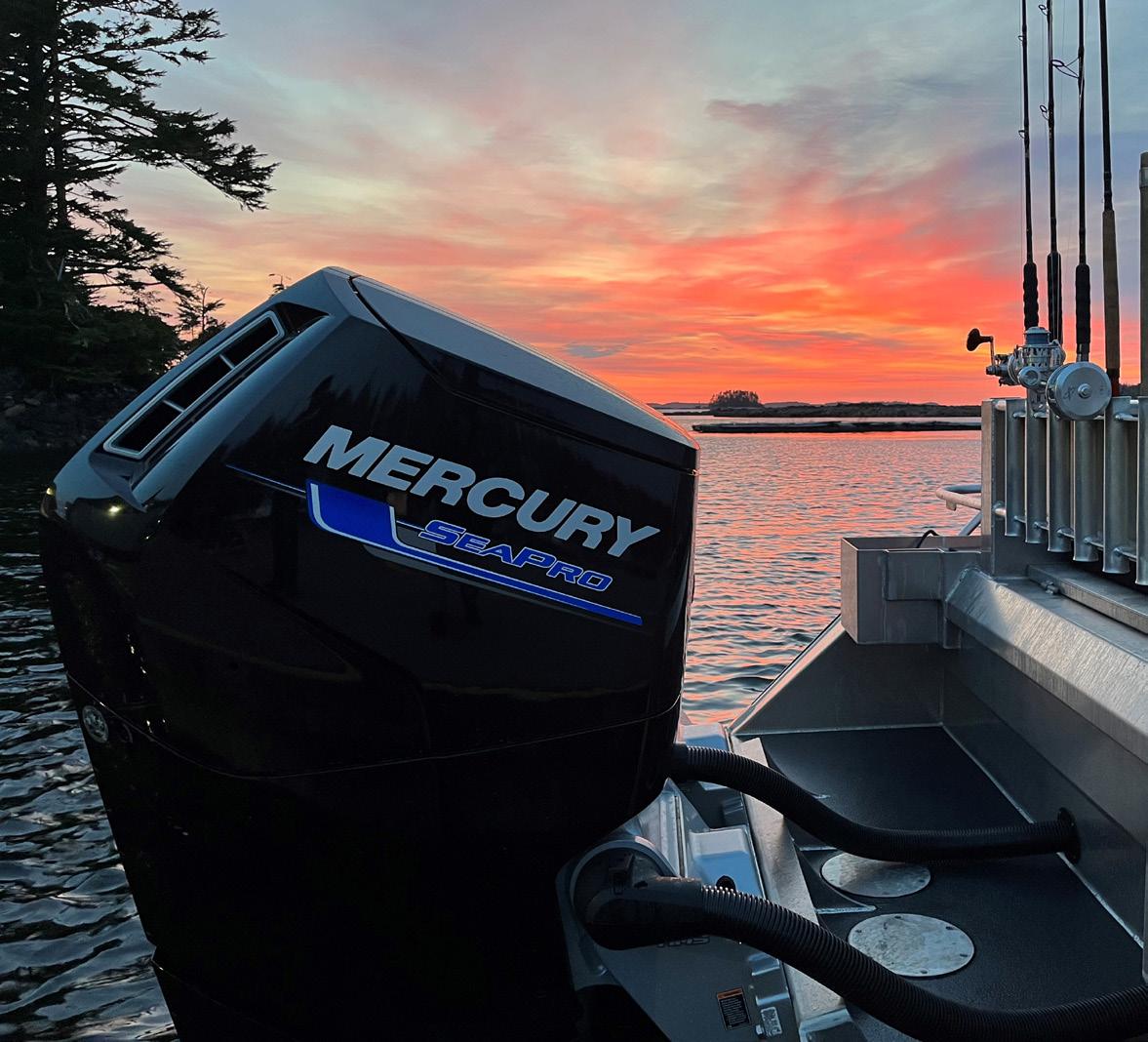



All Hands on Deck is a book about a boat, a movie and an international crew hired to sail Rose, the replica of an 18th century warship 5,000 miles from Newport, Rhode Island, to its Hollywood debut. The magnificent wood boat was the setting for the acclaimed 2003 film, Master and Commander: The Far Side of the World starring Russell Crowe as the roughly charismatic captain of a British frigate.
Rose, a full-rigged 180-foot ship with three masts, each carrying square sails and an intimidating matrix of ropes,

wires and spars, has a Canadian connection. It was built in 1969 in Lunenburg, Nova Scotia, the birthplace of the Bluenose II. That boat featured in the film called The Surprise, after the original iteration of the colonial-era warship was built in 1757, a rather apt name, since it was a total surprise it arrived at its movie debut on time! A dismasting in the middle of the ocean, pirate threats off the coast of Central America, electrical fires, water leaks, and a cranky crew all threatened the trip. Gale force winds launched the Rose off a massive wave, “like an elephant trying to fly.” Amazingly, no crew member was lost.
Author Will Sofrin was a 21-year-old boat builder and yacht racer when he was offered this once-in-a-lifetime job to join the well-respected tall ship captain Richard Bailey and his crew as a chipper (onboard carpenter).
When Sofrin first set eyes on the Rose, easily the largest ship in swanky Newport harbour, he writes as if it was a parking lot: “She was the beat-up school bus, covered in primer, with a piece of rope tying down the hood.” Chapter two is entitled “The Hells Angels of the Sailing World,” so you just know you’re in for a raucous read. Planet Tall Ship, as he nicknames the voyage, was a smelly and dirty event filled with oddballs and weirdos. For many in the crew, it would be the first time they had ever sailed a boat, much less a 500-ton tall ship. The route took them from Newport Rhode Island through two oceans, to Puerto Rico, Panama and Mexico, eventually arriving in San Diego in time to be prepared for its movie debut. Would they get to California for her Hollywood debut? The author’s voice is fresh and genuine as he relates the perilous journey. You

can smell the tar, grease, mildew, and the unwashed bodies of 29 men. (The eight women luckily had their own head). It boggles the mind to think in yesteryear the same sized ship would have been home for 200 sailors for years at a time.
British author Patrick O’Brien, on whose books the film was based said, “The essence of my books is all about human relations, how people treat one
another.” His popular books chronicle swashbuckling adventures, marine battles and the charming friendship between Captain “Lucky” Jack Aubrey and Stephen Maturin, physician, naturalist and British spy.
One quibble: some of the darker, fuzzier archival photos could have been digitally enhanced for greater impact. Other than that, this a thoroughly enjoyable well-paced story told by a seasoned sailor with a good eye, keen memory, and sense of humour. This book provides an up-close and personal look at the challenge for a modern crew to operate an historic vessel. Its detailed technical drawings and tables will appeal to the master mariner. The story will appeal to armchair sailors, movie fans and landlubbers who enjoy a welltold tale.
 —R. M. Davies
—R. M. Davies

Pacific Yachting’s annual photo contest is back! Don’t forget to get behind the lens this cruising season, and start submitting your best boating photos from 2023 for a chance to be featured in Pacific Yachting. Prizes will be announced in the next issue of Pacific Yachting! For contest rules and to enter, visit pacificyachting.com/photo-contest.
Deadline: December 15




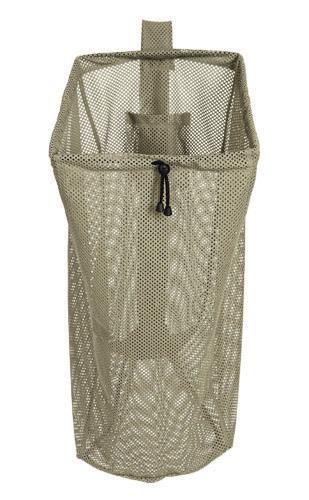



Fine

Well-known Axopar Boats has joined forces with Evoy, the Norwe gian manufacturer of fully electric inboard and outboard motor solutions for leisure and commercial marine uses. Axopar will take over 10 percent of Evoy and brings valuable expertise in boat building and an extensive dealership network worldwide.


Axopar plans to work closely with Evoy to develop easy to install, turnkey solutions in an effort to accelerate the adoption of electric technology in the boating world. Following the well-received proof of concept of the Axopar 25 Electric prototype, these two Norwegian companies plan to push the boundaries of what is possible in electric leisure boating. For more information go to axopar.com or evoy.no.
ANCHOR MARINE
Victoria, BC 250-386-8375
COMAR ELECTRIC SERVICES LTD
Port Coquitlam, BC 604-941-7646
ELMAR MARINE ELECTRONICS
North Vancouver, BC 604-986-5582
GLOBAL MARINE EQUIPMENT
Richmond, BC 604-718-2722
MACKAY MARINE
Burnaby, BC 604-435-1455
OCEAN PACIFIC MARINE SUPPLY
Campbell River, BC 250-286-1011
PRIME YACHT SYSTEMS INC
Victoria, BC 250-896-2971
RADIO HOLLAND
Vancouver, BC 604-293-2900
REEDEL MARINE SERVICES
Parksville, BC 250-248-2555
ROTON INDUSTRIES
Vancouver, BC 604-688-2325
SEACOAST MARINE ELECTRONICS LTD
Vancouver, BC 604-323-0623
STRYKER ELECTRONICS
Port Hardy, BC 250-949-8022
WESTERN MARINE CO
Vancouver, BC 604-253-3322
ZULU ELECTRIC Richmond, BC 604-285-5466
journey.
Never miss another target, from close-in to the horizon and beyond, with NXT technology.




With boating season in full swing, it’s important to stay on top of maintenance to ensure your adventures on the water are safe and fun.
• Inspect all around the hose clamps for rust and replace as necessary. Double clamp fuel lines and exhaust hoses with marine-rated stainless steel hose clamps. While not technically required, it’s wise to double clamp whenever possible on all hoses—especially those below the waterline.
• Inspect all hoses for stiffness, rot, leaks and cracking, and replace any that are faulty. Make sure they fit snugly.
• Inspect prop(s) for dings, pitting and distortion. Make sure cotter pins are secure.
• Grip the prop (on inboard drive systems) and try moving the shaft up and down and side to side. If it’s loose and can be wiggled, the cutlass bearing may need to be replaced.
• Check the rudderstock to ensure it hasn’t been bent. Operate the wheel or tiller to ensure the steering works correctly. Check the rudder bearing and steering cable for unusual play or movement.
• Inspect the hull for blisters, distortions and stress cracks.
• Make sure your engine intake sea strainer (if equipped) is not cracked or bent and is free of corrosion, clean and properly secured.
• With inboards, check the engine shaft and rudder stuffing boxes for correct adjustment. A stuffing box should leak no more than two or three drops each minute when the prop shaft is turning. Check the shaft log hose for deterioration and rusty hose clamps.
• Inspect, lubricate and exercise thru-hull valves. It’s a good idea to tie a right-sized wooden bung to the valve in case of failure.
• Use a garden hose to check for deck leaks at ports and hatches. Renew caulk or gaskets as necessary.
VISIT OUR WEBSITE TO SEE ALL OUR 15 LINES AVAILABLE WITH MORE THAN 180 MODELS FROM CENTER CONSOLES TO YACHTS.

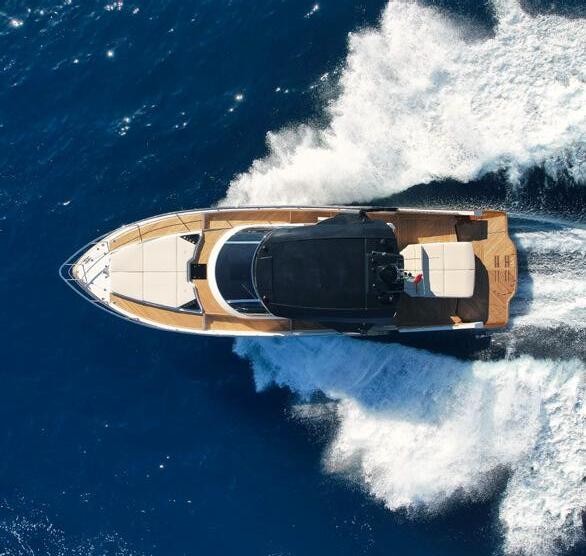




CONTACT US TO FIND A DEALER NEAREST YOU.
SEE THE INVENTORY SECTION OF OUR WEBSITE FOR MODELS AVAILABLE FOR PURCHASE TODAY!
• Inspect and test the bilge pump and float switch to ensure they’re both working properly. Also inspect the pump’s hose.
• Check stove and remote LPG tanks for loose fittings, leaking hoses and properly functioning shutoff systems. Use the pressure gauge to conduct a leak down test to check for system leaks.
• Inspect dock and anchor lines for chafe and wear.
• If equipped, ensure that the stern drain plug is installed.
• After the boat is launched, be sure to check all thru-hulls for leaks.


• Every few years, remove and inspect exhaust manifolds and risers for corrosion (for inboard-powered and inboard/outboard boats).
• Inspect fuel lines, including fuel tank fill and vent hoses, for softness, brittleness or cracking. Check all joints for leaks, and make sure all lines are well supported with non-combustible clips or straps with smooth edges.
• Inspect fuel tanks, fuel pumps and filters for leaks. Ensure portable tanks and lines are completely drained of stale fuel before filling with fresh fuel. Clean or replace fuel filters and/or fuel-water separators if not done before winterization.

• Clean and tighten electrical connections, especially both ends of battery cables. Use a wire brush to clean battery terminals, and top off cells with distilled water (if applicable).
• Inspect rubber outdrive bellows for cracked, dried and/or deteriorated spots
(look especially in the folds) and replace if suspect.
• Check power steering & power trim oil levels.
• Replace anodes/zincs that are more than half wasted.
• Inspect the outer jacket of control cables. Cracks or swelling indicate corrosion and mean that the cable must be replaced.
• Inspect swage fittings for cracks and heavy rust (some discolouration is acceptable). Inspect wire halyards and running backstays for “fishhooks” and rust.
• Remove tape on turnbuckles and lubricate threads, preferably with Teflon. Replace old tape with fresh tape and ensure that water is able to freely drain from it.
WJuly 22, but whenever you drop your pot this summer, there’s a good chance it will fill with Dungeness crabs. Their sweet, mild meat makes them one of the five best-loved crabs in the world, prized by professional and home chefs up and down the West Coast.
male “dungies” grow to 23 centimetres (nine inches), weigh up to one kilogram (2.2 pounds,) and live eight to 10 years. They thrive in cold, nearshore waters from Alaska to Santa Barbara, California.
What has been around longer than the dinosaurs, has 4,500 cousins, its own constellation and tastes like a slice of heaven?
Cancer, the sign of the crab, reigns in the heavens only from June 22 until

Their relatives range from midgets the size of a thumbnail to Japanese spider crabs who weigh up to 19 kilograms (42 pounds,) measure up to 0.4 metres (16 inches) across, and live to be 100 years old. Most live in the oceans, but some in fresh water and some on land. In comparison, adult
Large and small, at every stage of their lives, crabs are a favourite food of other species. So, how have they managed to survive all this time? Here are some crabby facts that may contribute to their success:
In our area, crabs are omnivorous, so a shortage of one type of food does not affect them. Plants and animals



Spend your time being there not getting there, with quick and convenient flights connecting across B.C.’s coast and Seattle. Award-winning service, flexible fares, and unmatched frequency to the locations you love, flying with Harbour Air is simply the best way to travel the West Coast. Wherever you want to be, we can get you there.

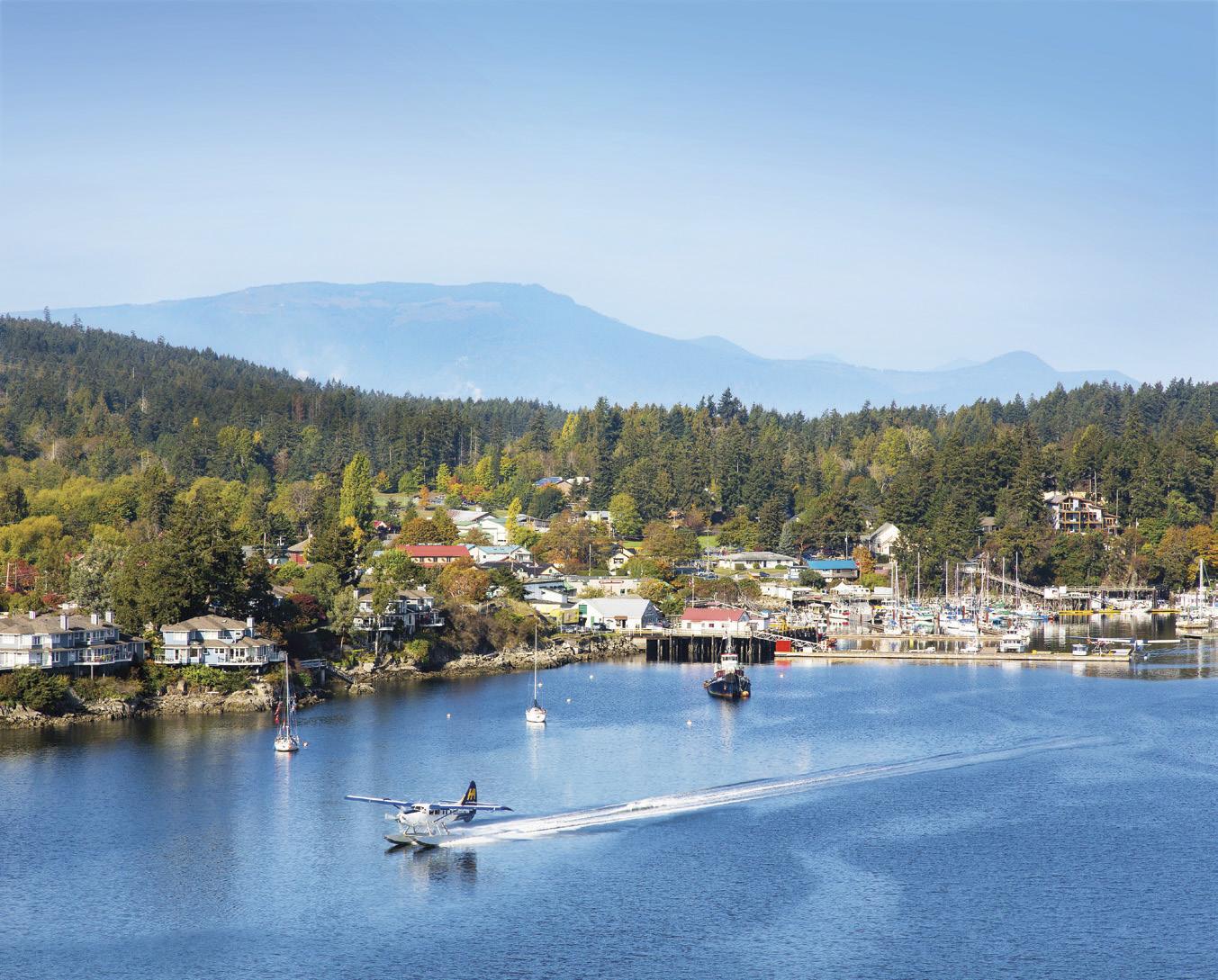

alike, if they’re available, a crab will gobble them right up. Also, they have learned to hide from predators by burrowing in the sand after molting, when their shells are soft and they are most vulnerable. But I suspect that the biggest reason is that they produce a prodigious number of offspring. A mature female can lay up to 2.5 million eggs at a time and she can store sperm and use it to fertilize a second batch of eggs later.
Adults generally molt once a year, between May and August, and they mate as soon as the female sheds her shell. She stores the sperm until fall, when she extrudes the eggs, which she carries on her abdomen for three to five months. In this phase, you may see a spongy orange material under her carapace. Those are future crabs, and they’ll be ready to eat in five or six years. As time goes on, the embryos consume the yolks, causing the orange to fade to brown.
When the eggs hatch, the offspring, called zoea, look nothing like their parents. From winter until spring, these long, skinny, microscopic larvae drift in the water, eating even smaller algae and larvae. By spring, their bodies have grown wider and started to develop legs.
At this stage, they are pea-sized megalopes. They continue to drift in the water until late spring or summer when they become juvenile crabs.
As juveniles, they avoid adults, who would be happy to eat them, and seek shelter in aquatic plants, pilings or debris. They prefer estuaries or other areas where the salinity is low and the current sweeps food to them. For two years, they grow rapidly, molting up to six times a year. Then their growth slows, their shells harden and they become adults.
Over the years, we’ve harvested a lot of Dungeness crabs. Of course, we
throw the females back, but at times we’ve pulled up our crab pots and been tempted to guess at the size of the males. However, the smaller-than-legal size males are responsible for most of the mating and reproducing, so it’s important to use a proper gauge and measure accurately. Also, we’ve been fooled by a teenager or two dressed up in dad’s tuxedo. If the shell is soft, even though it measures the correct size, it has recently molted and the crab is not actually as large as it looks. Reluctantly, we throw them back. It’s up to us to ensure that these creatures don’t go the way of the dinosaurs.
Proper gear can also help to ensure survival. We’ve lost a few crab pots. Some, I’m sure were stolen, but it’s possible that others drifted to a deeper spot and we simply couldn’t find them.
According to a report published in 2012 by Washington State University Snohomish County Extension staff, each year, a whopping 12,000 pots end up on the bottom of Puget Sound. They estimated 178,000 harvestable male crabs were trapped and died in these pots. Crabs are cannibalistic. Dead and dying crab become food for those already in the pot and act as bait to attract others. If the pots had been tied with biodegradable escape or rot cord, the cord would have broken down in two or three months and the living crabs could have escaped.
Eventually, they might have landed on our table as cracked crab dipped in melted butter, crab Louie, crab tostada or crab omelet. They might have made a splendid “docktail” party dish, served hot or cold, heaped in a hollowed-out bread or pretty bowl and surrounded by crackers or grilled baguette slices.
This August, may the sun shine, may your cruises be long and merry, and may your pot come up full of large, male Dungeness crab.
• 8 ounces crab meat
• 4 ounces softened cream cheese
• 2 tablespoons sour cream
• 2 tablespoons mayonnaise
• 1/3 cup grated cheddar or Swiss cheese
• 1 teaspoon Old Bay seasoning
• 1 1/2 teaspoons fresh squeezed lemon juice
• 1/4 – 1/2 teaspoon hot sauce
• 2 tablespoons minced chives or green onions
• Salt and pepper to taste
Optional
• 1 – 2 cloves finely minced garlic
• 1 teaspoon Worcestershire sauce
1. Preheat oven to 175° C (350° F)
2. Mix all ingredients except crab and chives or green onion.
3. Beat until fluffy.
4. Gently stir in the crab and chives or onion.
5. Place in oven-safe dish.
6. Bake for 20 minutes or until heated through.
7. Garnish with chopped parsley or chives.
8. Serve hot, cold or at room temperature.



 BY PETER VASSILOPOULOS
BY PETER VASSILOPOULOS
Igrown up, we decided to suspend the rest of our travel plans and stay in Vancouver for a while.
In the early 1970s I joined my wife Carla on a trip through Canada with the intention of travelling across the Pacific. But when we stopped in Vancouver in 1973 for her to show me where she had
While enjoying the stop in Vancouver I was taken with boating on the coast and very soon I found myself linking up with friends who offered to show us the coast aboard their classic yachts and it soon turned into my writing about the classic boats as articles for Pacific Yachting. They were featured regularly in the magazine and after a while I took the collection of articles and created
my first book, which I called Antiques Afloat. Meanwhile I began writing powerboat reviews and a regular powerboating column which we called POWER PITCH.
In 1974, Carla and I bought a 34-foot converted fish boat that we called Balladeer and we lived aboard it for a while in False Creek. With our liveaboard boat we began to do cruises almost every weekend, and throughout the year we went boating for longer periods, linking up with other boat own-
ers and suppliers and visiting places on the coast that were becoming popular destinations. We began our boat trips by doing many visits to Howe Sound, Indian Arm and then across the Strait of Georgia to the Gulf Islands and Vancouver Island. I had owned a small runabout in Cape Town, where I grew up, and had spent many years zipping about along the coast, so boating in a variety of sea conditions was nothing new to me.
In the process of boating and writing up articles on new boats, we made close friends with many people. One couple we met, Walt and Rita Lee, became extremely close friends and we spent many happy days aboard their boat. In 1981 they asked if they could follow us in our circumnavigation of Vancouver Island, a trip we had done previously and were planning to do again. They
and another couple joined us in their boats for the trip, and we spent three weeks travelling up the Inside Passage, going around the north end of the island and then down the west coast. We made a point of spending time at places such as Port Hardy, Winter Harbour, Kyuquot and Zeballos, Tahsis, Friendly Cove, Clayoquot Sound, Barkley Sound, Port Alberni and Port Renfrew before continuing to Sooke and on past Race Rocks to Victoria and back home to Vancouver.
Our boating travels continued through the years and we covered more and more of the coast. To do so more efficiently, and faster, we sold Balladeer, moved into a house and bought a Monaro 27 that had twin engines. Its faster speed and rough-weather hull made the longer trips more comfortable. It was these trips up the coast that enabled me
to write more for Pacific Yachting and also to create a series of boating guidebooks. To enhance those books I was invited by flying friends Heinz Bold and Ray Roussy to accompany them in their private planes to take aerial photos for my books.
Over the years, our association with Pacific Yachting enabled my wife and I to enjoy the entire coast of BC and I was able to accurately describe places I wrote about because I’d visited them—usually on more than one occasion. My time associated with Pacific Yachting brought me to boat shows and other special events, including running the PY boats during sailing races. In addition to attending the local boat shows in Vancouver, Victoria and Sidney, we attended many other events with PY and I also did talks at various boating organizations including yacht clubs and boating associations. Carla and I enjoyed the many visits we made to the marinas on the coast, socializing with the owners and visitors. Our affiliation with PY is a most memorable part of our times in British Columbia.



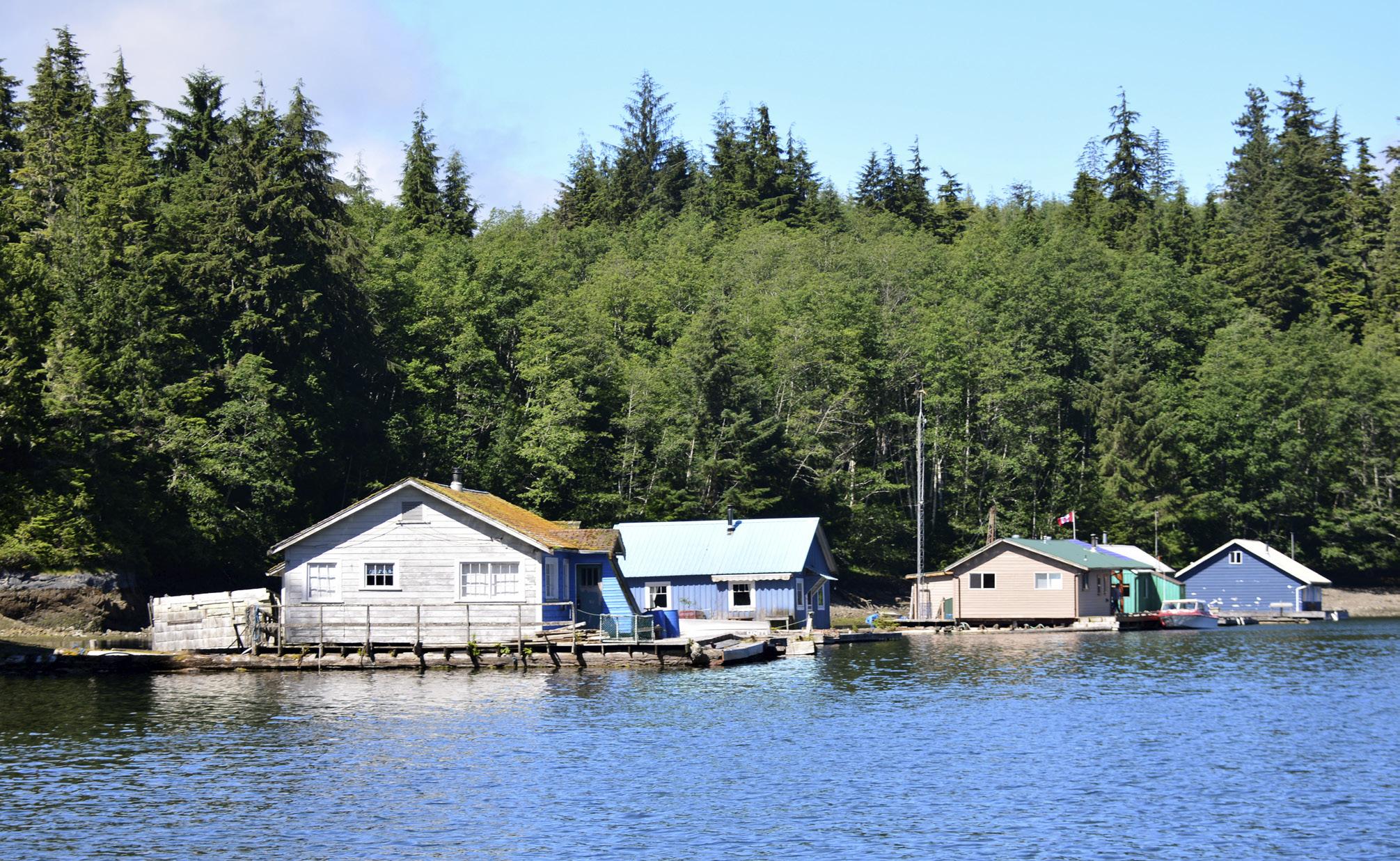
After spending most of the morning transiting Beware Passage and then looking for pictographs on the cliffs surrounding the abandoned Karlukwees Village, we crossed Clio Channel to Potts Lagoon for a leisurely afternoon of relaxation in the warm summer sun.
ABut first, we set the prawn pots in Clio Channel outside the entrance to the lagoon. Reviewing the chart, the area didn’t look all that promising, a little shallow with no structure on the sea floor, but sometimes you just need to take a chance and hope for some luck. The plan was to pick up the traps the next morning as we departed for our next destination.
THE PASSAGE LEADING into the basin, between West Cracroft and Kloaitsis islands, is wide and deep with a few wellmarked rocks to starboard and the remains of a logging and boom operation
to port. The narrow passage lies straight ahead and leads into the main basin. It is shallow with patches of kelp so caution should be taken. Potts Lagoon itself presents no threats to boats seeking shelter. The lagoon offers a landlocked and secluded anchorage in the lee of a small island marked “41” on the chart. Depth here is 15 feet over a good holding mud bottom. This scenic anchorage is safe in all winds, although westerlies can occasionally sneak around the small island. The bay is open and a half dozen floating homes and a decaying wharf overgrown with salal and small trees occupy the southern shoreline.
The remains of the wharf are home to salal and small trees.


The lagoon gets its name from the first homesteader, an Ontario student of “practical science” named Murray Clark Potts. In 1910 he established a farm adjacent to Coho Creek. Potts lived here until 1946, when he moved to Alert Bay.
Guarded by a small set of reversing rapids beyond the navigable depths of the lagoon, you’ll find an expansive marshland, which makes for excellent dinghy or kayak exploration. The remnants of the Potts homestead and logging operations make for an explorer’s delight. Explorers also must beware; this is a drying marsh and therefore don’t linger too long or you will find yourself high and dry. Note that in the summer bears have been seen feeding on the area’s berries.
ON THIS VISIT we discovered several boats were already tucked in behind the small island and the balance of the basin was peppered with crab floats, so we opted for the east basin. The approach into the northeast part of the bay is unobstructed with 30 feet of depth at low water. The basin is very well protected from any potential weather except for westerlies, during which some chop may curl around the point. The shore is lined
with old man’s beard hanging from the limbs of the trees. But best of all, this secluded little haven was void of boats allowing us to have it all to ourselves—sweet! We positioned Easy Goin’ as close to the southern shore as possible to be in the lee of the point should the summer westerlies happen to kick up. It was nearing low tide and we set the hook in 12 feet of water over a good holding mud and shell bottom.
AS THE AFTERNOON warmed and the sun made an appearance, so did the flies, biting ones, and a few yellow jackets. It was time to pull-out the repellent. For us, a must for travelling these parts in the summer.
The balance of the day was spent, as planned, relaxing in the warm afternoon sun and taking in the surroundings. This tranquil little basin is undeveloped and has room for two boats to swing on the hook. We spent most of the afternoon watching a pair of bald eagles building a nest in a tall snag located at the water’s edge.
Later, as we were sitting on the bridge enjoying the summer evening, a nearly full moon rose over the cedar trees, reminding us of portions of a wonderful book entitled Full Moon, Flood Tide by Yvonne Maximchuk and local legend, storyteller and historian, Bill Proctor. The book pays tribute to the loggers and fishermen who wrestled a living from the forest and sea in the area.
The following morning, after a hearty breakfast and a discussion on what a beautiful evening it was, we
weighed anchor and slowly guided Easy Goin’ out of the lagoon toward the first prawn pot. The pots didn’t yield the bounty we were hoping for, but we did have enough to make appetizers for that evening’s happy hour.
Chart: 3545
Entrance: Main
50.33’83 N
126.27’58” W
Anchorage: Main Basin


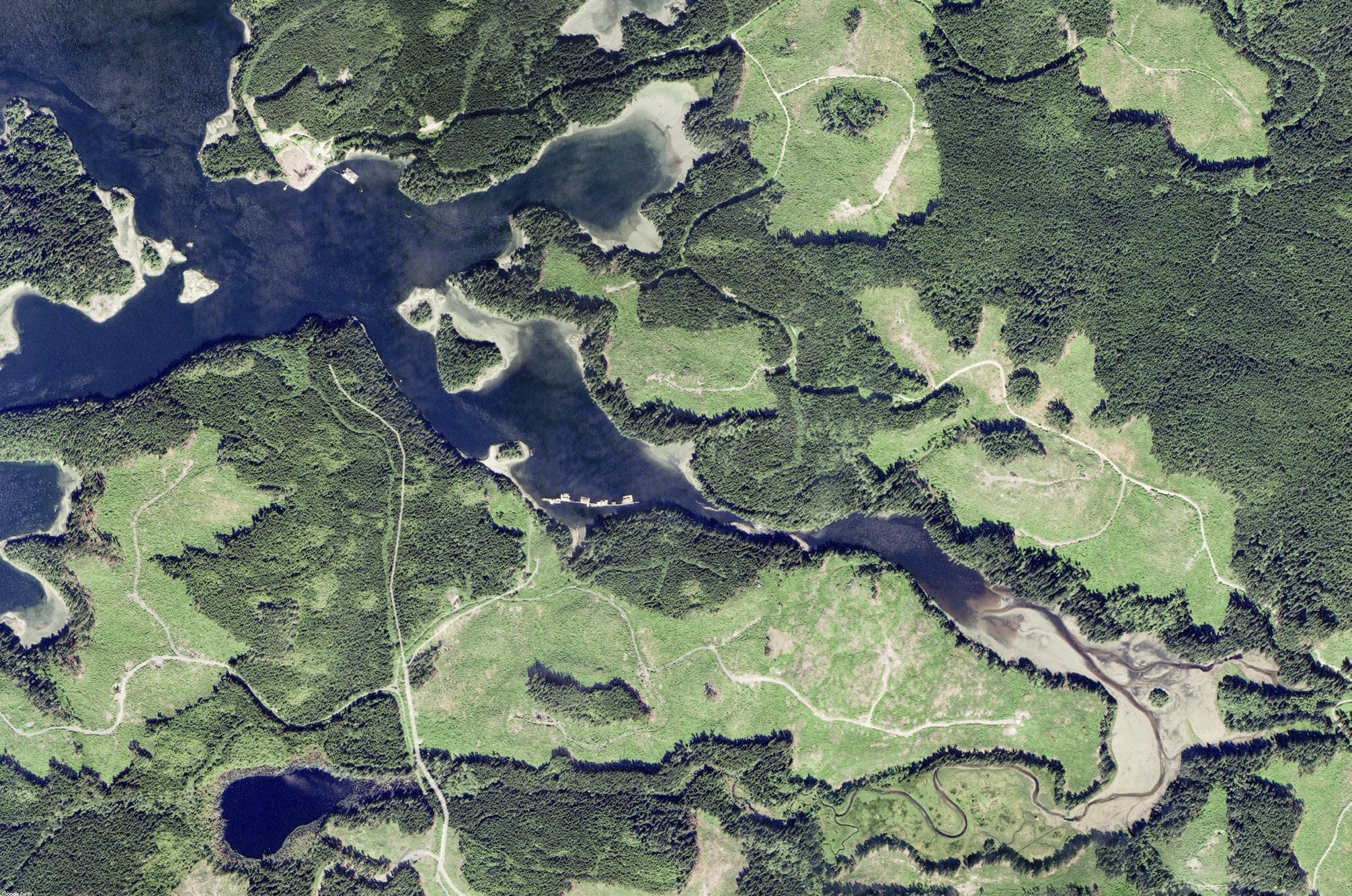
50.33’58” N
126.27’09” W
Nearest Marina:
Eelgrass beds are sensitive habitat


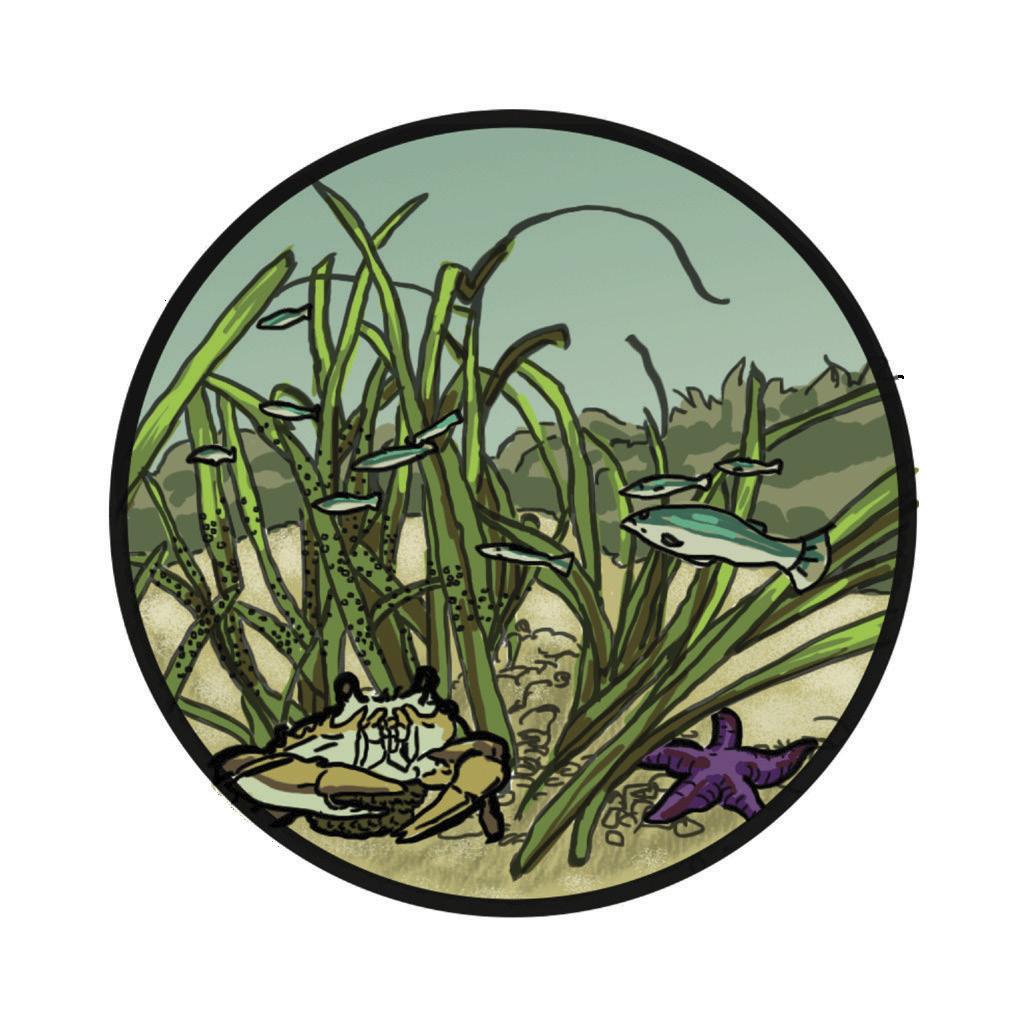







Here’s an off the beaten track destination with lots of appeal. Like most appealing ideas, however, there are challenges. Most boaters circumnavigating Vancouver Island may not want to detour at Winter Harbour and head up Quatsino Sound to Neroutsos Inlet in order to tie up at Port Alice, a detour of approximately 31 miles. But why not? For skippers with an endless cruising season on their hands and a comfortable vessel to while it away on,

taking the slow boat to Port Alice and joining the humpback whales there might just be the perfect extension. This well-planned village hunkers at the end of the inlet, abutting remote and untravelled waters; the perfect destination for boaters who are tired of the well-travelled waters of the Salish Sea and who really, really want to get away from it all. Quatsino Sound and Port Alice may not be the easiest places on the coast to get to by boat but isn’t that part of the charm? Boaters could arrive there by way of Cape Scott after an Inside Passage trip around the north end of Vancouver Island. Or they can
cruise from Victoria up the west side of the island, visiting Barkley Sound, Tofino, Hot Springs Cove, Friendly Cove and other delightful stops along the way.
So, intrigued at the thought, we check things out. There’s a public port facility at Jeune Landing on Neroutsos Inlet that includes a wharf, a float and a very long approach but although it’s close to Port Alice it’s difficult to access the community from here. The Rumble Beach Marina is much better. It offers ample moorage when
we visit in mid-October and it is an ideal nautical base, offering moorage for vessels up to 100 feet. A wellmanaged municipal facility, it offers garbage disposal, drinking water, public washrooms, pay showers, laundry facilities, a fish cleaning station and proximity to the expansive Lions Park with its launch ramp and playground. There is no pump-out, power or gas dock but boaters can have fuel delivered to the dock from April to September by prior arrangement with Port Alice Petroleum: 250-284-3530.
“Yes, we are the preferred marina
for launching for many boaters,” the village’s admin assistant and deputy CAO/CFO, Tanya Spafford, tells us. “Most boats are trailered in, so the fact that our road is fully paved and the boat launch is right there is a benefit.”
The fact that the marina is perfectly located for exploring the village and its environs as well as having the best view imaginable, looking over the inlet and surrounding mountains is another plus.
Audie Tamburini, a long-time local, is marina manager and he can be reached at 250-209-2665 in season
and 250-284-3391 the rest of the year. It’s first come, first served, but even in the busiest times the docks have always had room for boaters. “We have room to raft up if needed but have not had to do this to date.”
There is also a yacht club dock with the usual reciprocal agreement, but it is a small club and the space is often full. Spafford says that it does not have room for the larger boats that come in off the water.

What does this village of 700 offer? There are plenty of attractions and
most of them are near at hand. In season, the busy community centre offers exercise classes, yoga and other activities. The three-kilometre seawalk, built 25 years ago, is a great place to stroll, bird and whale watch and walk the dog while following the shoreline. Benches, picnic tables and informal signs all offer opportunities for lingering.

GOLF ANYONE? A nine-hole golf course built near the old mill site (still in the process of being dismantled) promises to give golfers one heck of a workout, built as it is on the side of a mountain. (This course was once featured in Ripley’s Believe it or Not because of the church, St. Paul’s Anglican, that was built on the seventh hole.) The course was opened in 1927 and the church came one year later, possibly with the hopes of increasing the congregation. Guess it didn’t work as the church was dismantled in 1967. The course is open year-round and the clubhouse opens 10:00 to 15:00 in the fall.
BESIDE THE VILLAGE office is a small heritage centre crammed with history, photos, memorabilia and great views of the inlet, which was routinely sliced by humpback whales during our visit. Spafford tells us the humpbacks have become regular visitors. “Our tourism centre is at the community centre and we have taken a variety of heritage info to share there as they are open seven days a week during the summer.” This is where I get very up close and personal with a cougar—an encounter I am happy to have under these circumstances.
We also find a well-stocked grocery store close to the marina, as well as a coffee shop and liquor store, and Spafford waxes enthusiastic about





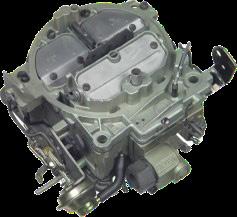












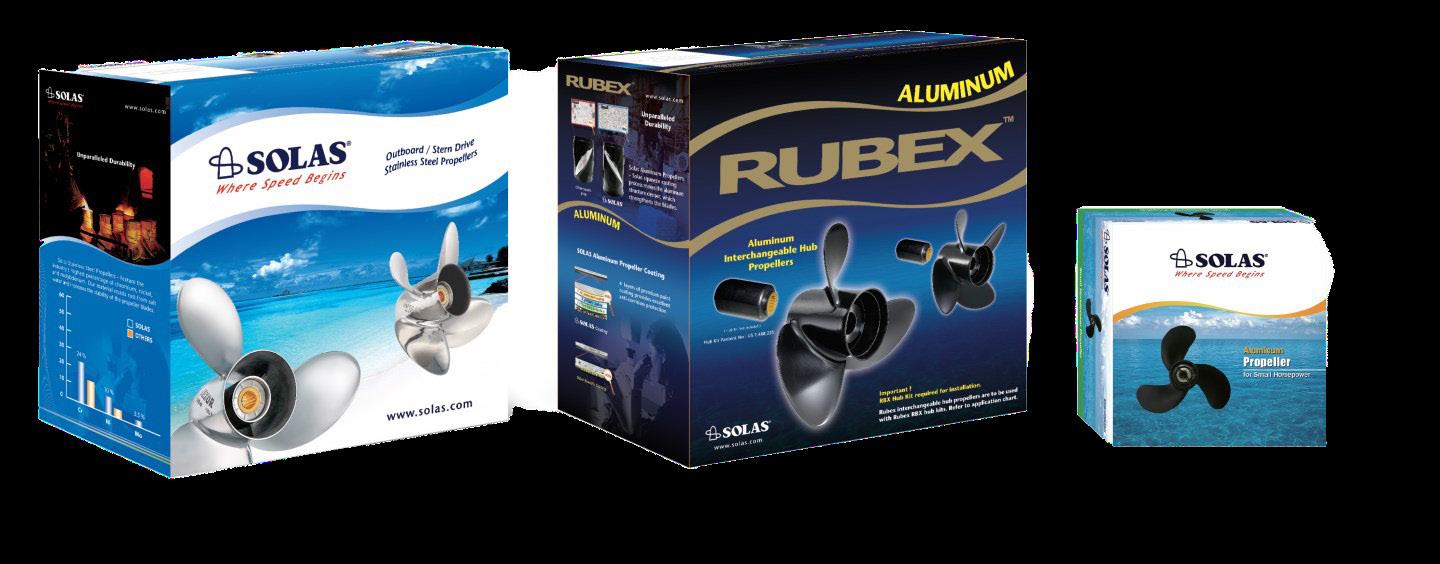





the new kid on the block which hadn’t arrived when we were there: “Since last fall we have enjoyed the addition of a food truck at the marina! McWilkies is open Wednesday to Sunday and serves delicious fish and chips, a variety of burgers, pulled pork options, poutine and a variety of other yummy options.”
WITH THE ENTIRE inlet and its beaches and gunkholes to explore, along with the profusion of sheltered inlets in Quatsino Sound to visit via canoes, tenders, kayaks or mother ship, what else do boaters need? “Kayaking, canoeing, fishing and wildlife viewing are popular activities in the sheltered waters of Neroutsos, Holberg and Rupert inlets and Quatsino Sound is a very popular sea kayaking route, served by a campground in the estuary. You could spend weeks exploring the waters here,” Spafford enthuses. She says they see about a dozen sailboats a year come in on average. “But this number grows a bit each year. It is a great spot to wait out weather, have a hot shower, get some laundry done and stock up on supplies. As well, many take advantage of free wifi and computer use at the library and community centre. Every service is within walking distance, so this is a highlight and I believe it’s why we are seeing more boats each year with word spreading. We are also now part of the BC Marine Trail system that can be seen on the Backroad Map books that lays out the paddling sites for boaters. This is going to be called the Cape Scott Marine Trail.”
There is another way of exploring Port Alice and Neroutsis Inlet—just ask veteran boater and writer, Peter Vassilopoulos. In his popular cruising guide, Adventures on the West Coast of Vancouver Island, he points out the benefits of trailering a smaller boat;
something that had not been on my radar until recently.
The road is paved right to the boat launch and secure parking for a fee is available nearby, but if boat haulers want to cut out those last narrow and winding 30 kilometres on Highway 30, Vassilopoulos suggests launching at Coal Harbour at the eastern extremity
of the sound instead. Just west of Port Hardy, there is a launch ramp giving access to Quatsino Sound. From there it’s a short distance to Port Alice.
We leave the village with a list of places selling boat trailers. We’ve got the bead on one that just could work with our 25-footer. I like to think that you’re never too old to go wild.
Located within the traditional territory of the Quatsino First Nation with the Nuuchah-nulth likely inhabiting the area even earlier, Port Alice emerged with the 1918 construction of its first pulp mill by the Whalen Brothers who named the site after their mother, Alice. Spurred by the demand for cellulose products during the First World War, 60 acres around the mill were cleared for homes and other community amenities. Regular visits by the Princess Maquinna and Princess Norah provided transportation and necessities. In 1965, Port Alice became the province’s first instant municipality when the town was moved from the mill site to its current location at Rumble Beach, five kilometres north. In its heyday in the 1970s, a community centre, firehall and hospital were built and in the 1980s 2,000 people lived here.

In 2015, after several changes of ownership, the mill closed for good and a huge dismantling and remediation is still underway.
The curious name of Neroutsos Inlet originates from master mariner, Cyril Demetrius Neroutsos (1868–1954), whose vessel serviced the area for many years. He was marine superintendent of the CPR’s coast service.
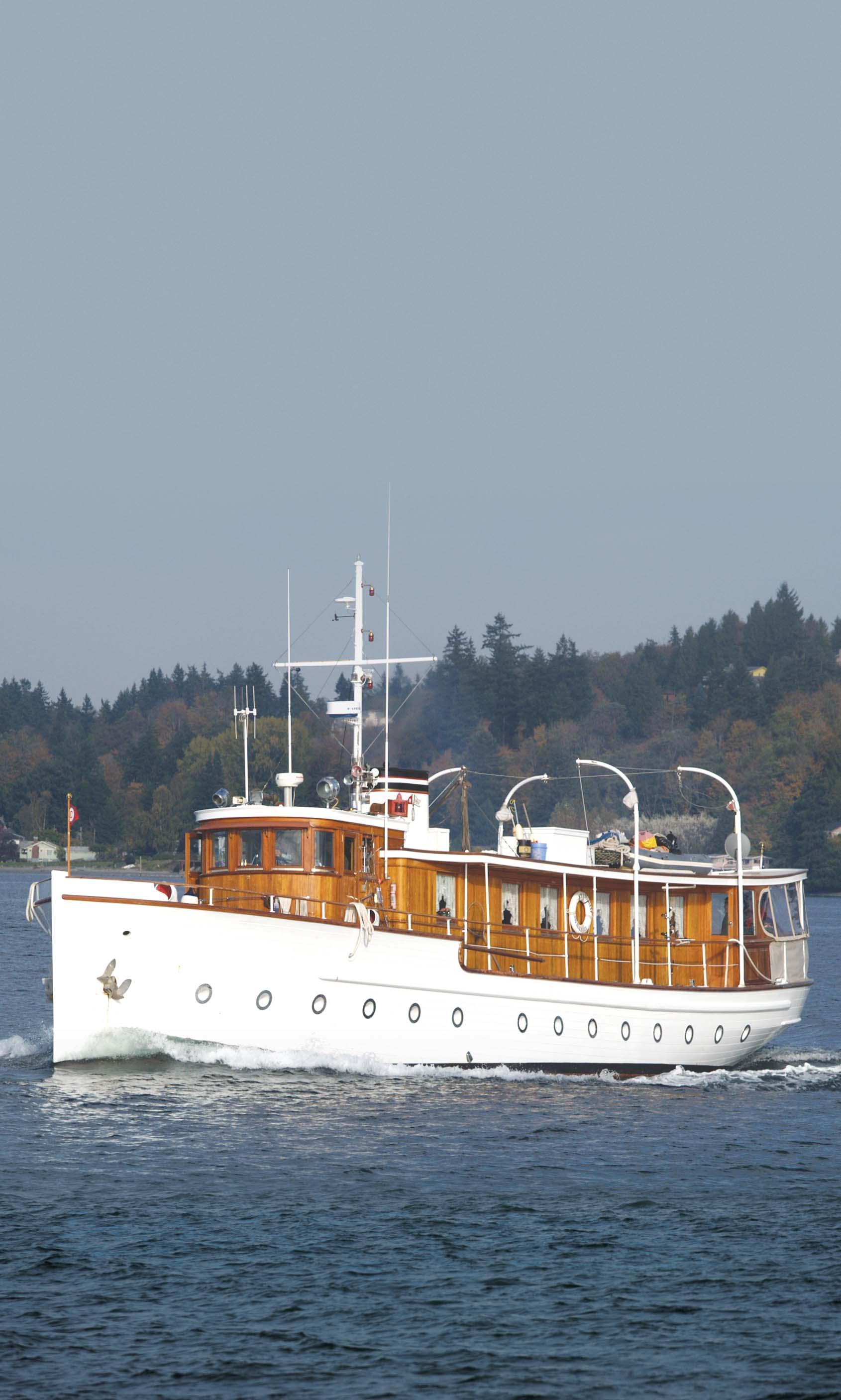
At age 126 and as Canada’s oldest wooden sailboat in continuous

use, Dorothy is a symbol of our nation’s maritime heritage
 By Marianne Scott
By Marianne Scott
On the trailer, a gleaming 30-foot wooden yacht, Dorothy, awaited a launch into her natural habitat— saltwater. She sported a temporary, short mast festooned with signal flags and a sizable Maple Leaf fluttering from the top.
At the venerable age of 126, Dorothy is the oldest wooden sailboat in continuous use in Canada. Before her launch, she’d spent 10 years with Gabriola Island shipwright Tony Grove and a year with boatwright Robert Lawson and his fellow volunteers at the Ladysmith Maritime Society (LMS) getting ready for this momentous moment.
Before the yacht kissed the briny, Jamie Webb, president of the Maritime Museum of BC (MMBC), which owns Dorothy, welcomed the crowd of 300 there to witness the event. “Dorothy was first launched on July 26, 1897, or 45,961 days ago,” he said. “And today, we are re-dedicating her in her 126th year, after 10 years out of her proper element.”
He then recited a poem he wrote to honour the little ship:
From the board of Linton Hope, Wood and oak and tar and rope, Crafted by the Robinson crew, Through regattas Dorothy flew. With skipper Langley’s loving care, Collecting piles of silverware. Through generations’ hands she passed, Arriving at this day at last. A bubbling wake in her trail. She’s ready to spread her wings and sail.
FOR THE RE-DEDICATION, Webb introduced Carol Bertram, the greatgreat-granddaughter of boatbuilder John J. Robinson, who constructed the yacht in his Victoria Harbour/James Bay boatyard in 1897. Bertram hopped between the trailer beams, bottle of champagne in hand. “I re-dedicate this ship, Dorothy, and we ask for blessings upon her, and all who sail her,” she declared and smashed the bottle against the bob-stay ring on the sailboat’s stem.
The audience watching from the parking lot, the red-painted government dock and floating dinghies gave three cheers. The truck then gently lowered Dorothy down the ramp into the Salish Sea.
In 1892, British yacht designer Linton Hope, an avid racer and later winner of two gold medals in the 1900 French Olympic Games, drew a single-handed cruiser, Dorothy, for a client called E. Gould, Esq. According to Ladysmithbased chronicler Robert Lawson, who’s vigorously researched the sailboat’s history and scrutinized pertinent documents and artifacts, the first Dorothy was built at Hope’s Thames Yacht Building Company in 1894. She still exists although in altered form.
HOPE SUBSEQUENTLY PUBLISHED Dorothy’s drawings in the 1895 edition of Dixon Kemp’s Manual of Yacht and Boat Sailing. That’s where Victoriabased William H. Langley, who was looking for a fast racer that would beat his competitors, found Dorothy’s
ON MAY 27, 2023, A STOUT TRUCK IN REVERSE GEAR GENTLY PUSHED A BOAT TRAILER THROUGH THE LADYSMITH FISHERMAN’S WHARF PARKING LOT.

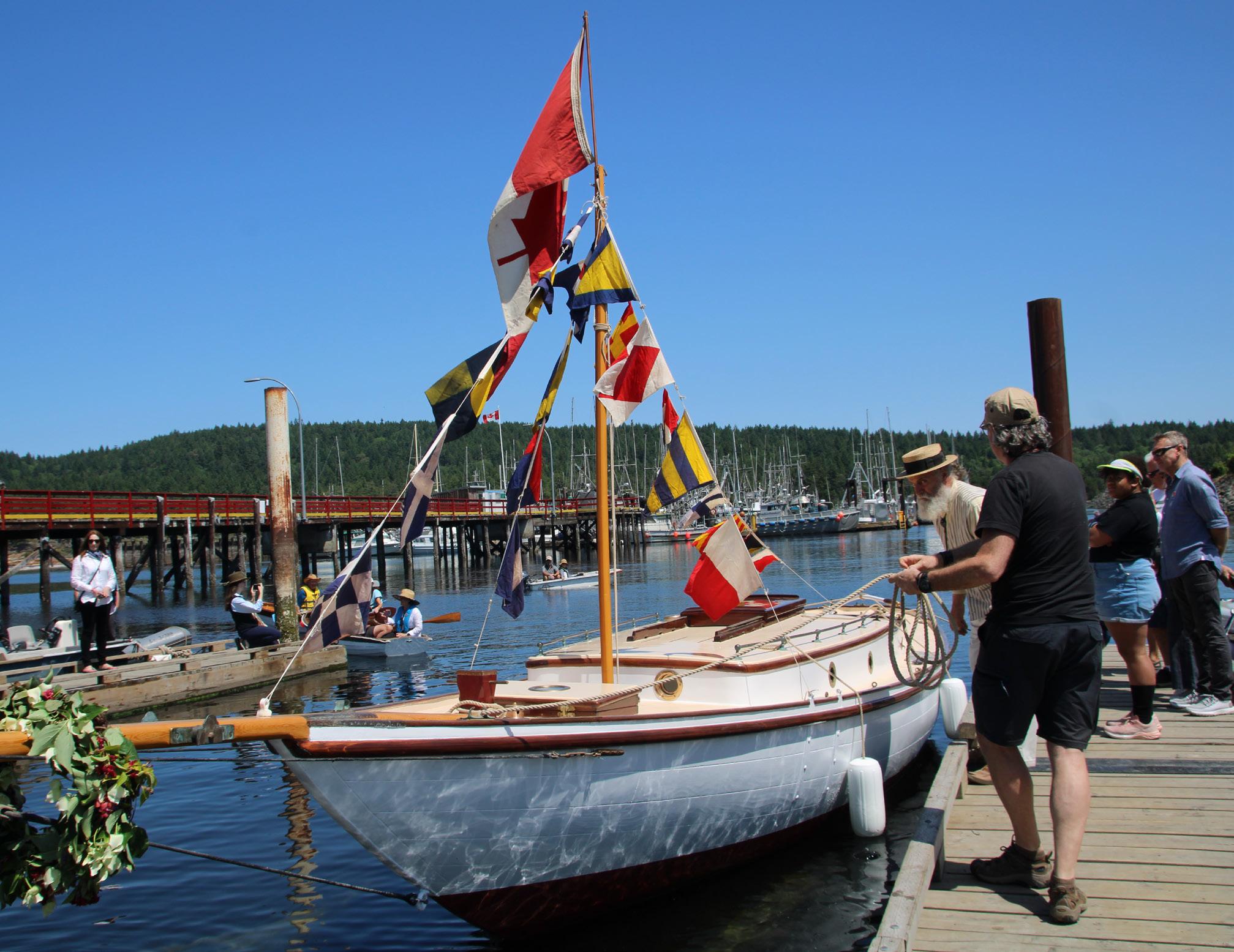
 Dorothy sporting a temporary mast on her much anticipated return to her natural habitat—saltwater.
Dorothy sporting a temporary mast on her much anticipated return to her natural habitat—saltwater.





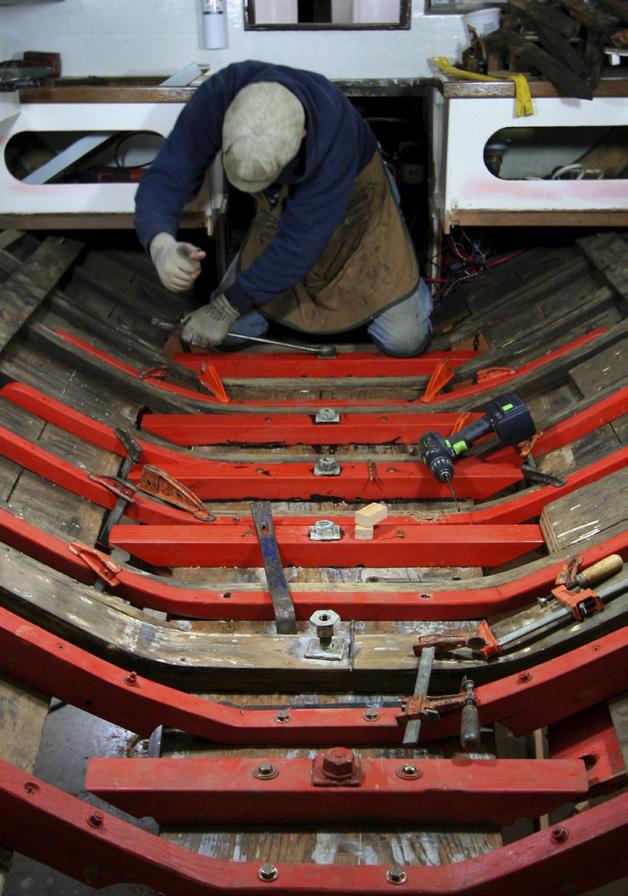
 1. Tony Grove pounding in the cotton. 2. The new garboards with bungs. 3. The new wood for floor timbers and sistered frames have been painted with red lead primer.
1. Tony Grove pounding in the cotton. 2. The new garboards with bungs. 3. The new wood for floor timbers and sistered frames have been painted with red lead primer.
design and began corresponding with Hope. Langley already owned an 18-footer (Viola) and was a member of the Victoria Yacht Club formed in 1892. After Langley obtained Dorothy’s plans, he hired John J. Robinson to build the yacht at his boatyard, located among the many industrial enterprises then ringing Victoria Harbour—today it’s home to the Laurel Point Inn.
Linton Hope stipulated that the yacht measure 30 feet long, with a beam of seven feet, three inches (increased to eight feet) and a draft of two feet, three inches (she’d been designed with a centreboard to sail among the shifting sandbanks of the Thames River), and with a displacement of 5.86 tons. The plans also stated that “all materials and scantlings be built to Lloyd Highest Class.” If Langley had commissioned Dorothy to be constructed in England, she would’ve been made of one-inch teak as the plans instructed, but, Lawson writes, Langley and Robinson installed full-length, old-growth red cedar planks on Garry oak frames—both native trees—as these timbers had proven themselves in the numerous workboats built on BC’s coast. Langley ordered the rigging, bronze fittings and sails. The yacht’s total cost tallied at about $1,800.
LANGLEY LOVED HIS carvel-built, gaff-rigged sloop, especially as her speed and responsiveness led to several silver trophies. One winner’s cup engraving issued by the Victoria Yacht Club states “First Prize, First Class, DOROTHY, 1899.” With her six-foot fantail and elegant lines, she was often photographed at anchor and during sailing excursions. Langley mainly explored the Gulf and San Juan islands—a kind of “100-mile boat.”
He kept Dorothy for 47 years, only selling her in 1944 when he was 75. He kept meticulous logs—archived at
MMBC—documenting his voyages, races and the changes made to the yacht. In 1903, for example, he replaced the boat’s leaky steel centreboard with a full, 1,500-pound lead ballast keel, thus adding to the 1,000 pound lead shoe installed when built, increasing the draft to four feet. Angus Matthews, a later Dorothy owner (and MMBC board member) revealed that, “She was originally a gunter sloop but Langley re-rigged her several times, changing the gaff and boom and adding bowsprits of various sizes, thus increasing the sail area. For most of her life she’s been a gaff-rigged, double-headsail sloop.”
OVER THE NEXT half-century, 14 more people owned Dorothy making various exterior and interior changes, repairs and updates. She was gifted to MMBC in 1995.
The museum lacked storage space and Dorothy spent the next 12 years on-the-hard in various locations until she was delivered to shipwright and artist Tony Grove’s woodworking shop on Gabriola. Besides making beautiful paintings of boats, Grove has specialized in rebuilding wooden vessels for 30 years.
In December 2011, two MMBC board members, the late John West and Eric Waal met with Grove to discuss Dorothy’s status and determine if she could again be seaworthy. The museum faced three choices: Do nothing; make some repairs that might last a few years; or restore her sufficiently to go back in the water and extend her longevity. After evaluating Dorothy’s condition and finding the boat’s problems salvageable, Grove strongly recommended a complete refit, saying, “If we don’t preserve part of our history and part of our past, we lose touch with where we came from and who we are.” The MMBC board agreed and over the next
decade Grove rejuvenated Dorothy’s hull, frames, backbone and other structural parts whenever his other projects and funding permitted.
Grove told me that for her age, Dorothy was still in reasonably good shape, with about 80 percent of her being original. She hadn’t “hogged” (changed her shape) from being out of the water so long. “Red cedar,” he said, “is rot resistant and easy to work with. But wooden boats need to be constantly maintained and their rotted wood replaced. All wood eventually breaks down and reverts to its natural state to create new earth and new trees.”
WHILE SPEAKING WITH Grove, I learned some “shipwright” vocabulary specific to wooden boat upkeep that may not be familiar to all readers. The “garboards” are the planks that run along the keel. “Reefing” not only means reducing sail but also the removal of cotton/oakum and seam compound/ putty from between a boat’s planks. “Caulking,” pronounced “corking” by shipwrights, places both cotton/oakum and seam compound between planks. The “paying compound” is the putty applied on top of the cotton.
Grove started with the garboards. “Dorothy’s forward area wasn’t laying right so I removed the garboards on both port and starboard,” he said. “I found that the iron keel bolts had rusted out. It was a critical defect—the mast and chain plates holding the rigging put tremendous force on that area and could have snapped off the bolts. Even trickier, the original bulkhead had been removed further decreasing structural strength. I think that if someone had tried to sail her with those corroded keel bolts, she would most definitely have breached.”
After repairing the lap joint connecting the keel to the stem, Grove switched the keel bolts for upsized, corrosion-
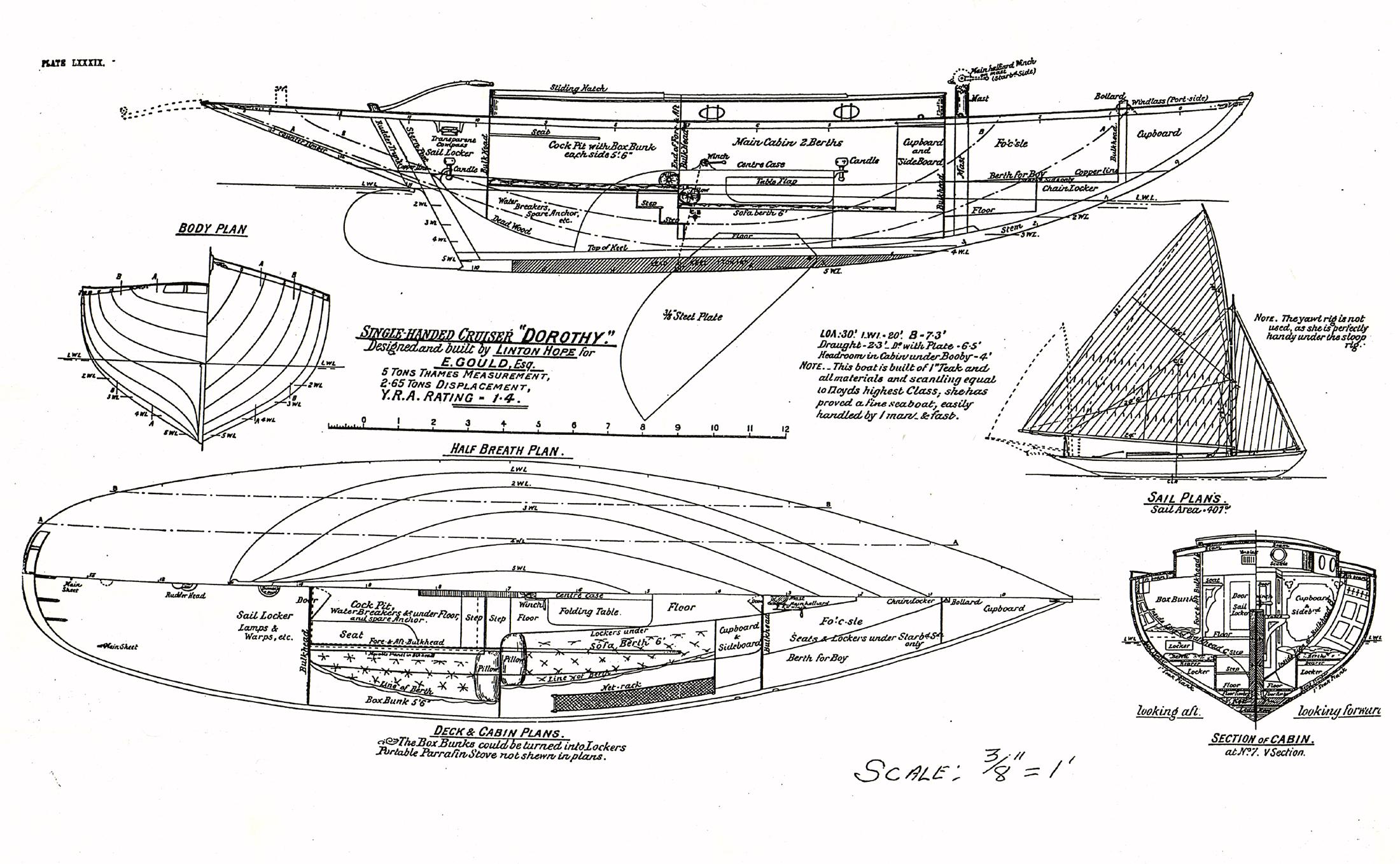
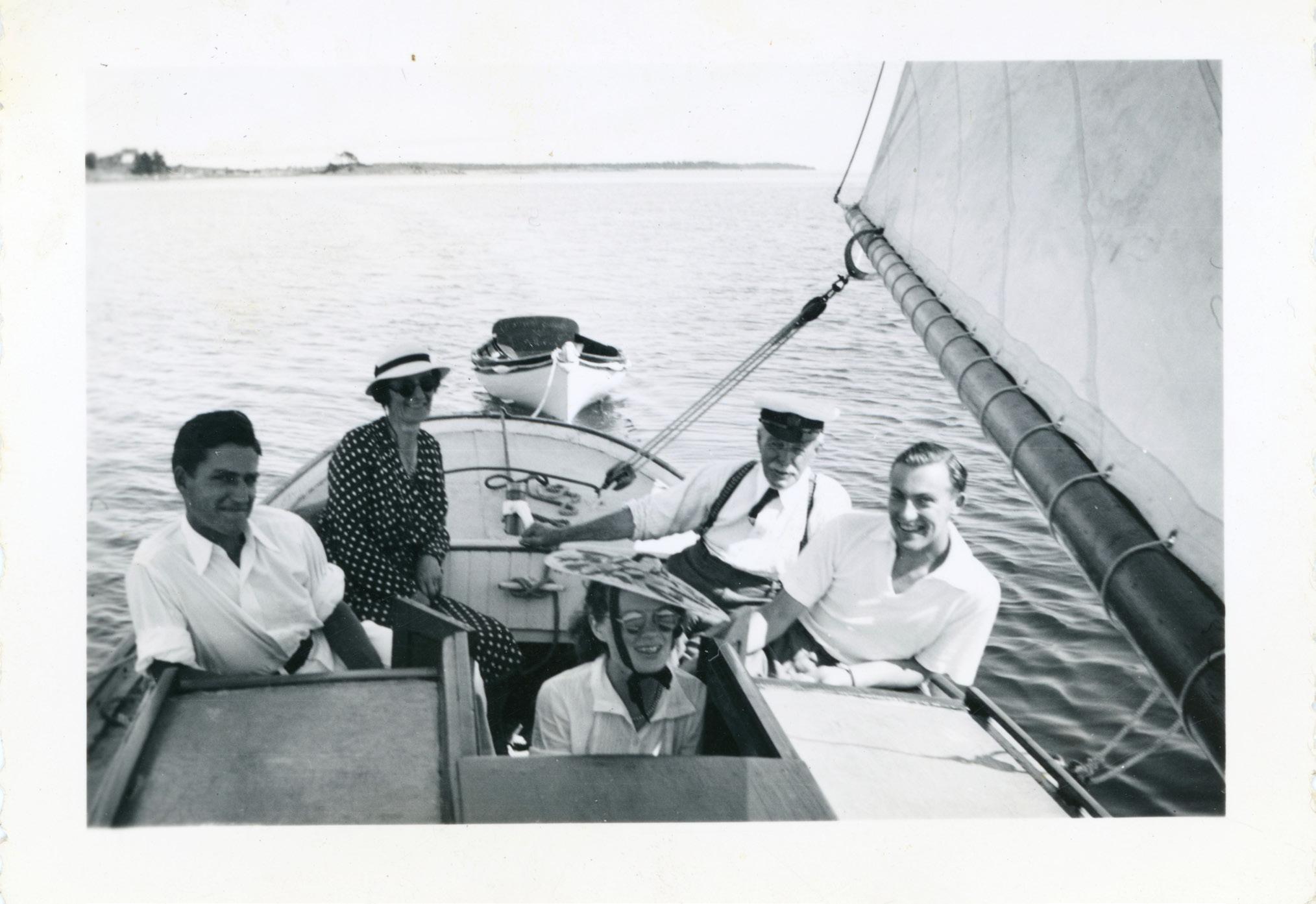
resistant silicon bronze bolts. He replaced the garboards with old-growth red cedar he had on hand. Several of the oak frames had weakened and so he fashioned “sister frames” to strengthen them along with installing new floor timbers.
Grove burned off the hull’s 126 years of layered paint with a heat gun, leaving the planks ready to be reefed. “Wooden hulls must be reefed every 30 to 40 years,” he explained. “I don’t think Dorothy had ever had that done.”
He used a reefing iron to excavate old cotton and paying compounds from hundreds of feet of cedar plank seams. “It was a mess,” he said. “I found cement, polyurethane, epoxy, bondo, white and red lead putty and good old sticky tar.”
The reefing exposed damaged edges of some of the soft cedar planks, likely made by different workers spot-caulking leaky areas over decades. Some seams were finger-wide, too wide for re-caulking, so he applied spline wedges to narrow them.
Pounding in new cotton and applying red lead putty were the next steps in making the seams waterproof again. “Over the years I’d bought that putty at old chandleries,” he said. “They’d hidden it in their basements when it was no longer legal to sell to the public. The cotton and putty together make a waterproof gasket.”
He dug out the old copper rivet and rove fasteners and corroded galvanized screws, substituting new rivet and roves and silicone bronze screws. To fill holes left by former fasteners, he cut blocks of red cedar into wedge spikes and hammered them into the openings. On the new hull planking, he covered screw heads with red cedar plugs.
After caulking was complete, he applied red-lead primer below the waterline and marine primer above the waterline. “MMBC and I’d agreed to use traditional products like lead-based putties and primers to keep Dorothy as historically accurate as possible,” he explained.
GROVE CONSTRUCTED A samson post and a new bowsprit for the sailboat, as well as a new fir rubrail that included a laminated section to fit her beautiful, rounded stern.

Dorothy’s old age had never discouraged Grove. For him, it was like encountering a palimpsest. “Being able to look into a boat that was built of that era and being able to dig inside and find markings and scribes where the boatbuilders had marked a plank, I get to be part of that history,” he said.
In 2022, having revitalised Dorothy’s structural elements, Grove passed her on to the Ladysmith Maritime Society, where Robert Lawson and his volunteer crew worked on her next phase—the touches that would return her to earlier glory using modern materials that resemble the original.
With sweat and dedication, they hand-painted three coats of Interlux Brightside Polyurethane on the topsides and the original galvanized chainplates. The brightwork received eight coats




of high-gloss Epifanes. Replicas of the original bronze hinges embellish the companionway doors. They burnished the bronze portholes and other bronze items, including a matching bronze cover hiding the power hookup. They polished era-consistent bronze mushrooms to ventilate the fantail.
I’m certain that when a well-dressed, graceful Dorothy slid into the Salish Sea, John Robinson and William Langley—had they been present— would have recognized her instantly and been thrilled.
THERE ARE STILL final touches to come. Dorothy’s original fir mast, with its eight-layer varnish, will be stepped and rigged. The LMS is fitting walnut paneling below. The original 1897 wooden headsail foil and bronze furling gear (that’s not a misprint) will be re-installed. Bronze Herreshoff-type blocks will be added. An electric motor and batteries will fill the former engine compartment. “We use technology as appropriate,” said Matthews. “An electric motor doesn’t vibrate or put oil in the bilge. We don’t want to make the yacht into a museum piece harking back to the 1890s. But we do want her to represent her era exhibiting the simple elegance Langley could afford.”
MMBC will make Dorothy a “living boat,” an active part of the museum. She’ll appear at classic boat shows, on yacht clubs’ opening days and other maritime events. “We want to take out small groups of kids and show them what it’s like to sail a gaff-rigged yacht that reflects the times of their great-great-great-great grandparents,” Matthews continued. “To experience what they experienced.”
“Will Canada’s oldest sailboat see another 126 years?” I asked. “She will if we can increase the endowment fund started at the Victoria Foundation,” he said. “I think she’ll live on. She’s a beautiful vessel. I always remember John West’s quote, ‘Because she’s pretty, she’s lasted and been looked after.’”
Carol Bertram knew about her greatgreat-grandfather, John J. Robinson, partly because he’d built cradles resembling small boats. In an email, she wrote, “family members have two little clinkers… They’re about four feet long and float. I have a picture of myself at age two floating in a Victoria waterway.”
While conducting family research three years ago, she found the connection to Dorothy and her ongoing repairs. Excited, she visited Tony Grove and Robert Lawson and his LMS crew, taking a deep interest in the yacht’s midlife refit and becoming a significant project sponsor. When re-dedicating Dorothy at the May 27 launch, she was accompanied by four other Robinson great-great-grandchildren—sister Pat Seller, brother Bob Tarling and cousins Mike McManus and Cindy Bannerman. Cindy had brought her daughter Kim Pigott—Robinson’s great-great-great-granddaughter, who in turn was accompanied by her son, great-great-great-greatgrandson Linus Pigott!
The Langley family was also well represented at Dorothy’s launch. William’s granddaughter Judith Branion, fellow Langley grandchildren Joanne and Diane, great-granddaughter Gail Elijah, her daughter Jillian Elijah-Wiwchar and her son Eli—three greats—all attended the ceremony. “My parents, aunts and uncles sailed with our grandfather,” said Judith. “That’s why watching Dorothy enter the water again remains one of my happiest and emotional moments. We all loved it.”
The Robinson and Langley descendants aren’t Dorothy’s only family—there’s an extended family who’ve offered financial support or contributed to saving her. Lawson’s dogged research has unearthed Dorothy’s history and he’s spearheaded the LMS finishing work. Tony Grove restored Dorothy’s essential structure at greatly reduced cost to the MMBC. And Angus Matthews has spent countless hours liaising with Grove, Lawson and others who’ve contributed to her becoming seaworthy again.

AUGUST 18 - 27, 2023

Open to all ages and coastal locations in British Columbia, the 4th Annual Freedom Marine Digital Fishing Derby will be held between August 18th - 27th.





With no designated starting point or meeting places, simply upload a picture of your saltwater catch while wearing a complimentary Freedom Marine hat. Visit our website for full details.
Prize categories include:
• Overall Grand Prize
• Best Chinook Salmon
• Best Ling Cod
• Best Halibut
Additional prizes for:
• Best photo overall
• Best boating photo

• Best photo (age 16 and under) x3
• Plus Exciting Daily Prizes!
Register before Aug 13!
boatingfreedom.com/fishing


An awesome anniversary at Antigua Classic Regatta
By Liza CopelandENGLISH HARBOUR WAS BULGING WITH BOATS GATHERED FOR ANTIGUA CLASSIC YACHT REGATTA AND ANTIGUA RACE WEEK ON OUR ARRIVAL FROM BRAZIL IN OUR BENETEAU, BAGHEER A.
Both these events lure large numbers of participants from around the world. It is the smaller Classics Regatta, however, that draws the spectator crowd, as it brings together some of the largest and most beautiful yachts ever built. Watching the crews of these powerful schooners, yawls, ketches and sloops battle around the buoys in tropical seas with multiple sails flying is an unforgettable experience.
MOTORING
THE crowded wharves of Nelson’s Dockyard our eyes were immediately mesmerized by a particularly distinctive classic yacht— the 1936, Francis Herreshoff designed ketch Ticonderoga. Spanning 72 feet on deck and 86 feet overall, Ticonderoga has been heralded as one of the most elegant of designs, with her perfect sheer, raked masts, striking clipper bow and distinctive heart-shaped stern.
We had known Ti in the early 1970s when running charter boats in the Caribbean. In 1973, owners Ken and Fran McKenzie generously offered
the gift of her as our wedding venue. As they were coming north from Grenada for the summer, they had suggested the French island of Martinique, where we were duly wed on April 23, sailing out of Fort de France. A few days earlier we had a civil ceremony in Antigua, feeling more secure under British law. It was for this anniversary that Tom Reardon, Ti’s current captain, invited us for ‘happy hour’ drinks aboard. Ticonderoga lay stern to the dockyard’s old paymaster’s office and our eyes feasted over her sweeping teak deck and its abundant, gleaming brightwork as we climbed aboard. Below, the traditional cabins were also immaculate, all ready for owner Scott Frantz and friends to arrive for the Classic Regatta the following weekend. During the evening, the possibility of racing aboard her on our Martinique anniversary was born, as
April 23 fell right in the middle of the Classics event!
When Scott arrived, he kindly agreed to have us aboard for the race. All we needed now was wind! It had been calm for days and the few williwaws rippling the water were from the west, not the desired steady, easterly trades. The first day dawned late with a flat grey sky, a damp morning with yachts drifting backwards at the start of the first Classics event. Fortunately, a light breeze later filled in, bringing some relief to frustrated crews. It looked as though the following day would bring more of the same. Andy woke me early with wedding anniversary greetings and handed me tea, beaming. Today the sky was blue; the white wavelets around Bagheera’s hull glistened in the sun and at the mouth of Falmouth Harbour there was wind. My spirits soared; unexpectedly our ‘special day’ seemed assured.


ALTHOUGH ASHORE AT 08:30, we could barely find room on the dinghy dock at the Antigua Yacht Club Marina in Falmouth Harbour, where most of the classic yachts were gathered. Ranging in length from 28 to 136 feet, there were 54 participants, an impressive number compared to the original seven. 1988 was the first year the elegant classic yachts raced in their own event, their numbers having dwindled in Race Week with the increasing advent of fibreglass racing machines. The definition of a classic yacht is complex with four divisions. Traditional is defined as fishing, or cargo vessels, built or converted to sail. Vintage means yachts with a full keel designed and launched before January 1950. Classics are defined as yachts with a full keel designed and launched after January 1950. Spirit Of Tradition includes yachts built recently using modern methods and design, but retaining the original grace and style of the old classics. Finally Tall Ships refers to training and passenger vessels. Ticonderoga was placed in Vintage Class C.
As we wandered down the dock we chatted to friends who were racing on other boats. There was the usual pre-race flurry of activity after the party at the yacht club the night before! In contrast, all was calm on Ti. The crew had been up since dawn and Tom was even allowing himself to lounge on one of the bagged spinnakers amidships. Tom, Scott and crew could not have been more welcoming. All 18 aboard donned Ti shirts and hats and Scott even made a speech to congratulate us as we headed out. The crew, including Scott’s racing buddies, then sprang into action, hoisting the mainsail and readying the heavy headsails that were hanked at the bowsprit and stem. Our earlier sunny skies were obscured by dark rainsqualls. There was concern that the wind would be affected, but after a short, cooling rain shower it was back

to averaging a perfect 15, occasionally dropping to an acceptable eight knots. We held back while other classes started and then it was our turn to head for the line. With our four sails trimmed as the starting gun fired—yankee, jib, main and mizzen—Ti settled into her remarkable greyhound motion. Immediately we could feel her pull away through the waves with a power that intoxicated all on board. What a thrill to experience this amazing motion again, reminding us of our 150-mile sleighride sail from Martinique to Antigua after our wedding and Ti’s extraordinarily successful career as a racing yacht.
Interestingly, Ti wasn’t designed to be a racer and in 1936 Tioga of Marblehead, as she was then called, was launched as a leisurely family day-sailer. It soon became evident, however, that her underwater hull also produced extraordinary speed and Tioga unexpectedly became

an indomitable racer. Under a series of owners her career was extraordinary and at one time she held over 30 elapsed time records that included all of the SORC events, the Transpac and the TransAtlantic Race, many of which still stand. Although she was chartered for a while, she is now back to being a private yacht used by family and friends, to enjoy many of the classic yacht events.
FOR THE MOST part Scott stayed at the helm during the race, appearing calm and relaxed, but he and the crew raced the boat hard. Tom was constantly on the move between the bow and the stern, checking the sail trim, keeping lines shipshape and making sure that we knew our jobs. Used to running our own race boats, we found it delightfully relaxing just helping with the running
backstays and tailing the mizzen winch. Occasionally, when the wind gusted to 20 and surf sluiced down the leeward rail we would sit out on the windward side, which gave a great opportunity to view the sensational sights of the rest of the fleet at sea. Sunday’s course was ‘The Butterfly’ and fleets often came close, which made for exciting mark roundings when frenzied crews launched or doused large spinnakers.
Our particular rival was the William Fife-designed yawl, Mariella, with whom we had one close mark rounding, although the race instruction’s stipulation to avoid protest situations was strictly followed. Other thrills included being close to the 103-foot Aschanti IV, and the 136-foot gaff schooner Eleanora, who had all seven sails set. She was built in 2000 and
is a replica of Westward designed by Nat Herreshoff, Francis’ father. Also memorable was the speedy 138-foot J-class replica Ranger in action, with her large, colourful crew hiking the windward rail. She was built in 2003 along the lines of the Starling Burgess and Stephens brothers designed yacht completed in1937.
On the second to last leg Scott invited Andy to take the helm and as we rounded the last mark before the finish, he handed it over to me. Sitting sideways behind the wooden wheel, grasping its outer rim, I felt right at home. What an exhilaration to be holding the course for the line, with white surf foaming in the deep sapphire seas in our wake. I had a quick flashback of being at the helm decked in a macramé wedding dress, then the wind gusted and I had to concentrate! All too soon we had crossed the finish. It was hard to believe that three hours and 13 minutes had flashed by so quickly.
OUR TIME ON board, however, wasn’t quite over as the Parade of Sail in English Harbour was also scheduled that day. In no time sails were down and we were passing the Pillars of Hercules under Shirley Heights to parade past the crowds at Antigua Slipway, and by Nelson’s Dockyard, the beautifully renovated British naval base built in 1725. Ticonderoga of Greenwich’s cannon was fired and we passed the pelicans perched on the rocks by Berkley Point before rounding the headland and entering Falmouth Harbour. Too soon we were berthed back at the Yacht Club Marina. Scott and friends had a dive planned and we went for a quick snorkel by dinghy ourselves. Andy still had time for his customary siesta before we joined our current cruising buddies for the usual sundowner rum punches at the Mad Mongoose restaurant. What happy tales all had to tell, but our day had not ended yet. There was still Tom’s party at the yacht club to celebrate his birthday and 20 years aboard ‘Big Ti’. Returning to Bagheera, Andy and I both agreed: “What a fun-filled, awesome 33rd wedding anniversary—but what to do next year?”
Lightweight machined aluminium drums with a distinctive profile for exceptional line grip and control, and Ronstan’s unique, patented QuickTrim™ self-tailing.
Finally it’s easy to ease the sheet without removing the winch handle or the line from the self-tailer. With QuickTrim™, racing sailors can react instantly in response to minor course corrections or changes to wind pressure and direction. Cruising sailors will appreciate the simple convenience of easier sail adjustment.


Getting away is a truly wonderful thing. Distance from one’s daily situation lends perspective, and if one happens to be on a boat, clarity as crystal clear as the waters of British Columbia’s Salish Sea have been known to envelop the happy traveler. Last summer, I was that happy traveller, a guest aboard a 36-foot Bavaria cruising the Gulf Islands. My mind was freed from the daily worries of work and city life, so I
pondered more important topics such as why did we bring so many prune plums? What happens if I eat too many prune plums? What distinguishes a good outhouse from a terrible one? And if I created a rating scale what would the criteria be?
I spent my week thinking this through, laying out the basic rating scale using the available facilities across the Gulf Islands, and for the sake of scientific research and for the good of all boaters, I field tested
the scale on subsequent outings across the sunny summer islands of BC.
Prune plums, a reliable diuretic, are not often a topic of consideration for those under 70, but as our crew unpacked and assessed our provisions, we discovered that either great minds think alike, or Costco was having a sale on plums. To split between four souls, we had nine pounds of plums or, and this is a rough guess, 72 plums, in very close quarters. If you are following my logic,
this is how my mind came to rest upon the humble outhouse. For those afflicted by powder room stage fright or simply wanting to attend to their business outside the echo chamber of the boat, the Gulf Islands boast many on-land establishments that offer seclusion, usually toilet paper, and, if you are lucky, the sound of crashing waves and the scent of cedar wood chips. Indeed, thanks to the dedicated staff of BC Marine Parks and government funding, the Gulf Islands are largely protected from the lower rankings on my scale. But for those seeking the thrill of adventure that more remote locales offer, like a cruising guide’s advice on anchorages, my research will be your guide when you need to go.
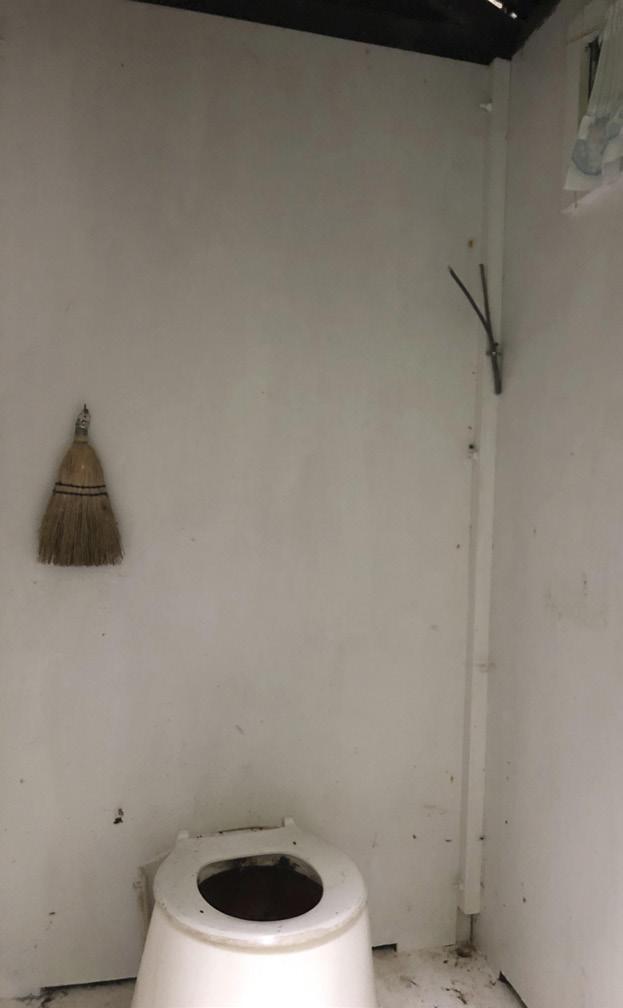
What may tip off the wary wanderer of a category-one establishment? If you are trying to decide if you should hold it until you get back to the boat, you should judge a book by its cover. If you spot wads of snow-coloured tissues surrounding the structure like I did at Vancouver Island’s Strathcona Park, you should consider the ‘snowballs’ as
a customer review of the cleanliness of the facilities. As in, people would rather go outside than in. You may think that I had found the worst outhouse on the West Coast, but my experience reserves that prize for Cortez Island’s Von Donop Inlet. This is certainly a one star structure. I wouldn’t have stopped, but my research required that I give it a rating. The approach itself was worrisome, our path was flanked by no less than three warning signs for wolves. We had taken a wrong turn and it was getting to be dusk in the damp woods. Finding the door proved impossible—there wasn’t one. For decency the opening faced away from the path and into the woods, which in a sunny clime might have been nice, but I couldn’t shake the image of looking up to find a smiling wolf just as I sat down. Considering the lack of upkeep, I was surprised to find a small broom and what I’d guess to be a 1940s curtain. Quite posh you might think, but the floor was soft indicating a real possibility that you may never get to the throne.
A number two facility is one in which you’d rather not have a number two. It’s more of a dine and dash. Gulping for air as you enter, you think that you’ll exhale as you leave, but the midstream push has exhausted your air supply forcing you to inhale deeply. Hauling up your pants you charge through the door, lungs bursting as if you’ve crossed the finish line in a marathon. Often lacking amenities such as air flow, TP, and a working lock, adding to the urgency of the situation, a two-star is simply about necessity. Gambier Island’s Halkett Bay facility claims two-star status largely due to its location. Buried beneath heavy tree cover there is a lack of natural light and air flow streaming in from its underroof vents. What does stream in is the sounds of campers and hikers passing by on the adjacent main trail. Aside from the lack of privacy, this wouldn’t be a problem, but as every wooden boater

knows, wood swells in wet weather and this outhouse door is not exempt. That little latch can’t quite reach the loop in spring and fall, and you are left rushing and fumbling in the dark hoping that a happy hiker doesn’t burst in on you.


Moving up in the world is the threestar. Like its equivalently rated hotel, it’s got everything you need and nothing more. It’s the most common rating given. Too nice to tear down and not nice enough to be memorable—unless you’re keeping track, like me. You’ll find three stars in the Gulf Islands at Pirates Cove on De Courcy Island, and at the campgrounds on Wallace Island. Part and parcel of three stars is the lack of amenities and so the near constant empty status of the hand sanitizer
shouldn’t be a surprise. Out of instinct you press your whole hand on it as every other contaminated hand before your visit has done. Sometimes you are rewarded. Other times you aren’t. Perhaps the life lesson of this article is to always pack a small bottle of hand sanitizer and a few tissues for your land excursions.

On to happier thoughts and Portland Island’s four-star palace. Princess Margaret was gifted Portland Island in 1958 to commemorate her visit to the province. I imagine the real estate market was less favourable then because like an unwanted present she regifted it as soon as it was socially acceptable to do so, which turned out to be 1967. The lucky recipient was BC’s Gulf Islands National Parks Reserve—and us. For landlubbers itching to stretch their legs Portland Island has the answer with 9.6 kilometres of trails looping and crisscrossing the picturesque island. You might like it enough to stay, and lucky for you it has two areas to anchor, Princess Bay and Royal Cove, as well as two areas for camping, Arbutus Point and Shell Beach. Three-star pit toilets abound but nestled between the old apple orchard and Princess Bay beach is a four-star facility worthy of its royal locale. The L-shaped ramp leading to the two-story structure is made with fresh cut cedar and boasts a refreshing view of the turquoise waters below. Far from holding your breath you are welcome to inhale the sea and cedar scented air. You’d be forgiven if you thought it had air conditioning. The gentle breeze tickling your cheeks is actually part of the sophisticated Phoenix composting toilet system, which, when mixed with the wood chips provided, turns your business into a “humus like soil” said to prevent water and soil pollution. Complete with instructions and a catchy slogan “please help the Phoenix do its job while you do yours,” this outhouse
We make getting out of boat ownership a breeze.



Donate your boat in support of our

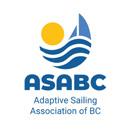














is a place you don’t mind lingering. Waves dance upon the rocky shore below creating a relaxing soundtrack.
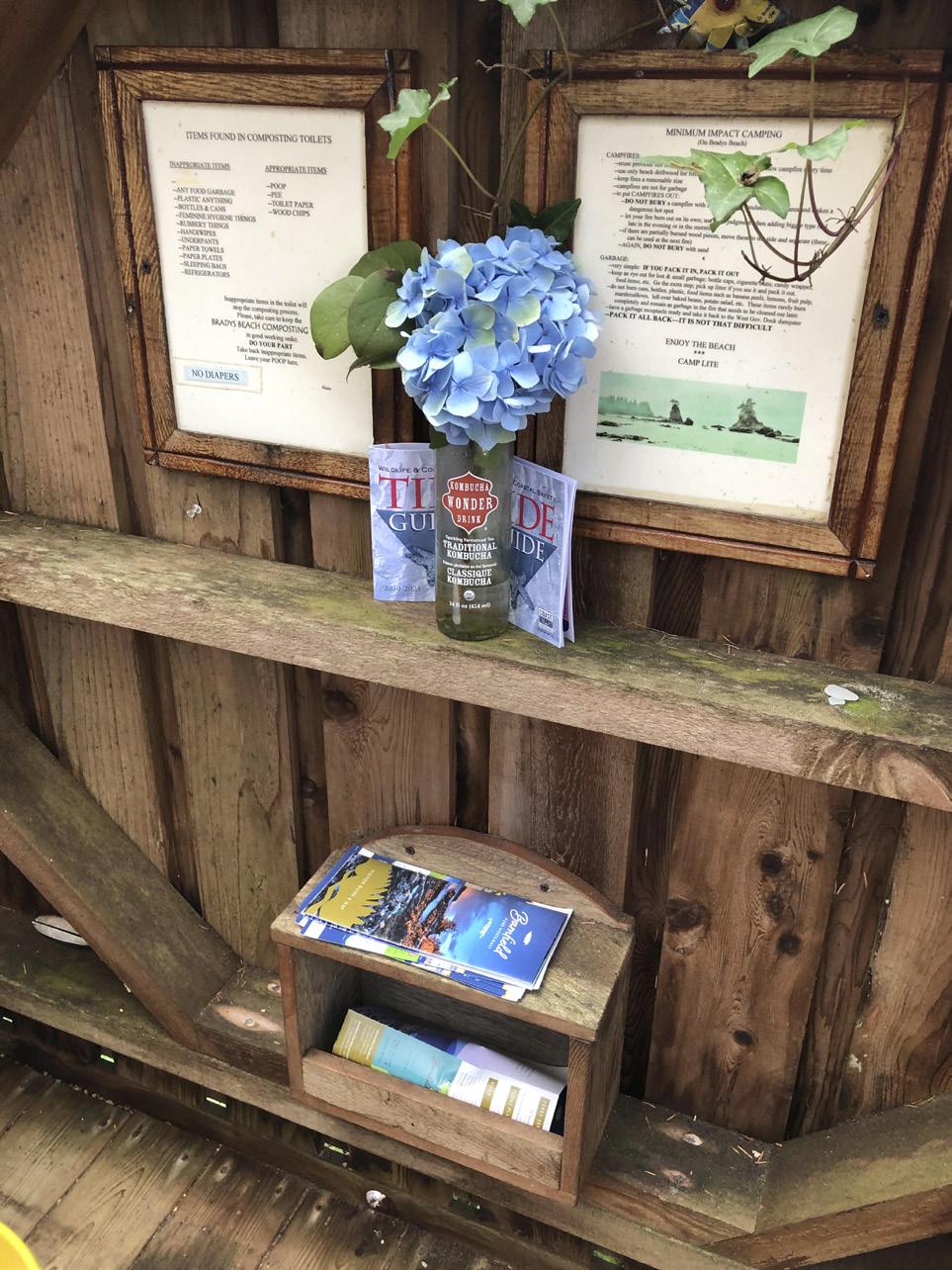
Like most scientific research there are anomalies and outliers, and my rating scale is no different. One’s personal preference and circumstances must come into play and that can skew a rating. For example, I usually leave door-less structures in the condemned categories of one and two stars. However, Roscoe Bay in Desolation Sound is an outlier facility that earned itself a 3.5 rating despite its door being permanently jammed open. Ascending a gentle slope, the approach is flanked with trees and low lying salal and salmonberry bushes. The door faces the pathway requiring a guard to stand watch at the bottom of the hill. There’s nothing fancy here; a plastic seat as per normal, tissues and a gentle breeze. What sets this one apart is the experi-


ence. Just as I settle in, a robin bounces into view with the salmonberry, hitting centre stage, it devours its catch, looks around and departs. It’s as if I’ve caught David Attenborough’s latest nature clip. My husband’s trip does not disappoint either for he is greeted by twitterpated butterflies fluttering to-and-fro, kissing berry blossoms along the trail. On a sunny summer day, I give this experience a 3.5, but I can imagine a 2.5 or three on a rainy day when the wind whips inside the open door making you and the toilet paper soggy.
FIVE STARS
What could possibly top Princess Bay’s potty? You’ve got to travel to the terminus of the West Coast Trail in Bamfield. This remote outpost
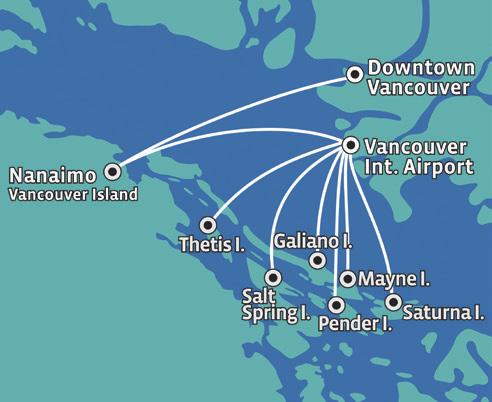
on Vancouver Island is home to a Marine Science Centre, a post office, a boardwalk and a pizza shop. It is well worth a visit, but it’s not easy to reach. If you are coming by boat, your options are to brave the “Graveyard of the Pacific,” by sailing offshore from Victoria via the Juan De Fuca Strait or trailer your boat to Port Alberni and enjoy the 35-mile protected inlet cruise. Is it worth all the effort to get to a five-star outhouse? Well, no, but if you are there for other reasons you’ll be delighted by the unexpected wilderness luxury.

Like a Ritz Carleton, the Brady Loo boasts an impressive amenity list. The two-storey walk up is located at the entrance to Brady’s Beach and sports an ample observation deck affording a clear view of the wild West Coast. The loo

is equipped with a composting toilet, excellent ventilation, tissues and light, which is perfect for taking in the plentiful reading material including tourist brochures from the surrounding area, camping guidelines and a coastal safety tide guide. These extra touches are truly unique, but I’m surprised and delighted by the freshly cut hydrangea in a kombucha vase. Fresh-cut flowers in an outhouse? I can hardly call it that, which might be why it so affectionately has a name. It truly is in a class of its own.
While my weak bladder has tested outhouses across BC, I know I’ve missed some. For the sake of science, I’d be much obliged if you shared your outhouse finds and their rating using #outhousesofbc.

$200
The latest handheld VHF from Standard Horizon, the HX320 is a rugged, IPX7 rated waterproof unit designed to float and “fight against water intrusion.” The HX320 is equipped with a typec USB charging port and comes with a charging cable and USB-AC adapter. The 2,100mAH Li-Polymer battery provides 17 hours of operating time. Other features include a wateractivated strobe light in case the unit is dropped in the water and Bluetooth technology so the unit can be operated hands free with the optional Bluetooth headset (model SSM-BT10). standardhorizon.com
$170
Available for men and women, the Kiata waterproof sneaker is built to be supportive and comfortable for all summer activities.

Constructed from an innovative 100 percent waterproof 3D knit upper crafted from a single yarn, the shoe provides a seamless design which flows over the curves of your foot with ease. This lightweight sock-like upper combined with a high rebound cushioned midsole and perforated comfort insole provides breathability, support and stability. The TUFgrip outsole offers traction on flat hard surfaces and uneven terrain. The non-marking sole is perfect for boating adventures. xtratuf.ca

$85
Thermacell E-series is easy to use and provides hours of scent-free, mess-free mosquito defense. Perfect for the boat, the EL55 provides a 20-foot (six-metre) zone of mosquito repellent. The unit is powered by a rechargeable Li-ion battery and features up to nine hours of battery life. A bonus of the El55 is that it provides ambient dimmable light to create a warm, comfy space on deck or down below. Audio cues and LEDs let you know you’re protected and how much battery life remains. Keep mosquitoes away with the simple push of a button. thermacell.com
$30+
The Summer Shower from Advanced Elements is the perfect way to wash off on deck. Available in a multitude of sizes from 2.5 to 10 gallons (10 to 38 litres), these solar showers are designed with an efficient fourlayer construction for optimal heat retention and rugged durability. For anyone who hasn’t used a solar shower before, the instructions for use are simple: Fill up the bag with water. Leave it in the sun for a couple hours to heat. Hang from the mast or a tree. Enjoy a hot shower. advancedelements.com







$140
Don’t muddy your boat shoes on the next shore excursion. Instead, throw on a pair of Muckster boots before you get in the dinghy and keep your feet warm and dry. The latest from Muck Boot Company, the Muckster II mid-height boot is perfect for beach walks and shore scrambles—even in the rain. The boot slips on and off easily and features a rugged, high-traction outsole for grip on the rocks and a quick-drying mesh lining for enhanced breathability.
muckbootcompany.ca
$270
The MIT 150 Convertible AM Inflatable from Mustang has a Type II performance rating which provides stronger turning performance and airway protection when in the water (compared to a type III device). Mustang designed this PFD for coastal excursions, and the convertible inflator lets users customize their safety by easily switching between automatic and manual inflation options.
The MIT 150 is designed to self-right most wearers once inflated and provides 38 pounds of buoyancy. A zippered hip pocket carries the converter cap.

mustangsurvival.ca
$530
Designed for convenience, this versatile and feature-rich jacket utilizes the same MarineSpec SP fabric found in the original Taku. The Taku Elite has discretely configured features, including external pocketing and attachment points for quick access to frequently used items. It is ideal for marine professionals and coastal boaters.
The neoprene inner cuffs and stowable drop hood provide protection against the elements and plenty of pockets secure the essentials. This waterproof men’s jacket performs in various inshore and coastal marine environments.
Combine any Taku jacket with the Taku Bib for a head-to-toe waterproof system.

mustangsurvival.ca
$5,000
Garmin’s new Force Kraken trolling motor is set to be released to the public this fall but we couldn’t wait to let our readers know about it. Said to be the most powerful trolling motor on the market, the brushless motor uses a high-efficiency propeller to produce 100 pounds of thrust on a 36-volt system. The pivoting motor will be available in black and white and with three different shaft lengths (63”, 75” and 90”) depending on the height required. Wirelessly connect the motor to your Garmin chart plotter to create routes and tracks for your motor to follow or to hold you in position.
garmin.com/en-CA





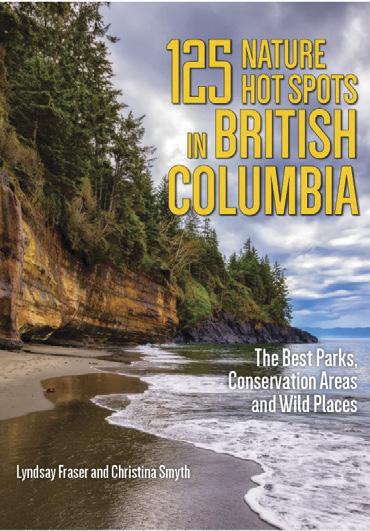




The Van Isle 360, without a doubt, is one of my favourite races ever. This would be my sixth full race participation, spanning 24 years. I can say that

Tthis year’s was very special, and I’m truly humbled and grateful for the two-week experience alongside my teammates aboard Suze Cumming’s Sabre 386 Reepicheep. There’s a full feature article in the works which I’ll share in an upcoming issue of PY. For this month’s column, I thought I’d simply talk about a few of the lessons and my own takeaways from this year’s edition of the race. There’s much to unpack. Let’s get at it.

Let’s begin by talking a little bit about the mental and physical challenges of a race around Vancouver Island. As a crew, many of our pre-race talks revolved around the grind of a 14-day series of races. Start strong, stay focused, compete hard, finish strong, regroup, relax, reset, repeat. Sounds like fun, and it is, but in fact each person in our crew of five would only have a finite amount of energy currency to spend,
both physical and mental. The importance of sharing the workload was something we really tried to practice. We also focussed on staying hydrated, eating enough and sleeping enough. These practices would be foundational for any chance of consistency and success in the race.

The physical part was about everyone rotating through the trimming, grinding, helming and making sure no one got burnt out or injured. I’m not suggesting that all these jobs were precisely, equally shared, but there was a basic plan through most legs, that we talked about and tried to stick to. Most typically, skipper Suze, would helm at the start of each leg. My job involved strategy, boat speed and tactics. In the early race legs, I was likely over-involved in the trimming, but gradually that morphed into me being freed up to look around more, it also helped preserve my lower back and bum knee… You’re only as old as you feel, right? The bigger benefit was giving Becky, Dave and Renee more trimming opportunities and, of course, keeping everyone engaged and fresh. We also had super subs, Adam and “other” Dave for the first two legs and the last leg respectively. Our team mantra, which evolved a little during the race was: “Nobody gets hurt (that’s the quickest way to lose the Van Isle). Don’t break the boat (that’s the second quickest way to lose the Van Isle). Sail smart and fast in the right direction.”
A couple of hours into most legs, I would take the helm, Suze would revert back to her navigator role, check in on the updated forecasts, fleet progress and boat positions. Additionally, one of my big asks was an open dialogue among the team about the wind (puffs and lulls), other boats (angles and speed), tide lines (relative set), and stuff in the water (eyes forward). The idea being that information on anything was good information. If
you see it and are thinking about it say it out loud, with clarity and purpose. I believe this proved to be one of our greatest strengths as a team and it made my role as tactician so much easier as the racing progressed from leg to leg.
The Van Isle is a nine-race regatta, with a different start line and course for every leg. The idea that somehow the start may be less important in a distance race… Well, I’ve thought about that one a lot and I’ve even tried to soft sell myself on it from time to time. Prior to the leg one start, I may even have uttered the words, “Let’s just be nice and conservative, we don’t have to win the start.” So let me qualify that a little bit by stating straight out, “The start is always important, full stop!” It’s not always necessary to win the start but as the sequence progresses, if the opportunity presents itself, then take it. If there is any sense of heightened risk, such as everyone setting up at the highly favoured end of the line, my advice and inclination is to stay away. Getting away cleanly in a fleet of 40 very different boats is paramount and I would generally choose the lower density option, slightly away from the pack. Additionally, here’s my list of must dos: Find clean air, arrive on time and sail fast in the right direction. My do nots: Tangle or bump with others, get too far from the line, be late or sit in dirty air. To summarize then: Winning a distance race does not always mean winning the start, but winning the race almost always means not losing the start. Ha, try to decipher that one.


Back to the nine-race regatta concept, and as Chief Judge Mike Turner pointed out at the skippers meeting, please avoid frivolous protests or boat on

boat conflicts. Aside from that, in our pre-race team discussions we talked a lot about consistency, maintaining focus, exercising patience and making sure we competed against the entire fleet, not just our immediate division. I think that last item served us well throughout the race. As a fan of handicap racing, and one-design as well, I’ve always tried to adopt the mindset of competing boat for boat, regardless of rating or speed potential. In the Van Isle all divisions started together (except on the first leg), which was always challenging and exciting. From a motivational point of view, trying to start ahead of, and stay with faster rated boats, always gave a boost for the entire team, and once that expectation switch got flicked, it just became one
of our goals. As a general comment, I think raising your game in most any sport is about competing against the faster, stronger, perhaps more experienced competitors, and sailing is no different. My advice then is to know your boat’s performance strengths and weaknesses, be aware of relative handicaps, but try not to simply fall into the rating pecking order. Always try competing as if you’re on a level playing field, it’ll raise your expectations and your results.
A little back track for a moment. The preparation for a race like this was very daunting, requiring many months of work, including the boat preparation, safety compliance, food planning, crew assembly, practice and so much more! That preparation is a
critical part of any team’s race success. It was a pleasure to be part of that, and full credit goes to owner/skipper Suze for her relentless persistence and management skills. Spreading the tasks around and keeping track of the extensive jobs list is key when you are ticking off 50 things and adding 20 more. Before you know it they’re all done!
Renee took on the massive undertaking of food prep and meal planning, as well as being our medical officer, ready to look after all our ails. This totally thorough preparation made the racing so much easier and it allowed the entire team to hit the ground running. Becky was our take on any job, find anything, foredeck supreme, mast climber, bottom diver. Dave brought a wealth of sailing experience in all aspects of the
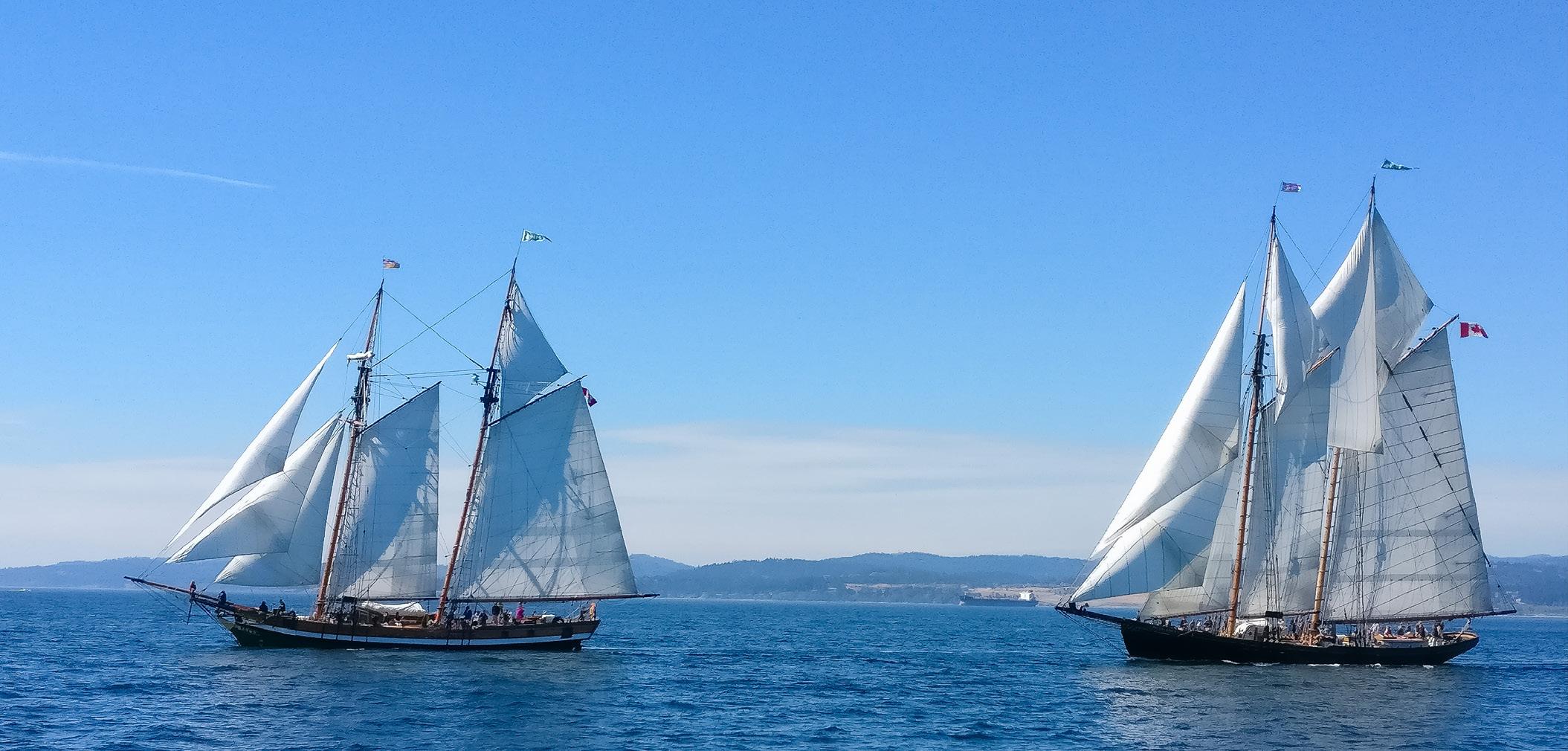
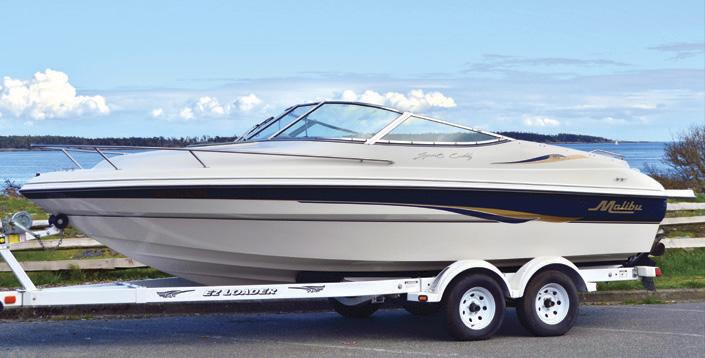


Van Isle. In fact, he helped organize and run the race in his younger years. Adam and “other” Dave had many miles of sailing experience and slotted in seamlessly. Preparation wins!
One of the biggest takeaways and lessons from a race like this is the simple importance of enjoying all of it! On one level it’s competition, testing yourselves against other teams, making the right choices, recovering from the wrong ones. Indeed, resilience may be the most valuable of all skills. It’s also everyone’s recreation; what we choose to do with our time off. The splendor of the scenery, wildlife and communities around our most beautiful islands is a gift that never gets old. The Van Isle is also a two-week social event and getting to know each other
off the racecourse, between finishes and starts, is an equally important part of what this race is. I think we all got along famously, considering the tight quarters for two weeks. On Reepicheep there was way more laughter than tears. Hey, there’s always going to be a few moments! We somewhat jokingly brought along a time-out tent. Thankfully, it wasn’t needed! Speaking for myself though, the greatest satisfaction, along with competing hard and doing well, was seeing everyone rise to the challenge, having each other’s backs and coming out the other side better friends. That’s a successful race!
HAVING DONE THE Van Isle 360 numerous times it seemed very familiar, yet each experience has been
so very different. The conditions this lap around were among the best that I recall. The racing was excellent, the camaraderie among many of the teams and the host communities was fantastic! That has always been a hallmark of this race and it’s difficult to think this might have been the last go round. It was truly wonderful to see so many new and younger racers taking part for the first time this year. I sincerely hope that someone steps forward to continue adding more chapters to the Van Isle 360 storybook. A giant thankyou to Jeff and Sylvia Motley and the organizing team, and to all the sponsors and sailors. Take care everyone, see you on the water soon… Maybe at the start line in Nanaimo Harbour in 2025?

Amazing Vacation Rental beachfront home on Saltspring Island includes excellent deep water moorage! New fully appointed chalet styled, 2400 sq ft, 2 bedroom, 2 bath, home on 1/2 acre next to park. Tennis court, hot tub, kayaks, hiking trails and more! Dock moorage for boat up to 33’ and mooring buoy for bigger boat. 30 Day min. Aug-Oct avail. $7,500/mo. Cdn plus tax.
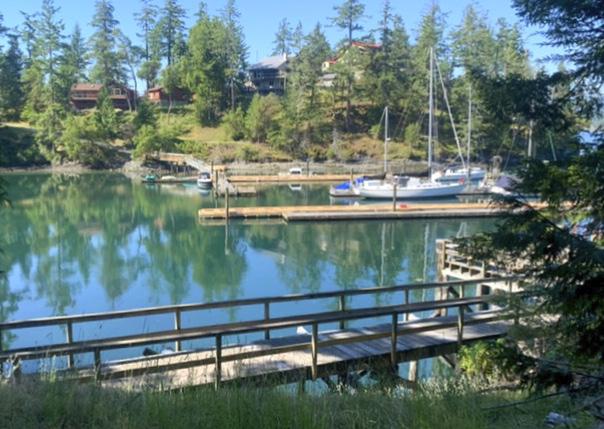



250-710-2630
kimkjohannsen@icloud.com
Saltwater angling can be intimidating for beginners. But take comfort, angling’s long-term learning curve is worth the effort

TSalmon are the preferred saltwater fish for most anglers, and chinook, coho, sockeye, pink and chum can all be caught by recreational anglers.
There are three learning tracks. First, acquire some knowledge about the life histories of marine species that you want to catch. Second, decide what styles of fishing to pursue. Third, match your equipment to the fish species and tactics you are interested in.
They are available all year long with multiple age classes at sea at the same time. However, due to variable size limits most are caught in their third and fourth years of life. Chinook are primarily meat eaters preferring baitfish from three to seven inches long such as herring, needlefish and pilchards. They
also like shrimp and squid, and will even eat shellfish if necessary. They are the largest salmon species with adults averaging between 15 and 30 pounds. Chinook enter rivers to spawn between May and October.
Feeder chinooks dominate the catch between October and June. These fish take active lures and baits that mimic the primary forage available. Place your lures and baits near bottom where the feed stacks are usually located, and focus fishing effort around tide changes when the forage is most active. Adjust fishing tactics for mature
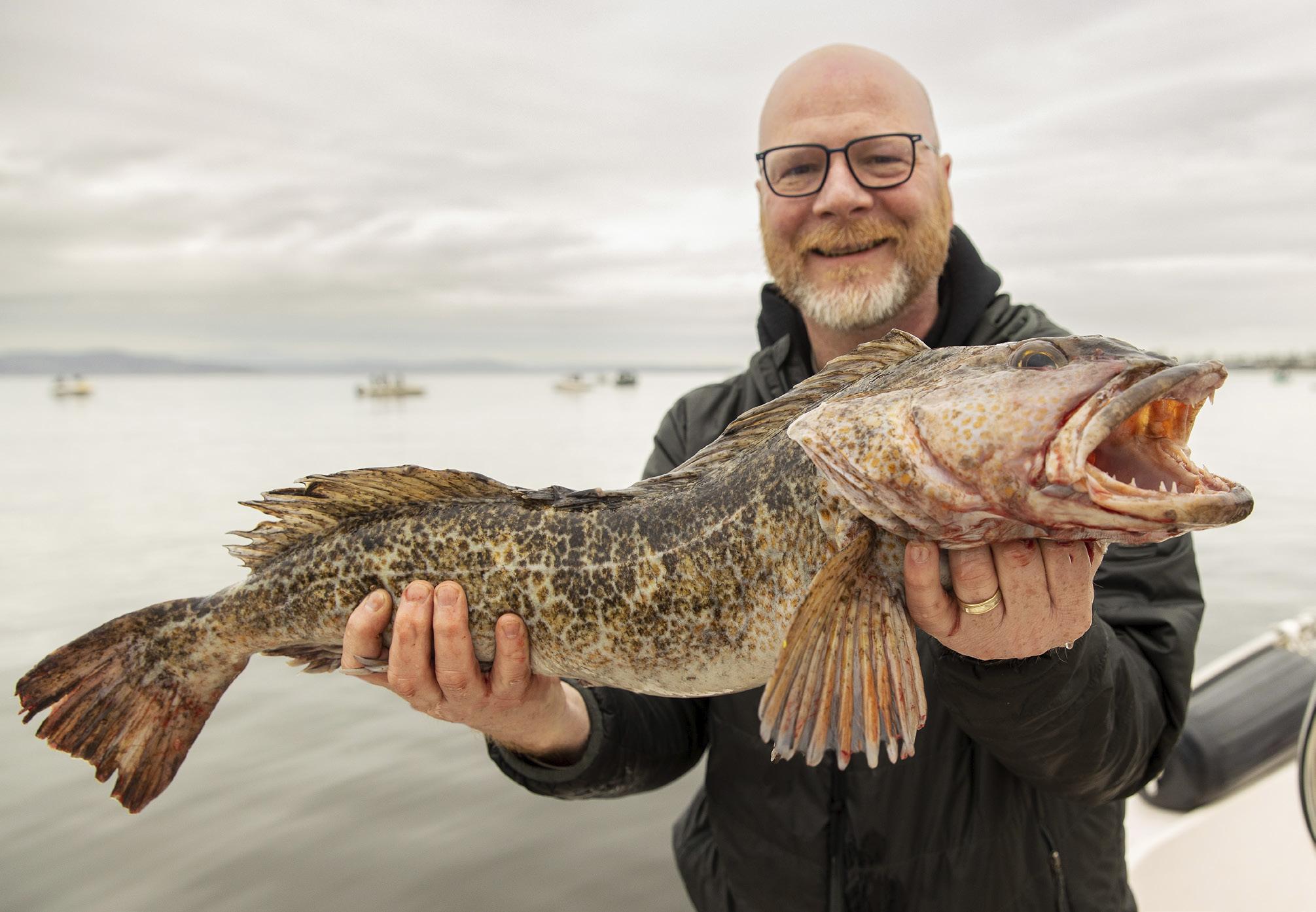
chinooks during their homeward migration. If they are still eating then modified feeder chinook tactics with slightly less active presentations work well. However, once they stop feeding, which happens during the final weeks of migration, switch to longer leader lengths and much less active lures repositioned in the middle to upper part of the water column. Also, extend your fishing time into the flood tide. Finally, focus your time on early morning and evening once these fish reach the terminal areas.
Anglers can troll, mooch, drift fish or spin cast from a boat or shore for chinook, but trolling with downriggers is the dominant coastwide tactic. Trolling with hoochies, spoons and bait behind full sized revolving flashers is the standard presentation. Plugs are effective but do not require an attractor. Pick UV, glow, chrome, chartreuse, green, purple, blue and white as base lure colours with red, black and pink mixed in. Trolling requires a significant financial investment and a commitment to learning. However, once mastered, it provides major fishing benefits that are transferrable to all salmon.

There is a much less expensive angling option. Try drift fishing with jigs, also called jigging, with lures that imitate the forage base. This is basic fishing only requiring a rod, reel, good quality line, hooks, a few swivels and some jigs. It’s done from a stationary boat that drifts with the current.
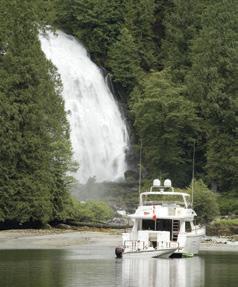







Drop your jig to the desired depth and activate it using a series of short, snappy vertical motions, with the rod’s starting position roughly parallel to the water’s surface. These same lures can be cast, allowed to sink and retrieved in a similar way. Change depths frequently and don’t over jig the lure.
Anglers can use any reel for jigging, but level wind reels are best. These can double for rockfish, cod and halibut

fishing if they have enough line capacity and line retrieve ratios. The best jigging rod is a bit stiff through the first two-thirds of its length tapering to a flexible tip.
Cut plugging is a bait trolling/ mooching variant that requires a detailed ‘how-to’ article.
They were the mainstay of BC’s recreational fishery up to the 1980s. Then important Strait of Georgia coho fisheries began to collapse as most resident coho abandoned the strait in the spring and early summer months. This precipitated stringent coho fishing restrictions which remain in place to this day. Good summer and fall coho opportunities exist in Northern BC and along the west coast of Vancouver Island.
Coho spend roughly 1.5 years each in fresh and saltwater. Except for some male two-year-old ‘jacks’ there is no age class overlap, so anglers primarily target three-year-old coho each season.
Coho are schooling salmon. They are voracious feeders which almost double in size from May until the fall spawning run. Peak coho fishing runs from late August to the end of October, or when the first heavy rains arrive. Fish in excess of 20 pounds are occasionally taken but the average adult weighs six to nine pounds.
Coho are easy to catch during the summer months. If your lures are active, trolled faster and are brightly coloured and positioned in the mid to upper part of the water column they will trigger strikes. Fall coho are fussier. They still take the same gear as summer fish, but with a bit less speed and activity. Coho can be taken jigging, casting the edges of feed balls and beach fishing near the estuaries.
These smallest of the salmon species only live for two years, yet they migrate thousands of miles into the northeast Pacific Ocean to feed before returning to their home rivers. Consequently,
they are only available during the summer adult migration.
Pinks bite like crazy when presented with lures that look like the plankton they’ve been feeding on. They will hit any lures but the stock presentation is to troll with pink hoochies on shorter leaders behind revolving flashers. White and glow hoochies with some pink also produce well. There are a number of beach casting opportunities for pinks, so check with your local tackle shops for details.
BC’s commercial salmon fishery was built on sockeye, and they are popular with recreational anglers. However, their abundance has declined in recent years, so pay attention to regional regulations. Use the same pink salmon flasher/lure combinations since they have fed on the same forage in similar northeast Pacific Ocean feeding grounds. For sockeye, shorten leader lengths, remove some strands from the hoochie skirt and troll very slowly.
Sockeye are only fished during their spawning migration. This begins as early as May in Port Alberni and extends to July and August for other sockeye runs. They average five to seven pounds, with large specimens reaching 10 to 12 pounds, and are known for their rich red flesh and wonderful flavour.
Chums are the last salmon to return and spawn. They are also ranked last in angler popularity, which is unfortunate because they are a wonderful game fish. Like pink and sockeye they migrate great distances to the northeast Pacific where they also feed on plankton and very small fishes.
To catch chums consistently anglers must ditch chinook and coho tactics. Instead, switch to very slow trolling with short leaders and full-sized revolving flashers that barely rotate. Purple, blue, glow, white and UV are great chum colours with some pink mixed in. Hoochies and spoons are
Saltwater fishing regulations are becoming increasingly complex. Anglers must be familiar with local regulations for each species they intend to go after and take into account Southern Resident Killer Whale no fishing or boating restrictions.
the stock presentation, but they can be caught on almost anything as long as it is trolled very, very slowly.
Chums have an identifiable jump pattern that is best described as flat, repeating itself along a curving trajectory with the fish landing on its side. If you see this it’s time to switch to these tactics.
Fifty years ago halibut were barely on recreational fishing’s radar. Today they challenge chinook for top spot on the angler popularity list. Part of this rise to prominence is due to the decline in wild chinook and coho abundance resulting in lost angling opportunities for these species. Halibut also possess impressive qualities like wonderful flavour, massive size and an arm-busting angling challenge that justify their status.
These giants can exceed 400 pounds. Contrary to popular belief, they are not scavengers. They are apex predators that feed on a variety of fishes and other marine creatures. Anglers should look for them on sloped or flat sea floors with mixed gravel, sand and cobble substrate. Avoid rocky, irregular terrain which inevitably produces costly bottom hang ups.
Halibut can be taken on a variety of gear. Salmon trolling and jigging accidentally produces a surprising number when fishing close to bottom. Downrigger fishing can be adapted for halibut by slow trolling with big herring, or very large hoochies, without flashers. Conventional tactics include drifting with spreader bars rigged with salmon bellies, large
herring or octopus tentacles.
However, most guides and high-liners have switched to anchoring. This system requires specialized equipment and some experience to master.

Fishing for halibut with big jigs tipped with natural baits is also highly productive and far less expensive. Alternatively, bright coloured hoochies and scents can be added to any halibut presentation.
Salmon fishing gear will handle smaller halibut, but anglers would be wise to invest in short, stout halibut rods with matched level wind star drag reels with lots of no-stretch line capacity.


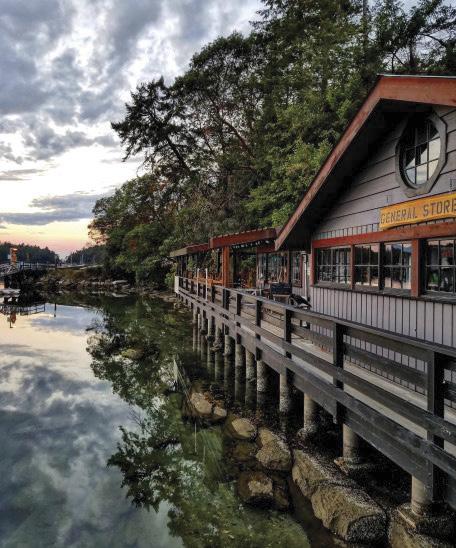





There are over 70 species of rockfish in the North Pacific and 37 species are caught in BC fisheries. Rockfish and lingcod are amongst the finest eating fish in the sea, but unfortunately their numbers are depressed in many areas because of overharvest. Stock recovery is further complicated since most are long lived species with slow reproductive replacement rates.
Rockfish suffer from barotrauma, the inability to equalize pressure quickly, when they are reeled to the surface. Few brought up from deep water survive until pressure equalizing descender devices became mandatory for rockfish angling.
Jigging is the standard rockfish/ lingcod tactic. Locate reef structure with steep drop-offs on multiple sides, and choose the jig weight according to the deepest water to be fished. Jig during very slow currents starting on the shallowest part of the reef, then periodically tap the reef to keep the jig in close proximity with it.
Use stiff rods, non-stretch minimum 50-pound test mainlines, short, lighterstrength leaders and jigs with up-eye, snag-less or light wire hooks to minimize hang ups. Once the current pushes you off the reef repeat the process on a different part of the slope. This is a simple and inexpensive way to introduce family and friends to fishing.
Forget your troubles aboard this French-built luxury cruiser

IIt was one of those perfect summer days, made so by bright sunshine and a cooling eight-knot breeze. I boarded the new Prestige 420 Fly at Mosquito Creek Marina with M&P yacht broker Kolby Vaughan and M&P’s director of customer experience Serena Torresan. It was a day meant to be spent on the flybridge and so we did. Kolby guided us expertly out of the marina and into the lightly rippled waters of Burrard Inlet.
Prestige is the luxury motor yacht brand of France’s huge Beneteau Group. The Prestige brand was created by Jeanneau (now a brand of the Beneteau Group) in 1989 and all subsequent models have been designed by Italy-based Garroni Design and built in France. Prestige offers three lines of sedan and flybridge yachts from 42 to 70 feet (12.8 to 21.3 metres), and a new power catamaran line.
The 420 is the smallest in Prestige’s F (flybridge) Line. The test boat is the second iteration of the 420 which was first introduced in 2015 and updated in 2020. Despite its size, the 420 Fly has a lot of bigger boat features. It is powered by twin Cummins 425-horsepower V-drive diesels (twin 380-horsepower Cummins are also an option) that offer top speeds of 30 knots. The V-drives help keep the weight far aft and allow for more space in the master cabin than the previously standard Volvo-Penta IPS drives. A Glendinning joystick tied to the engines and the proportional bow







thruster allow manoeuvring almost as precise as IPS joysticks. I was impressed with the smooth shifting when engaging the joystick. There was none of that clunking of the transmissions like in earlier joystick models.
Another departure from the 2015 version is that the private staircase from the saloon to the full beam master has been eliminated to provide more saloon space and both staterooms are now accessed via the staircase forward of the saloon.

FLYBRIDGE Driving from the portside flybridge helm offers excellent visibility all around, and most importantly, over the bow when coming up onto the plane. The test boat had a sweet looking optional hardtop to provide protection from the rain and sun.

Next to the helm are two sunpads with adjustable backrests, while aft is a cosy L-shaped lounge seat and table and an adjacent summer kitchen with fridge, grill and sink. The flybridge sweeps aft and partially covers the cockpit. While the sunpads are great for sunning and relaxing, in my mind they don’t make good companion seats because the companion must be stretched out on the sunpad.
COCKPIT Teak steps from the flybridge lead down to the cockpit with its L-shaped settee and access under the sole to the engine room. A starboard-side cockpit steering station, with simple thruster and throttles/ shifter should make docking a snap. A storage compartment in the transom can also be accessed from under the
settee and has good storage. The swim platform is surprisingly large with access to the cockpit from the port side. Four sliding glass doors provide access to the saloon. They can be configured to slide fully to port or starboard. The latter configuration opens to provide access to the galley countertop.
BOW Ten-inch-wide (24-centimetre) side decks and well-placed handrails on the bulwarks and cabin sides made it safe and easy to move fore and aft. The bow is highlighted by a threepanel sunpad with adjustable backrests and the usual windlass, anchor, roller and double chain locker, plus freshwater and saltwater washdowns. One nifty idea here is hinged stainless fender holders that flip up and out of the way when not needed.
THE SALOON The interior is very clean and modern, perhaps European in styling, with flat surfaces and angles instead of curves. It is clean and elegant with just over six feet (193 centimetres) of headroom. In my mind, aft galleys work best as they are central to both the interior and cockpit. Galley equipment includes a two-burner induction cooktop and microwave. Across is a drawer fridge and drawer freezer and separate bar fridge. A large countertop should provide ample space for serving and food prep. Overhead cupboards provide good storage. Forward is a linear sofa that faces the U-shaped dinette with an adjustable, folding table which drops down electrically to be either a coffee table or a third berth. A TV, hidden under the portside dashboard, flips up to face aft.
It is curious that the fixed helm seat is not adjustable (the flybridge seat slides fore and aft). This would save the helmsperson having to lean slightly forward to steer and adjust the throttles. An opening window next to the helm is a nice feature for ventilation. The console was fitted with two 12-inch Garmin touch screens. The Cummins digital instrument panel and the trim tab controls were located on the flat portion under the touch screens and to read them, one must stand up, which is somewhat awkward. Otherwise, the helm station is nice and clean.
ACCOMMODATION The accommodation area, down four steps from the saloon, is well laid out with the full beam master, forward stateroom and two en suites with raised vessel sinks and separate showers. The design is quite modern and clean with tasteful colours and cabinetry and again, with angled surfaces instead of curves.
While some full beam masters elect for a chaise lounge on one side and a bank of drawers on the other, the 420 has drawers on both sides of the double bed, providing plenty of storage in addition to a hanging locker forward.
There is decent headroom—71 inches (180 centimetres)—on both sides of the bed, but lower headroom over the berth means one must duck when getting into bed. This isn’t unusual with the saloon overhead. Big hull windows bring in light and wide views outside.
The forward stateroom also boasts large hull windows, hanging lockers and drawer storage. The only fault I could find below was that both the master and guest stateroom have charging ports on only one side of the bed. For comfort, reverse cycle air (powered by a 7.5 kw Cummins generator) provides both heat and cooling.
The guest en suite is also the day head and both are tastefully finished and of ample size for a vessel of this size, both with large showers that have doors that fit well (which isn’t always the case) and opening ports for ventilation.
UNDERWAY With the three of us and half fuel and full water tanks, we spent a few hours zooming around Burrard Inlet, careful to avoid the beefy tugs and other shipping traffic in the busy harbour. We accelerated impressively onto the plane in 7.5 seconds at just under 12 knots. Those two 425-horsepower diesels provided excellent performance and even from a high cruise to wide-open-throttle, there was still plenty of power and acceleration. The steering was tight and we leaned nicely into sharp turns. We accelerated from a dead stop to the plane with both the automatic Zipwake trim tabs on and off and found that the auto setting, not surprisingly, brought the bow down about five seconds faster than with no trim tabs. Either way, the visibility over the bow was good. We found a good displacement cruising speed was nine knots (1,350 rpm) using 6.6 gallons per hour (25 litres). A slow cruise on the plane was 16 knots (2,100 rpm) burning 20 gallons per hour. A fast cruise was 21.5 knots (2,450 rpm) burning 26.4 gallons per hour (100 litres). Noise in the
cabin was a quiet 64 dB. While these aren’t trawler fuel numbers, they are surprisingly reasonable for a vessel of this size with this much horsepower. At a cruise of 22 knots owners can expect a range of just over 200 miles—plenty for around here. Wide-open-throttle gave us a top speed of 30.5 knots at 3,100 rpm.
The Prestige 420 Fly is a well-designed, well-finished and well-performing yacht that can quickly get owners where they want to go. It was also fun and easy to operate—two big plusses. I would have liked an extended overnight cruise to evaluate it in even more detail, but that opportunity seldom presents itself when it comes to new boat reviews. However, some lucky owner is going to get to enjoy that experience, especially when it comes to those beautiful summer days or extended trips up the coast. Price as tested: $1,744,709.
SPECS
LOA 13.06 m / 42' 10"
Beam 4.1 m / 13' 5"
Draft 1.1 m / 3' 7"
Light Disp 10,400 kg / 22,928 lbs
Full load disp 14,837 kg / 32,710 lbs
Fuel 1,170 L / 309 USG
Water 425 L / 112 USG
Holding 120 L / 32 USG
Sold in Western Canada by M&P Yacht Centre Vancouver 604-692-0333
Sold in Washington State by Sundance Yacht Sales Seattle, 206-633-2850



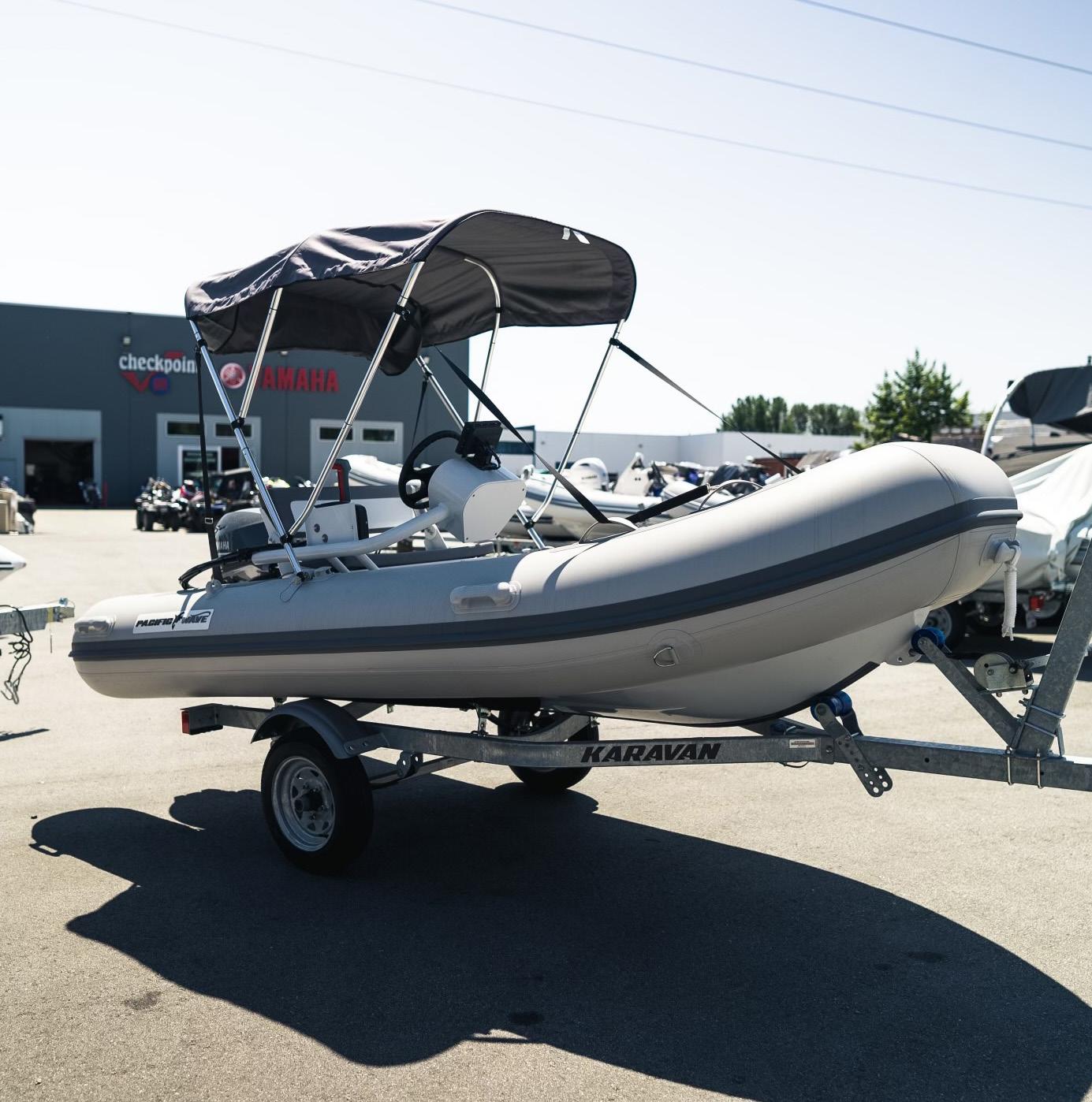


Life in coastal British Columbia is nothing short of spectacular. From the appealing mild weather to the stunning BC scenery dotted with quaint islands, lush forests and towering mountain ranges, we’ve got plenty to explore. But in order to fully take advantage of everything this beautiful province has to offer, you’re going to need a boat - and not just any boat.
Pursuit’s line of offshore boats are perfectly designed for exploring the coast of BC and its surroundings.
Their award-winning offshore boats are designed with comfort top of mind. Completely safe in the open ocean, these boats will allow you to live, work and relax for extended periods of time, both securely and enjoyably.

In this article, we’re going to highlight some of the key reasons to consider buying a Pursuit offshore boat for your weekend fishing trips, romantic island getaways, family day trips and everything in between.
along with an enclosed head with a stand-up shower.
But aside from the galley and head, which will provide you the functionality of home, Pursuit’s offshore boats also come standard with various entertainment options, from the JL Audio System to LED TVs.
One of the biggest selling points for Pursuit’s line of offshore boats is the comfort level, meticulously designed and built for weeks long and even months long trips. Ranging from 32 feet - 46 feet, the offshore line provides true live-aboard space for you and your passengers.
In each model, you’ll find berths in either the forward or aft sections (or both), which will allow 2-4 people to sleep comfortably. You’ll also find a fully functional galley complete with maple cabinets, a glass cooktop, microwave and stainless-steel refrigerator,
Everything from the complete functionality down to the specially crafted upholstery will ensure you’re truly equipped for long, comfortable trips in a Pursuit offshore boat.
If you’re passionate about fishing or curious about diving into the hobby, coastal BC is an excellent place to be. And with a Pursuit offshore boat, you’ll have all the capability you’ll need. Like all Pursuit models, the offshore line comes standard with plenty of rod holders, live wells, fish boxes, tackle storage and cabin rod storage space. To learn more, check the specifications that are available with each Pursuit offshore model
Along with specific features designed for fishing, there are other aspects of the Pursuit offshore models that make them ideal for fishing. Standard in every model is an anchoring system, bow thruster and dedicated transducer location. There are also safety features built in that can go a long way when fishing, such as grab rails and anti-slip cockpit flooring.
The Pursuit offshore series are highly functional boats designed for fishing and longer trips with family and friends. But that doesn’t mean that anything has been sacrificed when it
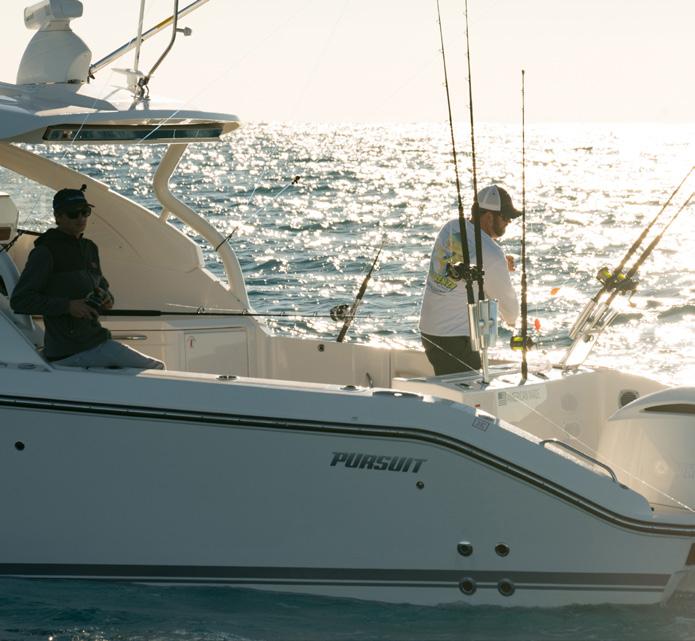
comes to style and design. Front to back and top to bottom, the offshore series is beautifully designed and meticulously crafted.
Console, Centre Console or Sport, they like to say every Pursuit Boat is ‘purpose-built’.

While the term ‘purpose-built’ is usually applied to necessity, Pursuit boats are built with a very different purpose in mind - for romantic weekend getaways, beach days with the family and fishing expeditions with your friends. The purpose is bliss. And it’s evident in every stitch, fixture and surface.
of 30 mph and a fuel tank capacity of 370 gallons.
Every model features a hand-laminated hull and moulded frameless tempered glass windows. When you custom order a Pursuit boat, you’ll have your choice of hull, helm, boot stripe and interior colour packages. And when you head down into the cabin, you’ll notice no detail has been left out. From the stainless steel and countertops to the upholstery to the luxurious head, the Pursuit offshore line exemplifies beauty in the details.

But you don’t have to take our word for it. Pursuit is willing to put their money where their mouth is with the Pursuit Protection Plan. Regardless of which model you end up purchasing, each Pursuit boat comes standard with:
• 5-year hull/deck structural warranty
• 5-year blister-free warranty
• 2-year limited warranty
As a new Pursuit boat owner, the Pursuit Protection Plan goes a long way in providing you with real peace of mind. After all, it’s a big investment. And you can rest easy knowing the manufacturer has your back.
Along with being one of the largest full-service marinas in the province, Van Isle Marina is proud to be the exclusive dealer of Pursuit Boats in Western Canada. So if you’re looking to purchase a Pursuit yacht, you’re in the right place. At our docks right now, we have a selection of both the OS325 and OS355 models.
The OS355 model is the midsize offshore model at 38 feet, powered by triple Yamaha engines for an extra kick. This model sleeps four with a little more seating and storage, and a larger galley, TV and live well.

When it comes time to actually purchase your new boat, Van Isle Marina can provide some real peace of mind. Apart from our highly experienced Yacht Sales team, we offer the full collection of vessel documentation services, including:
• Title & Lien Search
• Closing Statement
• Transfer of Funds
• Bill of Sale
• License Transfer
• Casual Remittance Return Form
For decades, Pursuit has been committed to designing and building high quality offshore boats. Whether you’re buying an offshore boat or a model from one of their other lines like Dual
The OS325 model is the smallest model in the offshore collection at 34 feet, but it is every bit of stylish and will comfortably sleep two guests. You’ll still find the hardwood, sleek stainless steel and LED TV. It’s got twin Yamaha F300 engines that give you cruising speeds
To browse our collection of Pursuit offshore boats, come visit our docks at Van Isle Marina. Located at 2320 Harbour Road in Sidney in Tsehum Harbour, our marina is just minutes away from the BC Ferries Swartz Bay terminal and the Victoria International Airport. Reach us by phone at 250-656-1138 or by email at info@vanislemarina.com.
Greg Andrew, CPYB
Yacht Broker & New Sales gandrew@vanislemarina.com





Adam Pedersen
Yacht Broker & New Sales apedersen@vanislemarina.com




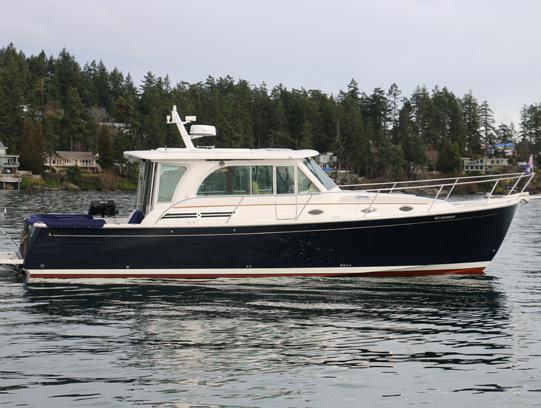
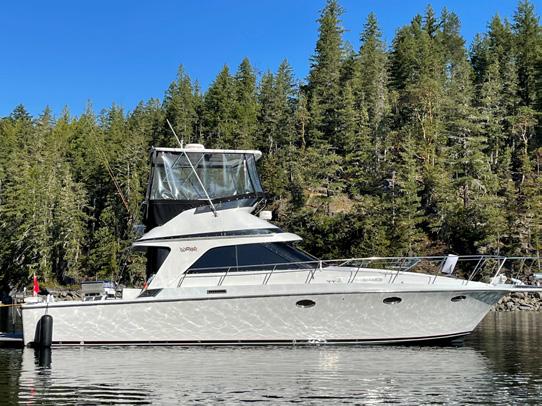





Nynke Plouffe
Yacht Sales Coordinator


nplouffe@vanislemarina.com

Sidney, BC | 250 656 1138
vanislemarina.com







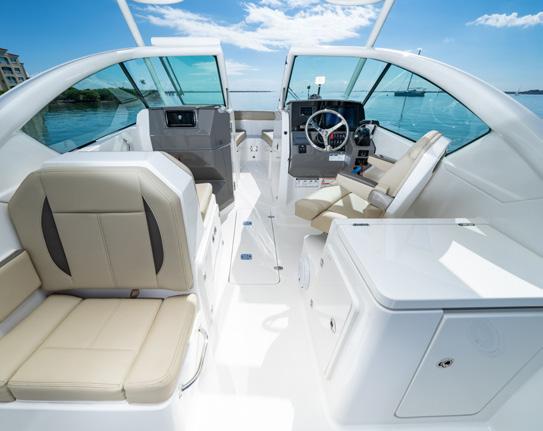



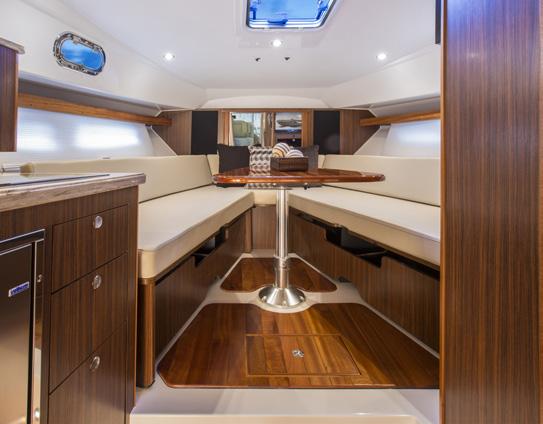
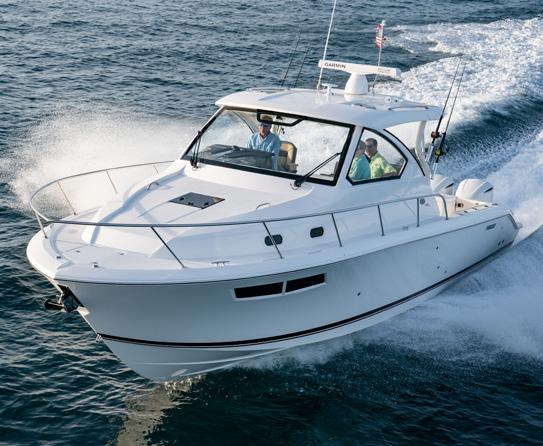



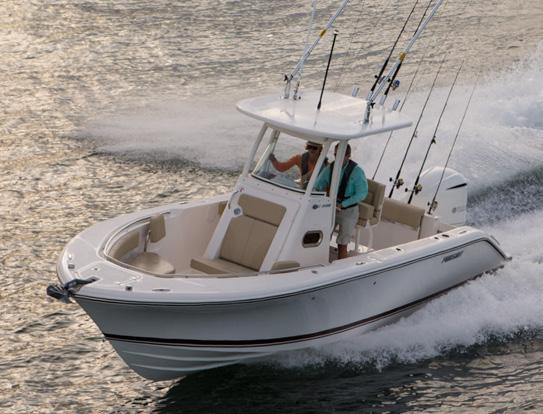


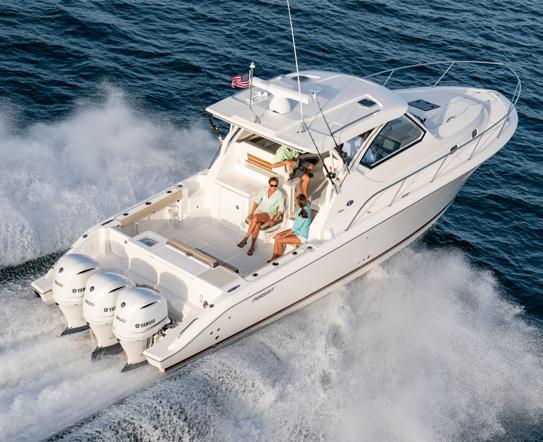


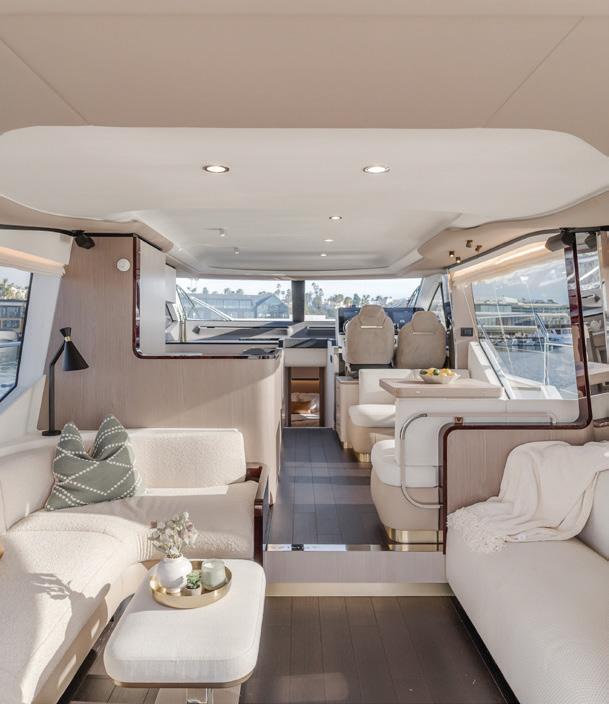























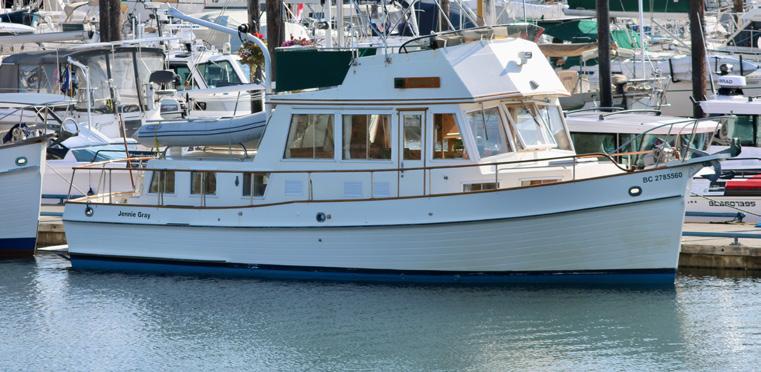


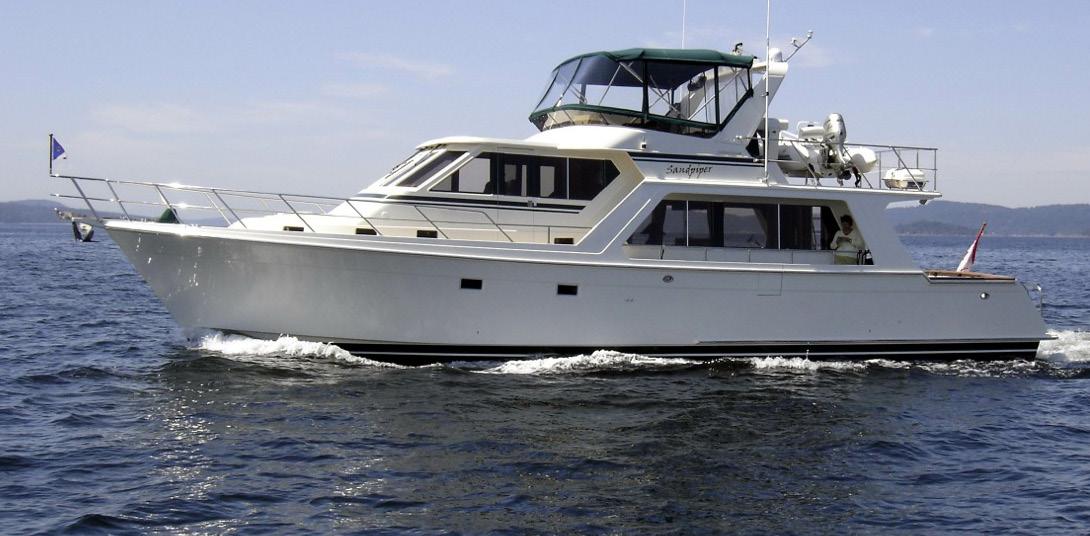




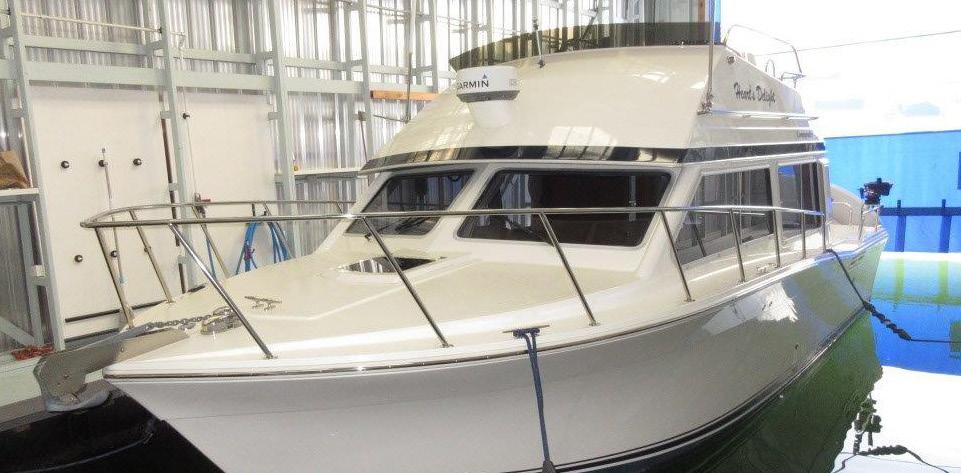


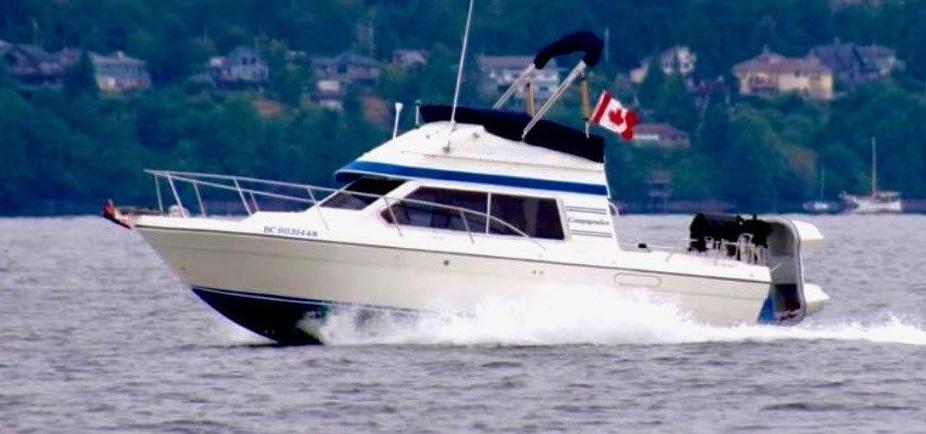
















The all-new F65 boasts a contemporary use of layout featuring the latest geometric design elements. Her contemporary flybridge is the perfect outdoor entertaining area, with ergonomic dining seating, wetbar with barbecue, coolbox and sink, plus an aft sunbed and L-shaped companion seat with infill as a secondary sunbed.

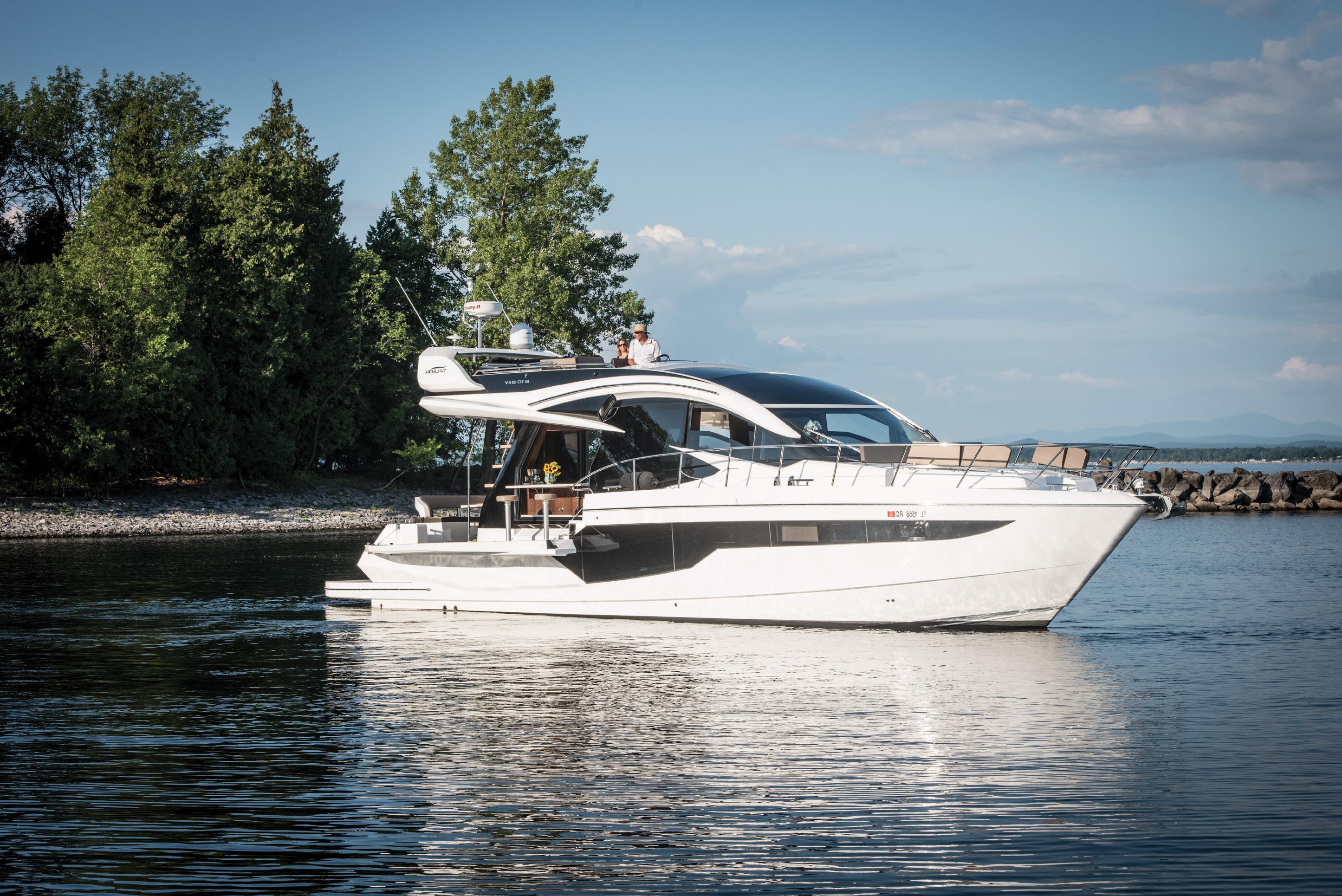



 Princess F65
Princess F65









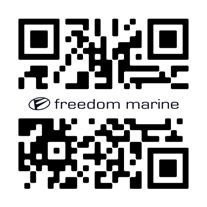











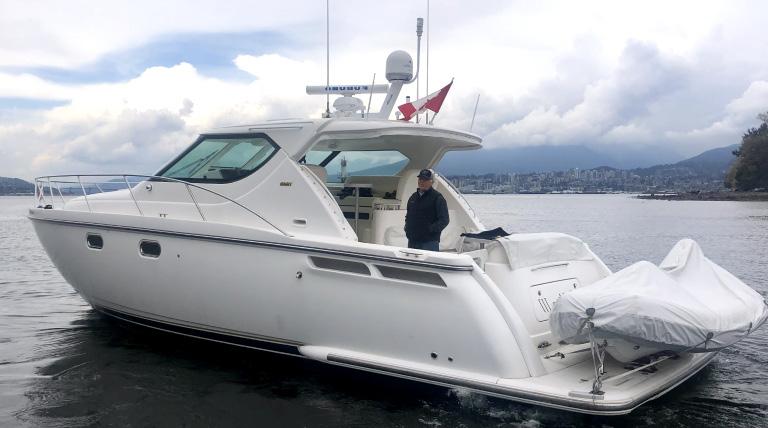














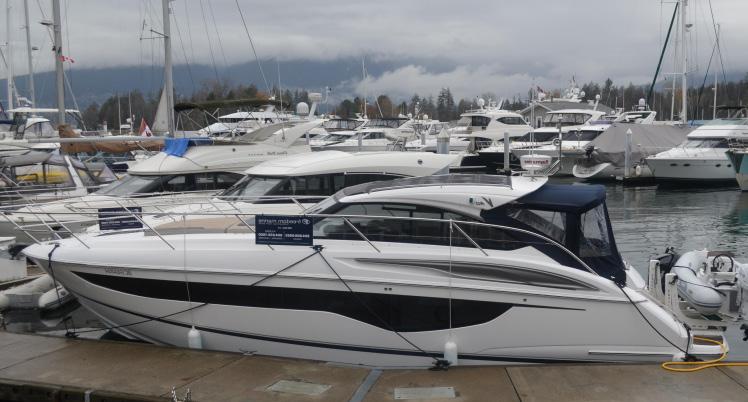




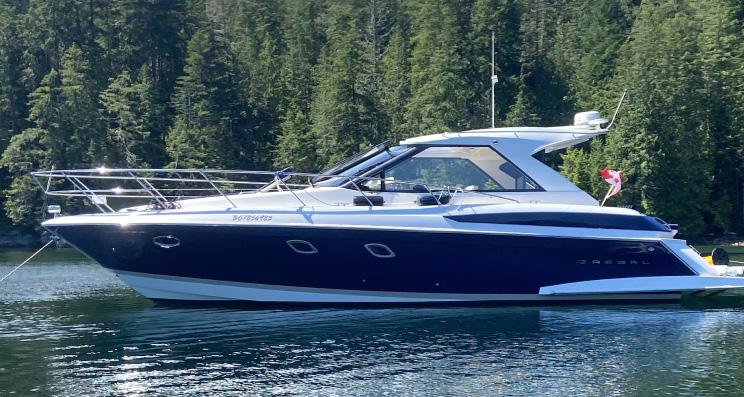


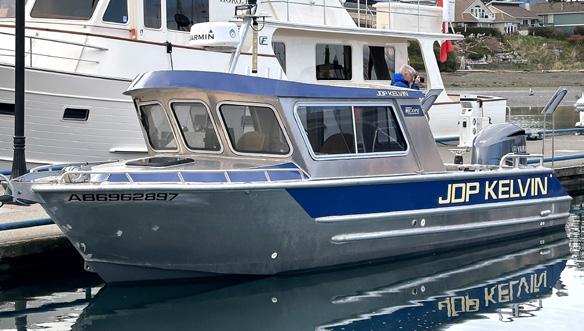

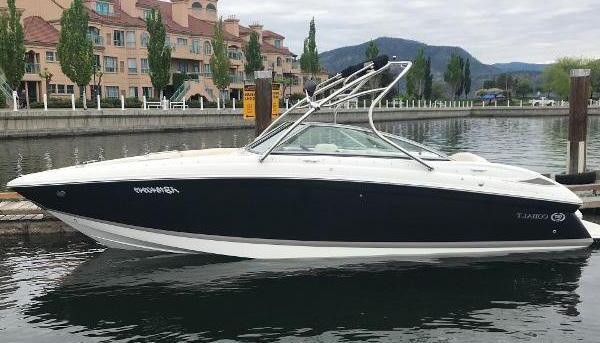

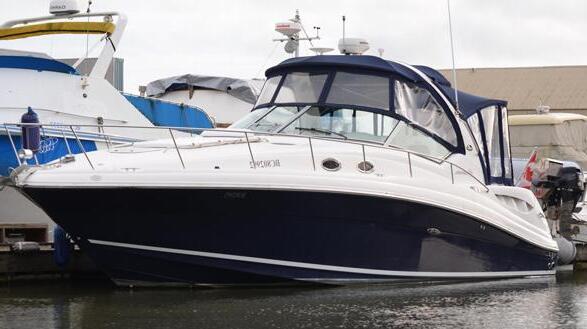








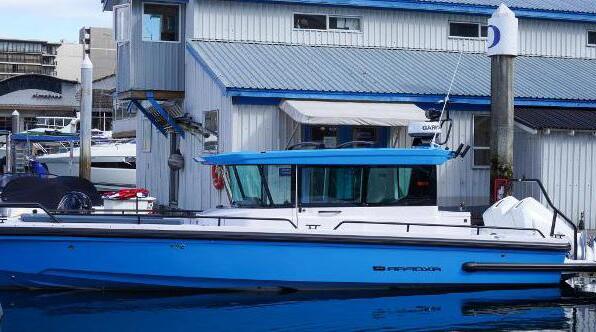






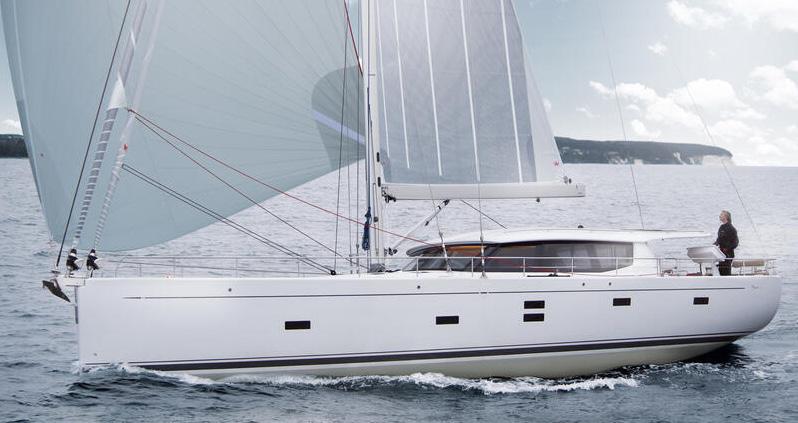






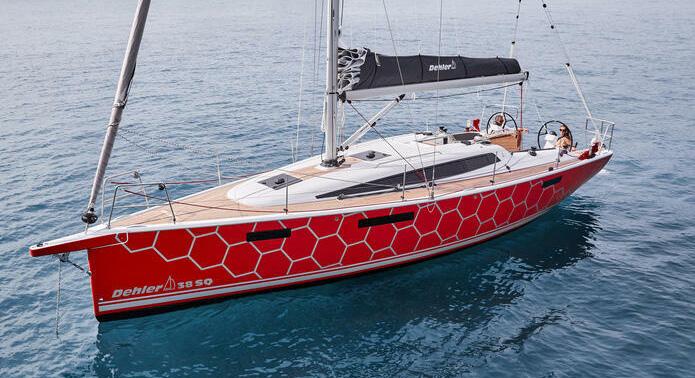



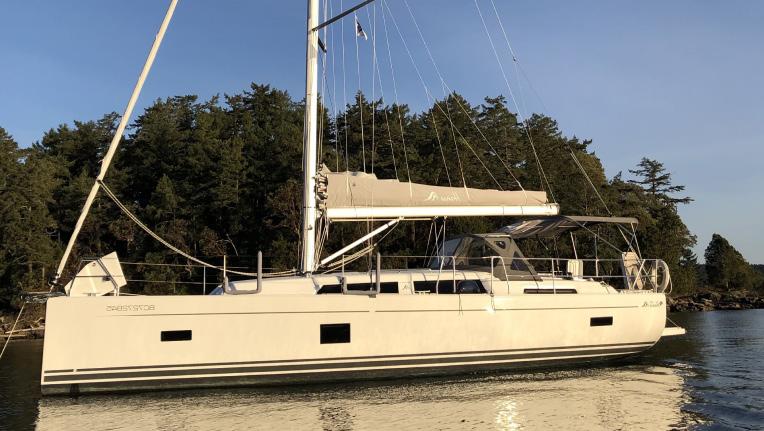



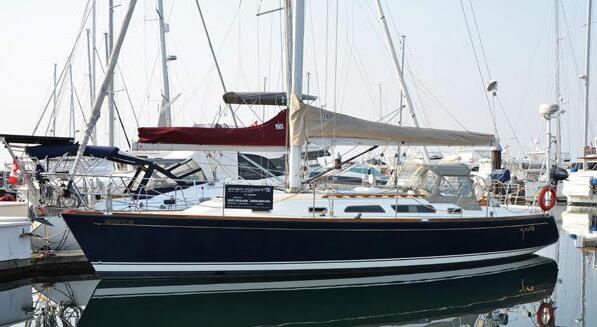




LIST YOUR VESSEL WITH US. WE HAVE TWO HIGH VISIBILITY SALES DOCKS



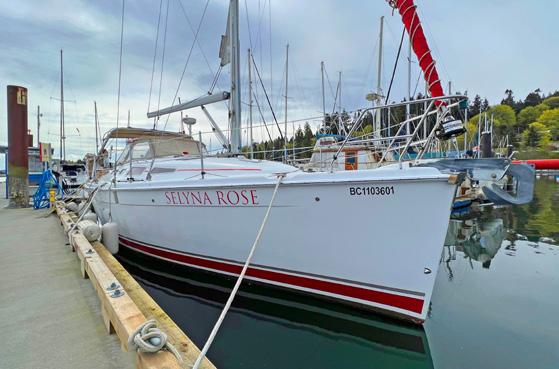




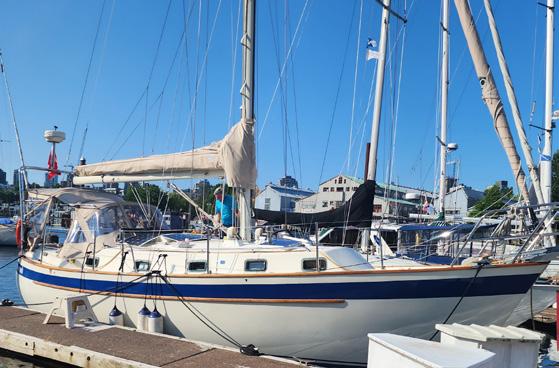






Granville Island
T: 604-488-1202
 DUFOUR 360 ON DISPLAY AT OUR DOCKS
BAVARIA R40 FLY ON DISPLAY AT OUR DOCKS
BAVARIA C45, BAVARIA C42, BAVARIA VISION 42 ON DISPLAY AT OUR DOCKS
DUFOUR 390 ON DISPLAY AT OUR DOCKS
1988 COAST 34 ASKING: $92,000
1980 BLUE WATER INGRID 38 ASKING:$115,000
2021 BAVARIA R40 COUPE ASKING:$845,000
DUFOUR 360 ON DISPLAY AT OUR DOCKS
BAVARIA R40 FLY ON DISPLAY AT OUR DOCKS
BAVARIA C45, BAVARIA C42, BAVARIA VISION 42 ON DISPLAY AT OUR DOCKS
DUFOUR 390 ON DISPLAY AT OUR DOCKS
1988 COAST 34 ASKING: $92,000
1980 BLUE WATER INGRID 38 ASKING:$115,000
2021 BAVARIA R40 COUPE ASKING:$845,000
Beautifully finished interior, Massive upper Deck, Expansive covered Cockpit, Three station helm control, Twin Volvo Diesel, Northern Lights Genset, Watermaker, Large swim grid with Seawise Davit system, Sat Dome, Raymarine Hybrid Touch, Hurricane Hydronic Heat


Perfectly suited for Coastal Cruising $465,000 USD







This Well Equipped Yacht has ample room to Live and Entertain Autopilot, Bow Thruster, A/C Heat, 20 KW Genset, Cameras... Too many features to list! Contact Larry Thompson to view. $475,000 CAD




Stunning Hanse with meticulous owners!

Owner has a custom King size bed in master plus two staterooms Upgraded electrical system, Victron Energy with Smart Control Dual steering, 53 HP Volvo engine, Lewmar bow thruster Contact Larry Thompson to view $419,900






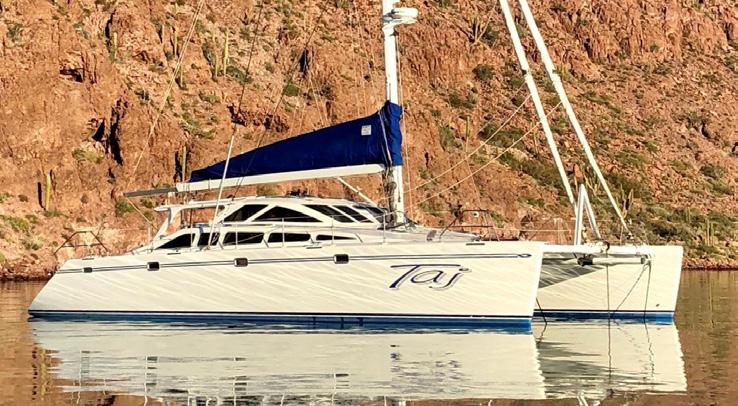












BENETEAU 47,












- This Beneteau has three state rooms, full spectrum of electronics, and a very well kept interior. Paired with 10’ ZAR RIB, two Zodiac open sea life rafts. Many additional




CAD
CAD
Beautiful custom aluminum DC bowrider designed by Greg Marshal, launched in 2022. Volvo D4-270,16” Simrad Nevo multi-function, removable hardtop, Shockwave seats, enclosed head. $299,000 CAD

GARTSIDE
- An exquisitely detailed west coast pilothouse, launched in 2020. Finest of materials used throughout inc. double planked red cedar/ epoxy hull. RAIN BEAR is a true gem that must be seen! NOW $345,000 CAD



A COMPLETE PACKAGE
• As new 2019 Dinette Edition
By
• 2021 Mercury 250xl’s / 150 hrs. (2026 warranty)
• Cockpit helm station
• Upgraded Simrad electronics package
• 16” & 9" Simrad plotters, autopilot
• Diesel furnace, vacu flush head
• 14,000 lb. triple axle ez loader trailer
$289,000 CAD





Since





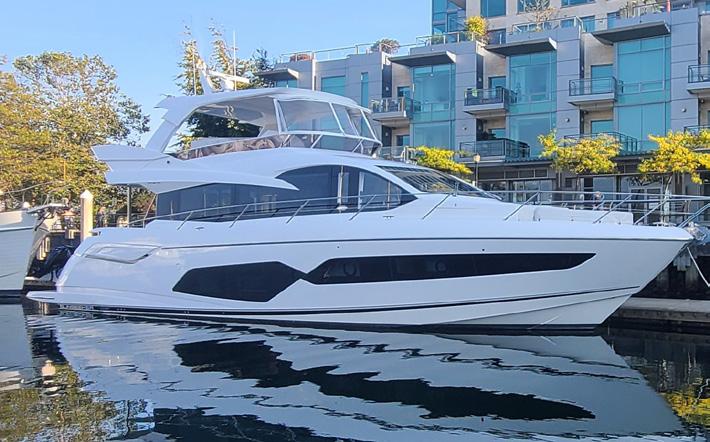



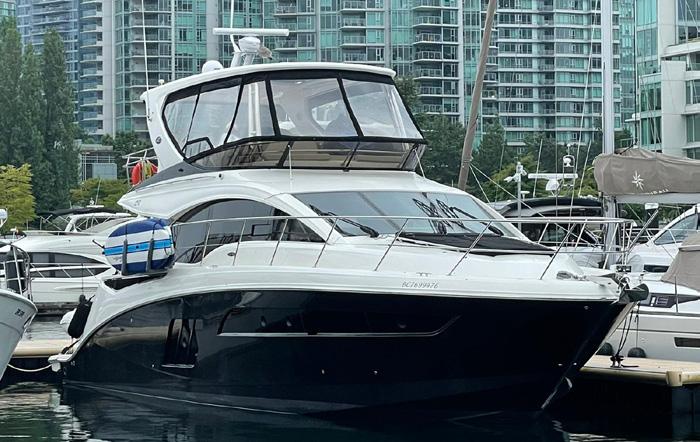











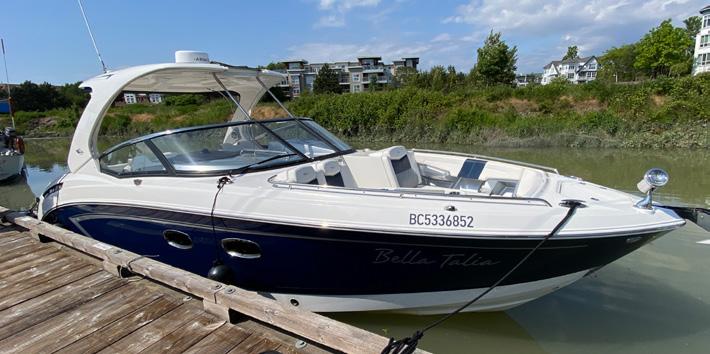
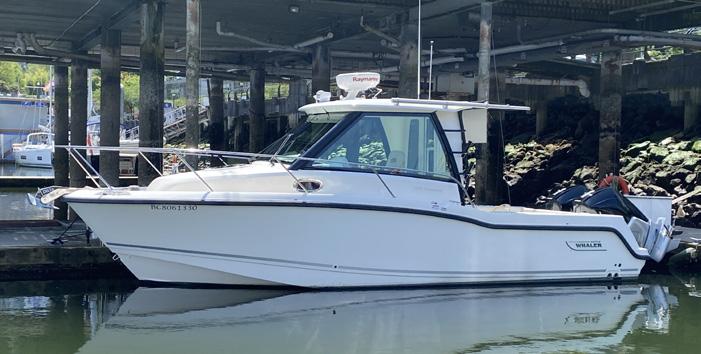

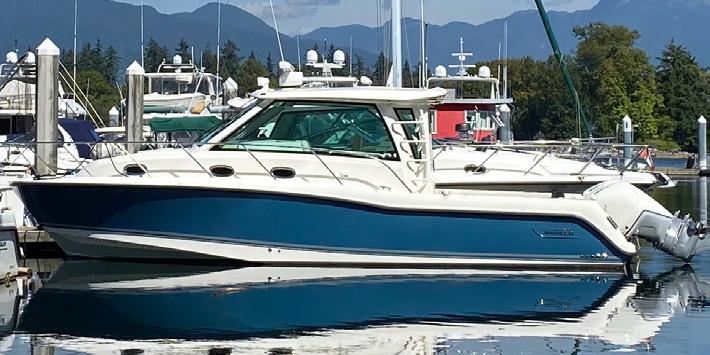






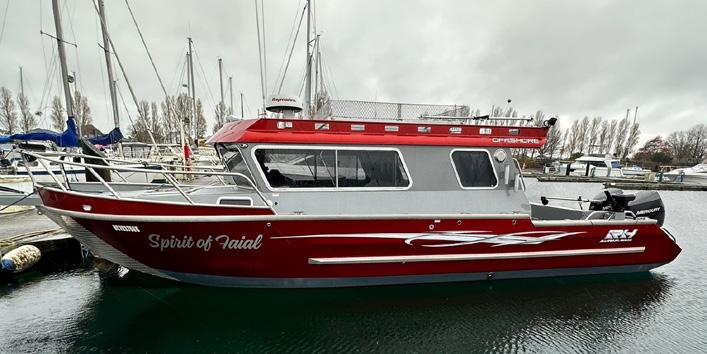

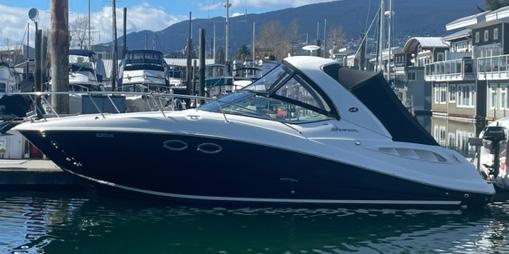

































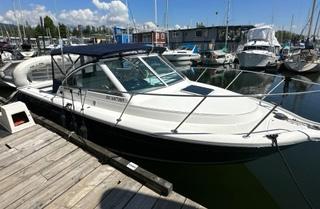











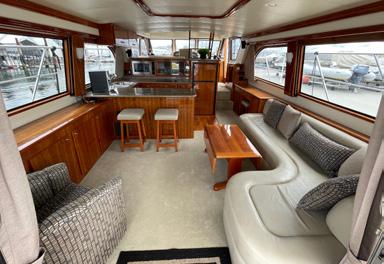

















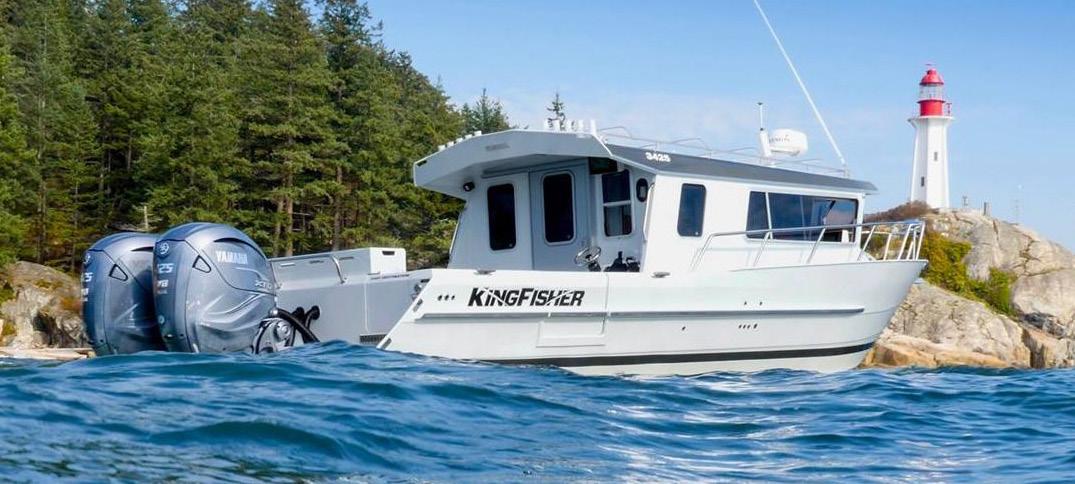







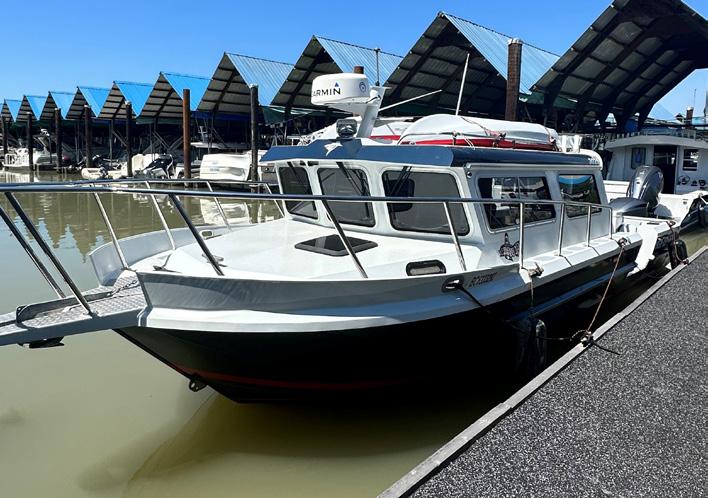















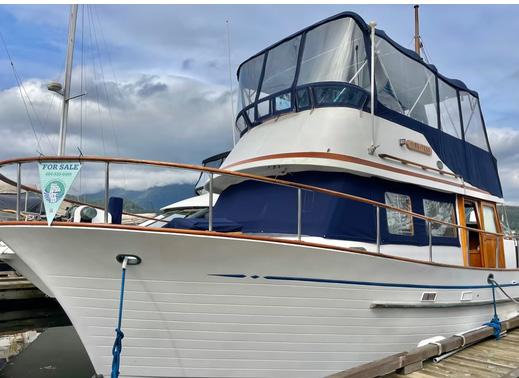






Sellers and buyers both benefit from a BCYCA member’s experience. BCYBA brokers assist buyers to find suitable boats in the local market or further afield in the international market. Similarly, they present locally owned boats for sale to local and international buyers.

Take the stress out of purchasing or selling your boat. A BCYBA broker is your guide through a successful transaction. They help in these ways:
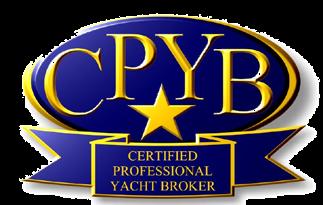
• Identify and evaluate yachts of interest.
• Provide experience in negotiating acceptable sale terms.
• Ensure your deposit stays in Canada.
• Outline vessel documentation, title, importation, insurance and taxation issues.
• Utilize strong working relationships with co-operating brokers, marine surveyors, marine mechanics, boatyards and other key industry contacts.
• Provide local follow up to help you in your boating adventures.






























WEST
30 acres with 2,000 ft of oceanfront and 300 ft of beach in Cachalot Inlet, Kyuquot Sound an awesome. West Coast Vancouver Island location for fishing camp or private retreat near BC’s best fishing, surfing and kayaking. Building site and road from beach are cleared. $600,000

RICHARD OSBORNE
Personal Real Estate Corporation
604-328-0848 rich@landquest.com
FERTILE RIVERFRONT ACREAGE WITH SUBDIVISION POTENTIAL - MABEL LAKE, BC
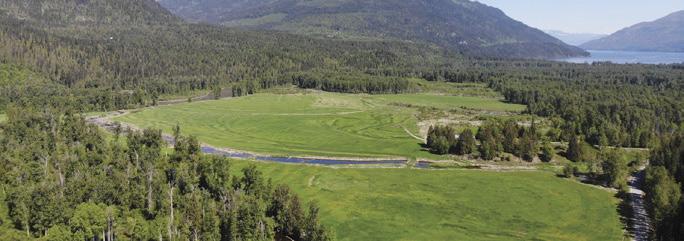

Scenic agriculture land a couple kilometres from Mabel Lake. 446 acres over 2 titles with 1.5 km on the Shuswap River, 100 acres of hay + an additional 20 acres cleared and ready to be seeded. 10,000 sq. ft. steel hay shed. 120± acres not in the ALR. Zoned for 18 acre lots. $2,750,000
RICHARD OSBORNE
Personal Real Estate Corporation
604-328-0848 rich@landquest.com

High density lakefront dev. site in Sicamous. Upland parcel 2.55 acres zoned for multi-unit structure. Original plans & permits were taken out for 67 condo units each with marina slip. Remaining from this unbuilt venture is a 62,000 sq. ft. concrete parking garage with 162 stalls. Foreshore area / marina is on Sicamous Narrows, a busy & popular boating route on the Shuswap Lake system. $3,999,000

RICHARD OSBORNE
Personal Real Estate Corporation

604-328-0848 rich@landquest.com
OCEANFRONT PARADISE PORCHER ISLAND
This is some of the finest oceanfront on the north coast of BC with beautiful views over Chatham Sound and over 1.7 km of oceanfront including an ecologically rich estuary, point, and a massive sandy beach that is a half a km wide! Some of the most breathtaking sunsets to be seen. $799,000
MATT CAMERON 250-200-1199 matt@landquest.com
OCEANFRONT PARADISE WITH ENDLESS POSSIBILITIES ON PORCHER ISLAND
114 acres with 1,500± ft of southern exposed oceanfront near Oona River. Includes main house, 6 guest cabins with revenue potential, shop, boat house all serviced by power, water and septic. Also includes large list of machinery and equipment. $1,500,000

JAMIE ZROBACK 1-604-483-1605 jamie@landquest.com
JASON ZROBACK 1-604-414-5577 jason@landquest.com
BC LANDPRO GROUP
OCEANFRONT HOME OCEAN FALLS, BC - CENTRAL COAST
Location Location Location! This home is perfectly appointed with amazing views, overlooking the ocean and Cousins Inlet. You can kayak, swim, paddle or go fishing right from your back door. $228,000
FAWN GUNDERSON
Personal Real Estate Corporation 250-982-2314 fawn@landquest.com

PHILLIPS ARM AT THE ENTRANCE TO CORDERO CHANNEL
180 acres with approx. 6,400 ft of quality oceanfront at the entrance to Cordero Channel across from Shoal Bay. The property faces southwest with excellent sun exposure and has a fantastic maturing forest and year-round creek. This is a trophy oceanfront property in a prime location on the BC coast. $979,000
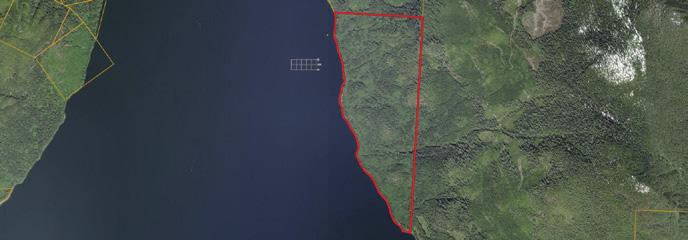
JASON ZROBACK 1-604-414-5577 jason@landquest.com
JAMIE ZROBACK 1-604-483-1605 jamie@landquest.com
BC LANDPRO GROUP
PRIVATE FLOATING LODGE TLUPANA INLET NOOTKA SOUND, BC
Turnkey private floating fishing lodge in secluded, sheltered Critter Cove, Nootka Sound, West Coast of Vancouver Island, one of BC’s best fishing areas. Well maintained, fully equipped, furnished and ready to go. Jump in your boat and go fishing. $950,000


JASON ZROBACK 1-604-414-5577 jason@landquest.com
JAMIE ZROBACK 1-604-483-1605 jamie@landquest.com
BC LANDPRO GROUP
OFF-GRID RETREAT AND RECREATIONAL OASIS - NELSON ISLAND
The Quarrybbean is a gem on a 2.5 acre lot in a rare bare land strata. There are 250 acres of common land that include 2 lakes and miles of trails. 2 solar powered buildings with 5 bedrooms, 4 bathrooms, decks galore and stunning views. Includes a hillside elevator, large wharf patio and deep-sea moorage. $2,198,000
JAMIE ZROBACK 1-604-483-1605 jamie@landquest.com
JASON ZROBACK 1-604-414-5577 jason@landquest.com
BC LANDPRO GROUP
1.9
300 ft of low bank waterfront with 2,761 sq. ft. log home featuring vaulted ceilings, large country kitchen and 3 bdrms with ensuites. Fenced backyard has workshop, garage, woodshed, plunge pool, gardens and gated stairway leading to the beach. Stunning views of Hornby Island and Lambert Channel! $899,000
JAMIE ZROBACK 1-604-483-1605 jamie@landquest.com
JASON ZROBACK 1-604-414-5577 jason@landquest.com
BC LANDPRO GROUP
LARGE TREED RIVERFRONT ACREAGE ON THE SKEENA RIVER - TERRACE, BC


80 acres separated into 2 parts by Alvin Creek. Road access to east side and boat / snowmobile access to the west side. Cottonwood with pockets of merchantable spruce and cedar. Subject to spring flooding. Fertile soil. Perfect for someone with a Jetboat. $249,000
SAM HODSON Personal Real Estate Corporation 604-809-2616 sam@landquest.com
KOOTENAY LAKE WATERFRONT HOME & BEACH HOUSE - 2.27 ACRES - NELSON, BC
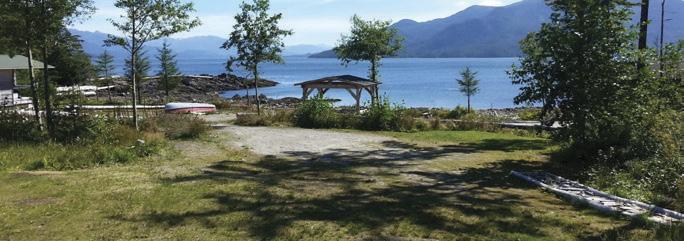

Welcome to waterfront living! This 2.27 acre property has an extensive sandy beach and private dock. The beach house, carriage home, 3 RV hookups, massive workshop garage, large shop, and securely gated perimeter provide privacy, respite and fun! $1,995,000
JOHN ARMSTRONG Personal Real Estate Corporation 250-307-2100 john@landquest.com
Ultimate low-bank waterfront recreational getaway at sought after & rarely available Carlson Point!

One of the very best properties as the 3 bdrm cottage is perched beyond neighbours, offering great privacy!

• $699,000
Spectacular 3bed/2bath rancher situation on 0.75 acre oceanfront property with Western exposure,
Don't miss this custom built, brand new 4bed/4bath home in one of Madeira Park's loveliest & quietest locations, steps to Baker Beach, one of the area's finest!
Madeira Park • $1,850,000
Halfmoon
Immaculately maintained waterfront home on a quiet cul-de-sac in Halfmoon Bay! Spectacular ocean & island views are front & centre from this lovely

First time on the market, stunning private esplanade lakefront acreage! This is one of the last unobstructed & panoramic lake views & sunshine.
Very private low bank waterfront just mins to Sechelt! Easy access to the pristine beach from this 2,800+ sq.ft. recently reno’d Rancher with level entry access. Sechelt • $2,299,000
Very private low bank waterfront just mins to Sechelt! Easy access to the pristine beach from this


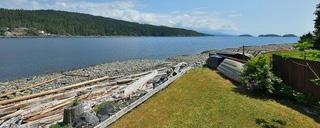





Immaculately maintained waterfront home! This lovely 3bed/2bath West Coast home is bright and sunny and offers spectacular ocean & island views.
Don’t miss this custom built, brand new home in one of Madeira Park’s loveliest & quietest locations, steps to Baker Beach, one of the area’s finest!
Halfmoon Bay • $1,800,000

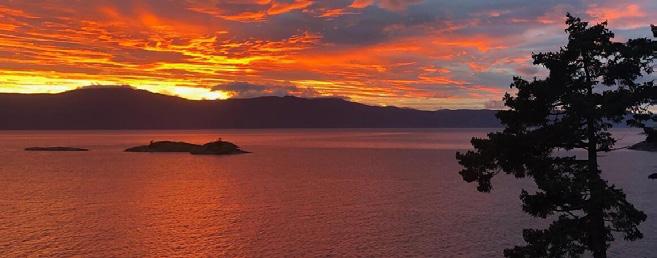
1st time on the market, this spectacular 5+ acre parklike setting at Ruby Lake features 2 separate homes & is the kind of property that sets a new pace the minute you arrive.

Halfmoon
Ruby Lake • $1,699,000

Gorgeous
Gorgeous waterfront home with easy access into the ocean for swimming or launching a kayak, as well as stunning, unobstructed ocean/ island views!
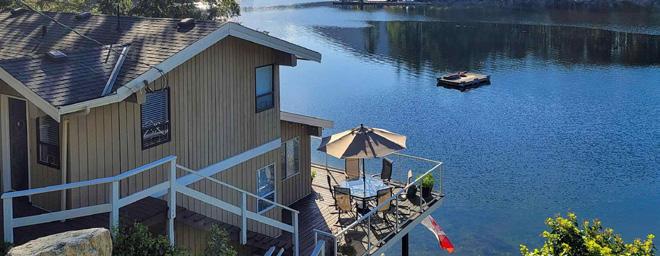
Garden
Garden Bay • $1,998,000
Pearse Island Oceanfront: 1 acre in Pearse Bay, with 560sqft cabin with loft and shared private moorage. SW exposure providing great views and sunsets. Forested, approx. 100ft waterfront. Popular recreational area in the Broughton region of Johnstone Strait. $299,500


$600,000
Active Shellfish Company: Nootka Sound Shellfish Limited: three shellfish tenures (oyster and clam) in Nootka Sound, all growing/harvesting equipment, and a 29ft skiff. Excellent business opportunity to work on the west coast of Vancouver Island. $299,900





Bradshaw
REAL ESTATE CORPORATION Sarah Bradshaw TOLL FREE 1.877.735.3292 250.285.3293 Bill Bradshaw
PERSONAL
Oceanfront
Surf Inlet, Princess Royal Island: 251.88 acres in four contiguous titles on the shores of Port Belmont at the head of Surf Inlet and on Cougar Lake, with oceanfront, lakefront and a historic dam, with water licenses and a foreshore lease. $3,500,000
West Coast Oceanfront: 3.56 Hot Springs development on Vancouver west coast. Nicely forested, diverse shoreline including a peninsula and bay. Protected location, southern exposure. Water access only. $159,900
PERSONAL
Bramham Island Oceanfront Acreage: Stunning 140 acre property on Slingsby Channel, BC central coast region. 6120ft oceanfront, frontage on 3 lakes, diverse topography. Complement of old growth and merchantable timber. Surrounded by Crown land. $2,450,000

110 acre private island in Esperanza Vancouver . Numerous little bays, peninsulas, and bluffs. Oneroom cabin plus workshop, fresh water ponds, complement of equipment. Quick access to the open west coast! $1,790,000

: 3.56 Hot Springs development on Vancouver west coast. Nicely forested, diverse shoreline 110 acre Esperanza Vancouver . Numerous little bays, peninsulas, and bluffs. Oneroom cabin plus workshop, Ed Handja Personal Real Estate
QUADRA ISLAND REAL ESTATE TEAM




Are you ready for island time?
Are you ready for island time?
Bill Bradshaw
PERSONAL REAL ESTATE CORPORATION

Sarah Bradshaw
Sarah Bradshaw
•6.5 acre lot located on northwest corner of Quadra Island•Comes with driveway into property, drilled well and hydro services to property line•In an area with great outdoor recreation: hiking, kayaking, sports fishing•Community wharf and boat ramp minutes away•Located 20 minutes from services in Heriot Bay
•6.5 acre lot located on northwest corner of Quadra Island•Comes with driveway into property, drilled well and hydro services to property line•In an area with great outdoor recreation: hiking, kayaking, sports fishing•Community wharf and boat ramp minutes away•Located 20 minutes from services in Heriot Bay
MLS # 398896 • $139,000
MLS # 398896 • $139,000
QUATHIASKI COVE OCEANVIEW RANCHER & RENTAL TRAILER
QUATHIASKI COVE OCEANVIEW RANCHER & RENTAL TRAILER
•Great ocean views of Quathiaski Cove and Discovery
•6.5 acre lot located on northwest corner of Quadra Island•Comes with driveway into property, drilled well and hydro services to property line•In an area with great outdoor recreation: hiking, kayaking, sports fishing•Community wharf and boat ramp minutes away•Located 20 minutes from services in Heriot Bay MLS # 398896 • $139,000
New Price! $668,000 MLS# 900495 New Listing! $669,000 MLS# 914258 New Price! $928,000 MLS# 905800 New Price! $999,000 MLS# 901410 Just Listed! $2,200,000 MLS# 915885
•6.5 acre lot located on northwest corner of Quadra Island•Comes with driveway into property, drilled well and hydro services to property line•In an area with great outdoor recreation: hiking, kayaking, sports fishing•Community wharf and boat ramp minutes away•Located 20 minutes from services in Heriot Bay MLS # 398896 • $139,000
QUATHIASKI COVE OCEANVIEW RANCHER & RENTAL TRAILER
Passage•Rancher is at foot of 0.41 acre lot next to ferry to Campbell River• Mature shrubs provide lots of privacy along front of home• Up the hill is a 2 bed room trailer currently rented out to long-term tenant
•Great ocean views of Quathiaski Cove and Discovery
Passage•Rancher is at foot of 0.41 acre lot next to ferry to Campbell River• Mature shrubs provide lots of privacy along front of home• Up the hill is a 2 bed room trailer currently rented out to long-term tenant
MLS# 398397 • $249,000
•Great ocean views of Quathiaski Cove and Discovery
DL364 Whiterock Pass guest cabin & workshop situated on a 22 acre oceanfront property! Incredible views across Whiterock Pass to Read Island and a newer commercial grade wharf.
•Shor t walk from all services in Quathiaski Cove
billbradshaw@royallepage.ca
sarahbradshaw@royallepage.ca www.quadrarealestate.ca
billbradshaw@royallepage.ca
sarahbradshaw@royallepage.ca
www.quadrarealestate.ca
Passage•Rancher is at foot of 0.41 acre lot next to ferry to Campbell River• Mature shrubs provide lots of privacy along front of home• Up the hill is a 2 bed room trailer currently rented out to long-term tenant


•Shor MLS# 398397 • $249,000
•Great ocean views of Quathiaski Cove and Discovery Passage•Rancher is at foot of 0.41 acre lot next to ferry to Campbell River• Mature shrubs provide lots of privacy along front of home• Up the hill is a 2 bed room trailer currently rented out to long-term tenant
•Shor t walk from all services in Quathiaski Cove MLS# 398397 • $249,000
billbradshaw@royallepage.ca | sarahbradshaw@royallepage.ca
billbradshaw@royallepage.ca
mountains!
sarahbradshaw@royallepage.ca
www.quadrarealestate.ca
www.quadrarealestate.ca
www.quadrarealestate.ca
QUATHIASKI COVE OCEANVIEW RANCHER & RENTAL TRAILER billbradshaw@royallepage.ca sarahbradshaw@royallepage.ca www.quadrarealestate.ca

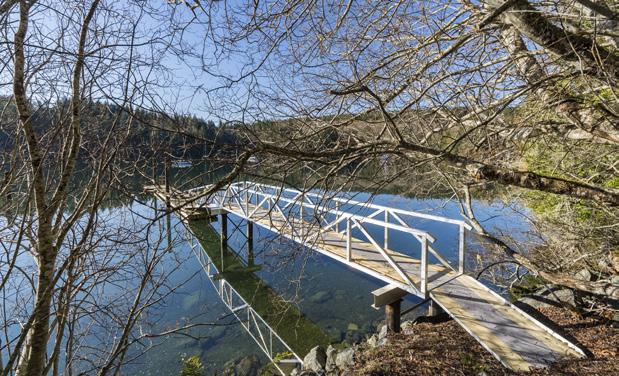

Idyllically set in a private two acres with just shy of 230 feet of sheltered ocean frontage, this rare south-facing waterfront home, built in the 1970s, has been extensively updated with new windows, eco-vinyl flooring throughout the principal rooms, updated kitchen with quality cabinetry and quartz countertops and much more. The Primary Bedroom and ensuite are conveniently located on the main floor, and there are 3 additional bedrooms upstairs and loads of storage. The walkout basement features a spacious family room with cozy fireplace and additional storage. With views from all three levels overlooking the serene, sheltered waters of Anderson Cove the property features a NEW sun-drenched dock with “All Weather Safe”, deep moorage and easy access to Juan de Fuca Strait. Generous foreshore assignment allows for further dock extension. Bring your kayaks, paddle boards and your yachts to enjoy a uniquely Westcoast lifestyle.
Price: $2,000,000 CAD








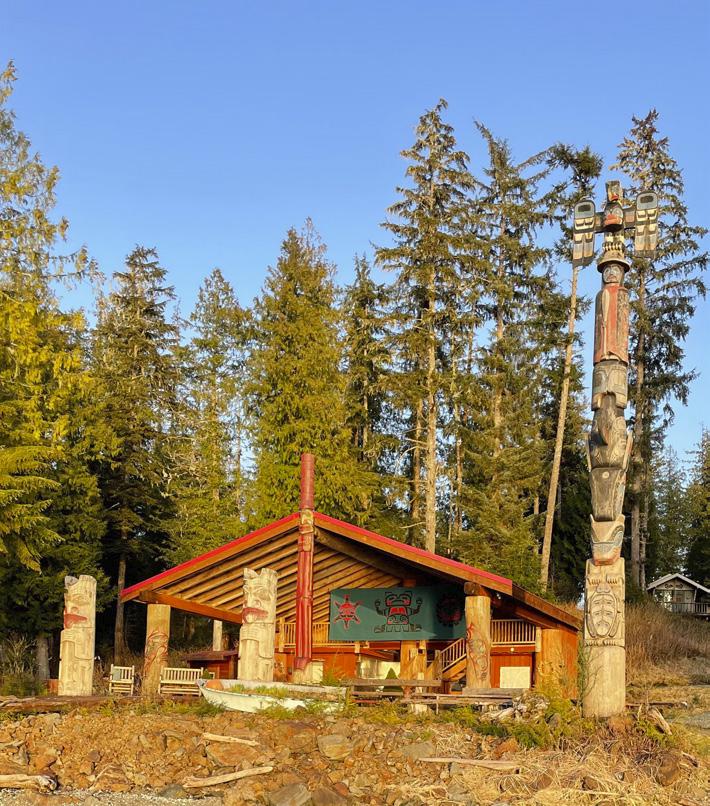




well-established roads, 200’ dock space, off grid solar, diesel backup, all furnishings and maintenance equipment included. $4,400,000 Email: saunders.island.mgt@gmail.com www.oceantribecharters.com


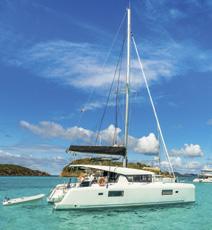





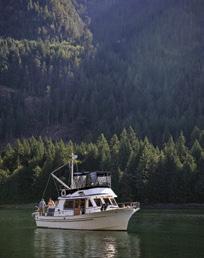
VALUE PACKED OCEANFRONT WITH MOORAGE $1,799,000




Custom design 2,800 sq. ft. 3 bed, 3 bath home with 1,800 sq. ft. no step main floor, lower floor 2 bedroom self-contained guest suite, 250 feet of ocean frontage, South West exposure, private, 180 degree views, sunsets, open floor plan, vaulted ceilings, granite counters and Bird’s Eye maple cabinetry.
MIKE HARDY


250-537-6445 mhardy@saltspringislandrealty.com






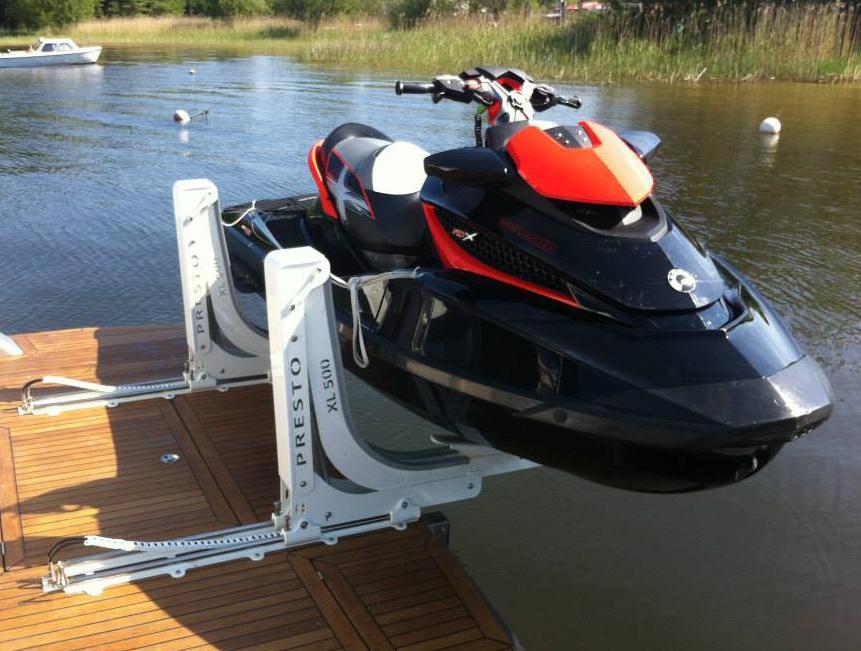



BRING IN YOUR UPHOLSTERY AT THE END OF THIS SEASON AND WE WILL STORE AND HAVE IT READY FOR NEXT SPRING




WE ALSO DO
Eagle Harbour Yacht Club based in West Vancouver, is seeking to hire an administrative assistant. This is a part time role, 15-20 hours per week, starting at $22/hour. We are looking for someone who compliments existing staff through assisting in administration matters, with additional development of communication strategies. Required to be customer service oriented, providing member support. Familiar and confident use of computers and cellphone apps, must be able to type. Knowledge of MS office suite, particularly Outlook and Word. Willing to become proficient in MS Office suite; Excel, Teams and other web based office solutions. Excellent communication skills both verbal and written and high attention to detail. Collaboration with Executive Administrator and Superintendent on regular basis and sailing coaches during the summer. Ownership of tasks and follow-up. Willingness and expectation to help where needed. Ownership of communications through website, social media, weekly newsletters and notice boards. Comfortable with posting and interacting on social media platform using Instagram and Facebook (from a business perspective). Co-ordination across all platforms. Developing surveys and analysing results to promote improved member experiences.





Ifinterested,pleasesendaresumeandcoverlettertoehyc@ehyc.org. Pleasenotethatonlythoseselectedforaninterviewwillbecontacted.


BOAT DONATIONS
2002 31’ Tiara
We make getting out of boat ownership a breeze. Donate your boat in support of our local community of sailors with disabilities and receive a tax receipt for its full market value.
We make getting out of boat ownership a breeze. Donate your boat in support of our local community of sailors with disabilities and receive a tax receipt for its full market value.






We call that a win-win.
We call that a win-win.
DELIVERIES
POWERBOAT, MOTORSAILOR DELIVERIES
Maine-Alaska (SE,Gulf,PWS), Panama, China. U.S. West Coast. Electronic Chartplotting, EXPERT: picking weather, bar crossings (2000+), wintertime, North Pacific. USCG Master. 45+ years experience Mike Maurice +1-503-310-7590 www.yachtsdelivered.com

TRADES & SERVICES


MARINE TITLES (CANADA) LTD. A complete Marine documentation and Licensing company. E-mail: marinetitlesltd@telus.net 400-1681 Chestnut St. Vancouver, B.C. V6J 4M6 Tel: 604-736-3377




1969 32’ Grand Banks Trawler


2021 35’ PURSUIT OS 355 – INSANE!, “AS NEW”, TWIN Yamaha XTO Digital 425’s (130 hours w/ 100 service complete), Joystick control, Fisher Panda Genset, Watermaker, Full Garmin Pack, Downriggers, AC/ Heat, Beautiful “Nautilus’ Interior - Save Over New!
2006 Carver 444 CMY, BOW & STERN THRUSTERS, LOW HOUR Volvo D6’s, Raymarine electronics, docking camera, two stateroom, two heads, TWO ESPAR diesel forced air heating (Flybridge/ Cockpit), A/C, heat, SAT TV, Genset, Inverter, All new batteries!

$187,000 CAD
$199,000 CAD
2005 Hunter 41DS (Deck Salon), WOW! Fantastic layout, HUGE SALON, Two Private cabins with ensuite heads, Yanmar, Deluxe Full Enclosure, Power Main Winch, SS Davits W/ Rib Tender Package - Great Alaska Vessel!













were standing on the side of the road, everyone giving their opinions on what to do next. The consensus was to release the bowline, engage reverse and push the stern out away from the rocky bank. Then engage forward and drive out of the canal, easy. As soon as we released the bowline, the current caught the bow and swung the boat viciously sideways, the chap gunned the engine in reverse and the boat shot backwards, coming dangerously close to the rocks on the far bank. Inches from disaster, the chap engaged forward and floored it! To my horror I realized he still had the leg in the raised position, and a 10-foot-tall rooster tail shot out the back. The bow went skyward, completely blocking his forward vision. Amazingly, the chap somehow got the bow pointing up the canal and heading for safe water—my heart was in my mouth. I prayed the engine didn’t cut out again. More throttle was applied, the bow went up even more and the stern pressed dangerously down into the water almost to the point of swamping. I couldn’t watch, but also couldn’t look away. The chap must have realized something was badly wrong and remembered to lower the leg. The bow came down and the crisis was averted. Back at my campsite, I settled into my camp chair, opened a cold one and reflected on what I had just witnessed. Something made me look up and I saw the black SUV towing the speedboat past the campsite, the chap still looked shocked, and the wife had that, “I told you this was a bad idea” look on her face. Welcome to the wonderful world of boating I thought to myself.


Have a funny or interesting story?



Cockpit Confession is a readersubmitted column and we are always looking for another good yarn. Send your 600-word story to editor@pacificyachting.com.






We’ll send you a T-shirt! This story was first published in February 2012.
On a recent overlanding trip, I stopped in for the night at a campground in Lillooet. In the evening I took my dog for a walk down the road, past the boat ramp and down to the beach on Seton Lake for a swim. After our dip, we were walking back past the boat ramp, where a black SUV was launching a 20-foot bowrider.
The boat ramp at Seton Lake has an interesting quirk: it’s located at the mouth of a 40 by 500-metre-long ca-
Onal that leads directly to the mouth of a BC Hydro dam spillway. The current rips down the canal at about seven or eight knots. So, I felt some alarm when I heard the chap in the speedboat yelling to his wife, “grab the rope!” I looked around and was shocked to see the speedboat’s engine had failed and the boat was spinning out of control down the canal heading for the mouth of the dam. I tethered my dog to the guardrail and jumped down the bank and was just able to grab “the rope” and get a couple of turns around a very small tree on the side of the bank. The tree bent and creaked under the strain, but luckily held the boat fast.
The chap in the boat looked rather pale. I asked what happened and he said the engine cutout after the launch. Now he tried the ignition several times and

the V8 inboard fired up. I suggested he gave it a minute to let it warm up and to let his nerves settle down. By this time his wife had joined me on the bank of the canal and was helping fend the boat off the rocks. She said they had just bought the boat the day before and this was their first time boating. As a lifelong boater myself, I’ve seen my fair share of engine failures, so I explained to them that this happens to everyone. It’s just part of owning a boat. I was hoping this lighthearted comment would put them at ease, but I don’t think it did, as the dam mouth spillway was only a couple of hundred metres behind us and the little tree they were tethered to was about to rip out of the bank.
By this time a few more people
Continued on page 121













